We are hiring! Severn Estuary Partnership Communications Officer
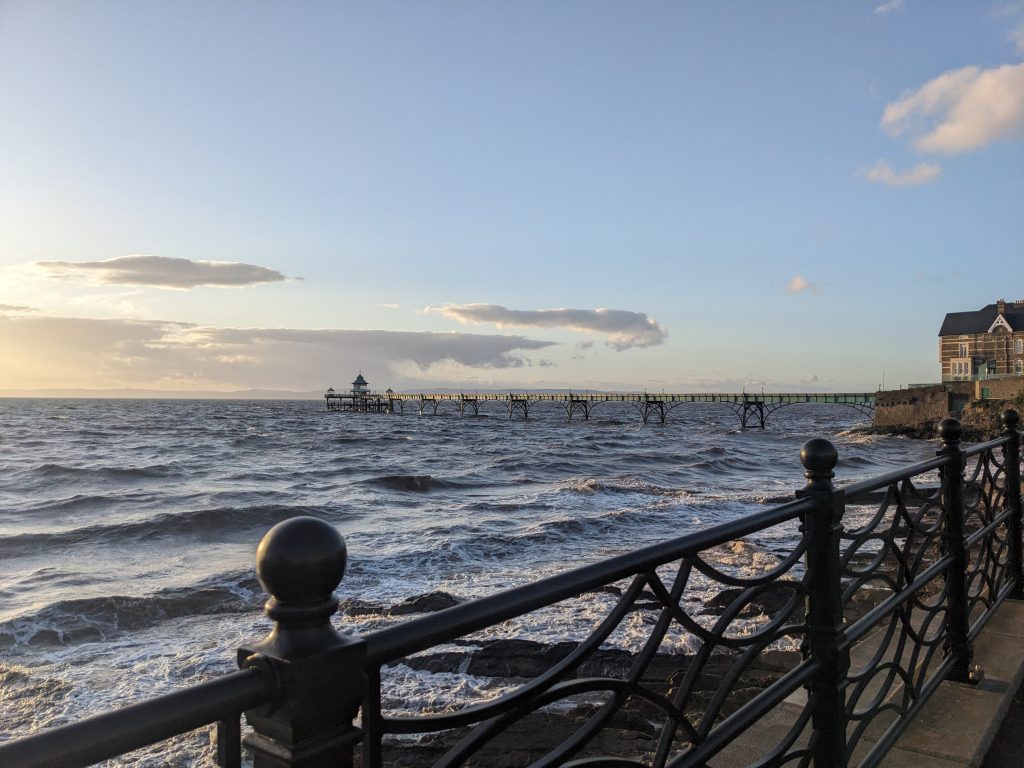

Do you have a passion for environmental communication and a talent for engaging diverse stakeholders? The Severn Estuary Partnership (SEP) is looking for a dedicated and dynamic Communications Officer to enhance the visibility and impact of the partnership’s work in promoting the sustainable management of the Severn Estuary.
The Severn Estuary Partnership is a collaborative initiative based in Cardiff and hosted by the School of Earth and Environmental Sciences at Cardiff University. Our mission is to foster cooperation across a broad range of stakeholders, including government bodies, local communities, environmental organisations, and industry representatives, to support the health and sustainability of the Severn Estuary.
As the Communications Officer, you will lead SEP’s strategic communications efforts, managing channels, creating compelling content, and coordinating campaigns to reach diverse audiences. You will collaborate closely with partners to enhance awareness and engagement with SEP’s initiatives, working on projects that highlight the importance of the estuary’s environmental and community value.
The successful candidate will be an experienced communications professional, ideally with a background in science or environmental outreach. They will possess strong interpersonal and strategic communication skills, with the ability to convey complex information to diverse audiences including policymakers, community groups, and academic stakeholders. Competency in digital content creation, media engagement, and stakeholder coordination is essential. The candidate will be adept at managing multiple projects independently, using creativity and initiative to enhance the visibility and impact of the Severn Estuary Partnership. A proactive, collaborative mindset and a commitment to continuous learning and professional development will be key.
This post is funded though The Nature Networks Fund, delivered by The National Lottery Heritage Fund in partnership with the Welsh Government and Natural Resources Wales. It aims to support nature recovery and improve the condition and connectivity of protected sites across Wales.
This position is part time (28 hours per week), available immediately and is fixed term until 31st March 2028.
Salary: £33,482 – £36.130 per annum, pro rata (Grade 5)
Informal enquiries may be made to Alys Morris, email: MorrisA18@cardiff.ac.uk
For further details about working in Cardiff University please contact John Evans, email: EvansJ13@cardiff.ac.uk
Date advert posted: Wednesday, 9 July 2025
Closing date: Wednesday, 30 July 2025
To apply, click here.
Between the bridges – Beachley to Sudbrook and beyond
Rhoda returns to the Severn Estuary, this time exploring the shore between the Severn Bridge and the Prince of Wales Bridge, to uncover more tales of river crossings and their lasting impact on the fortunes of local communities. From heritage fisheries and whale bones to gushing springs and the UK’s longest overhead power line span, this stretch of coastline is full of surprising stories waiting to be discovered.
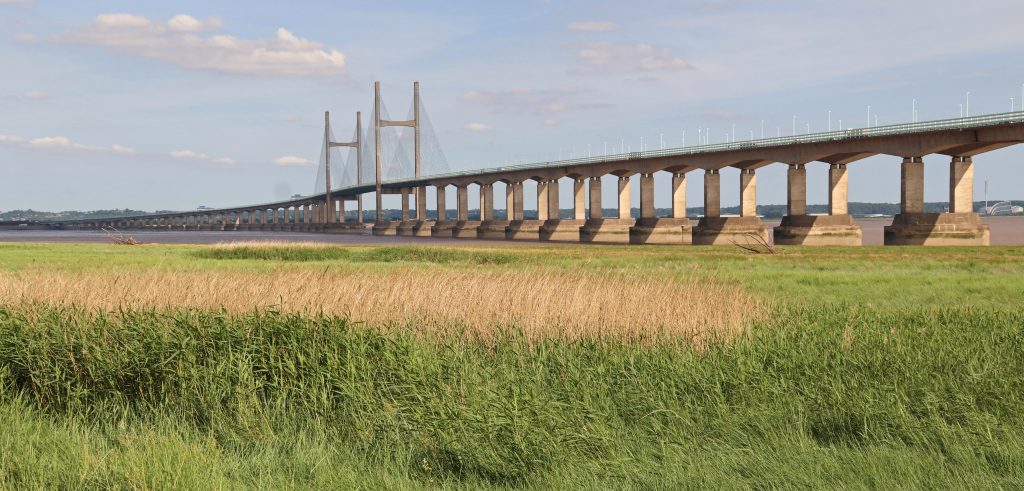
Across the marshes looking towards the Prince of Wales Bridge
Introduction
Another sweltering day was on the cards for my monthly estuary walk. Still, I figured that by doing the ‘mirror image’ of my last route — from Aust to Severn Beach — but this time on the other side of the Severn, between the two bridges, we might at least find a bit of shade beneath the structures themselves.
Keen to build on the stories we’d uncovered during that previous walk, I set out with Geoff, my trusted companion and husband, to explore the Severn shoreline between Beachley and Sudbrook. Much of our route followed the Wales Coast Path, winding through landscapes so well documented by the Living Levels project.
I hope you enjoy reading about our day out as much as I enjoyed walking and researching it — preferably with a cool glass of something refreshing in hand. (There may even be a few ideas for that later…)
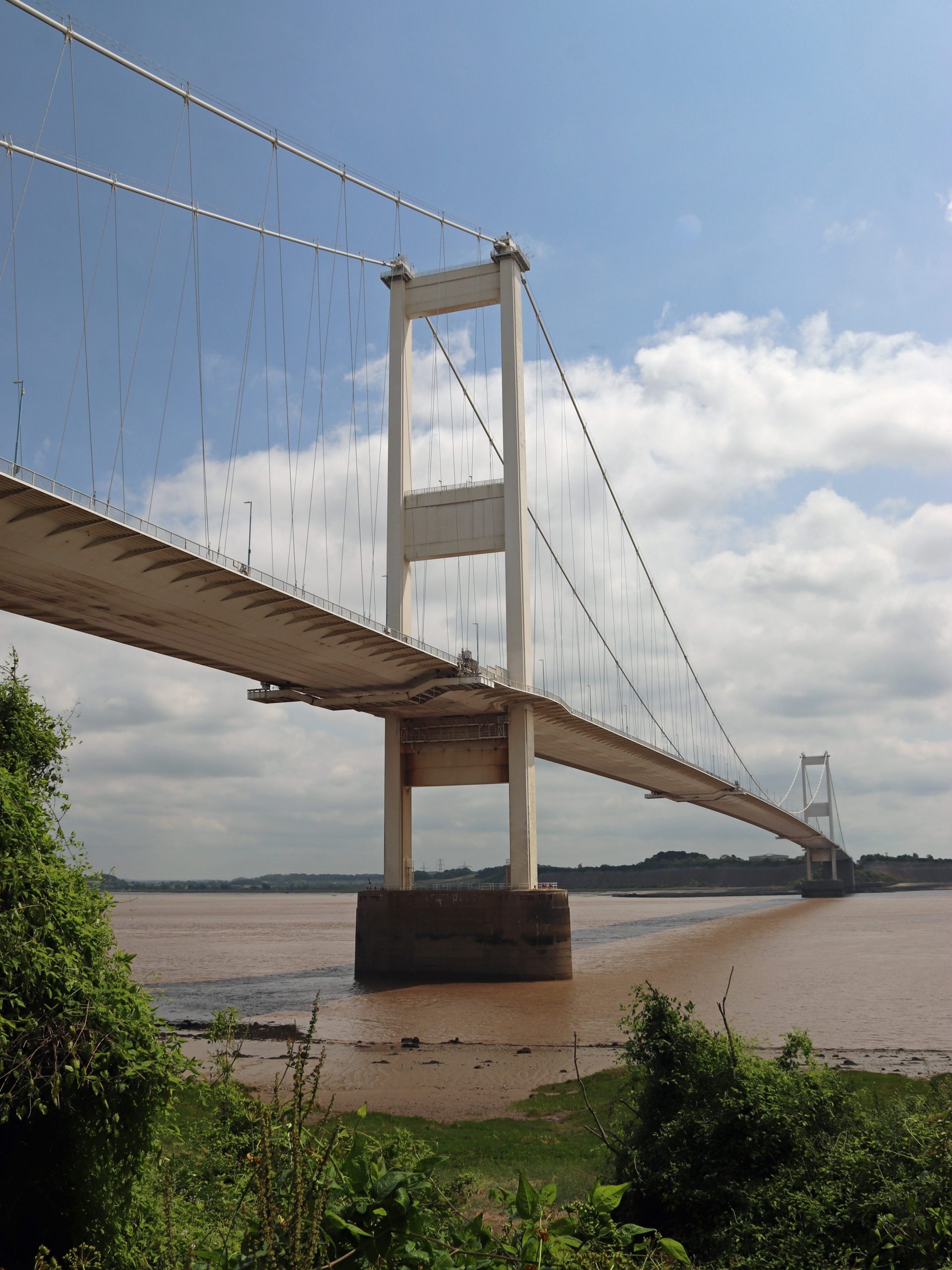
The Severn Bridge from near Beachley Point
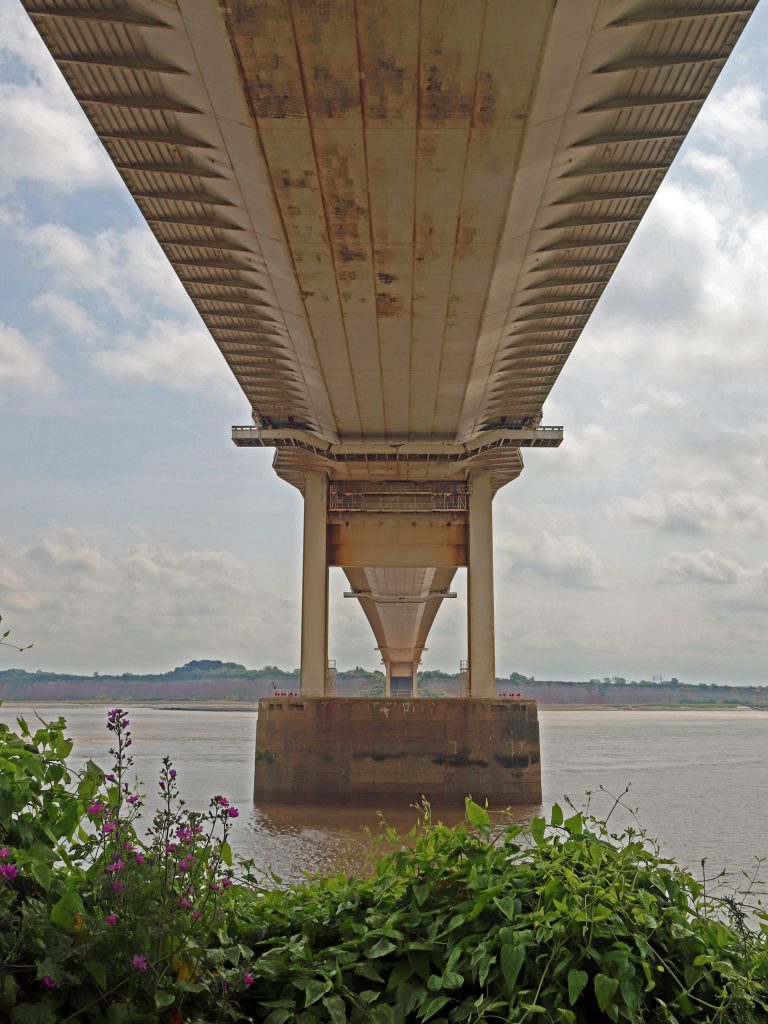
Underneath the arches: the Severn Bridge undercarriage
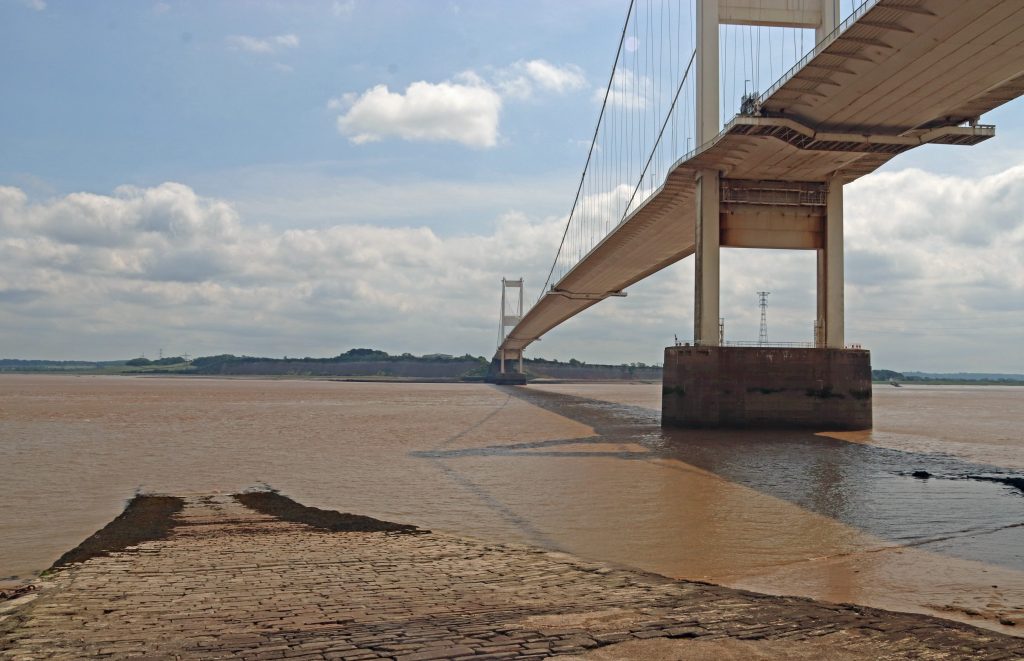
The river crossings – the Beachley Slipway and the Severn Bridge
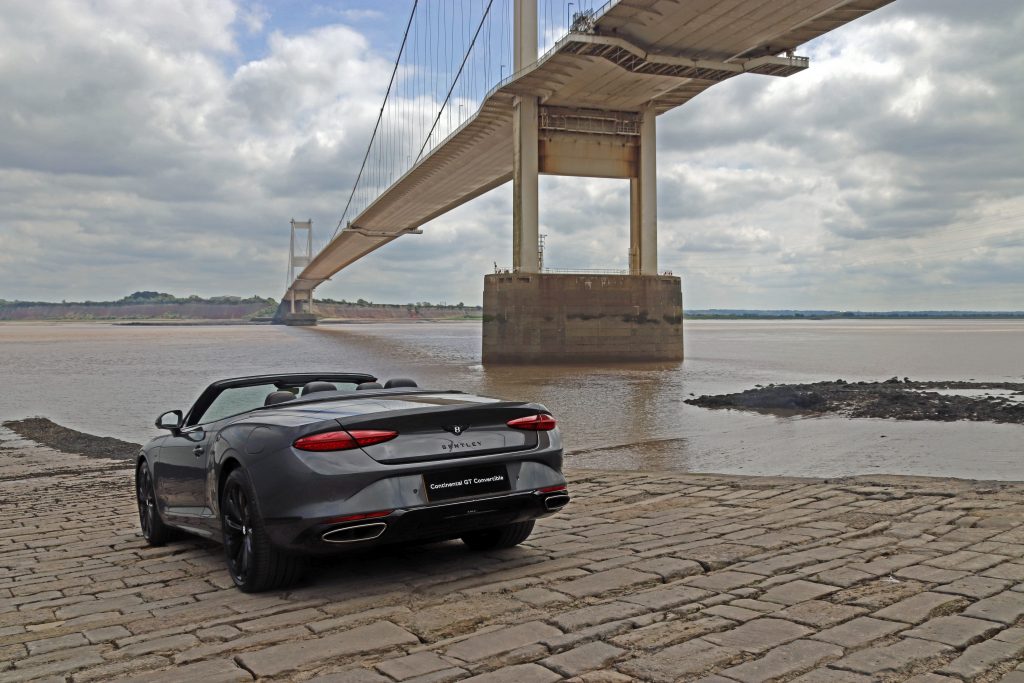
My attempt at a ‘commercial’ photo shoot!
Beachley – the old and the new crossings
Parking in the shadow of the Severn Bridge alongside a tangle of undergrowth, a ‘Danger: sea wall unsafe – keep away’ wasn’t quite the welcome I’d expected. The Old Ferry Inn which I remember seeing during a photo shoot twenty plus years ago seemed also to have lost its charm despite efforts to renovate part of the building as a conference centre. The Severn Area Rescue Association (SARA) station next door was eerily quiet too, despite various noticeboards highlighting the incredible work that operates out of this otherwise unremarkable building.
Then, we turned to look at what we had come to see — the Beachley to Aust crossing, the other end of the Old Passage that we’d encountered on our last walk. The wide stone ramp of the old slipway sloped gently downward, as if inviting us to step into the chocolate-brown waters of the Severn. No ferry today, though – the last car ferry crossed the estuary here nearly sixty years ago, on the day before the Severn Bridge opened. However, many older people still have happy memories of travelling on this ferry. Kay Powell, a former SEP Chair, excitedly recalled her childhood experiences. In our recent get-together she recounted her summer outing from Cardiff to visit her great aunt in Portishead. ‘The most exciting thing was when my dad got a car, and we’d go via the Aust Ferry. There we could see the sea gently receding. And there we were, counting the numbers of cars back, seeing if we’d get on the next ferry. And actually getting onto that with the turntable and going across to Aust…an amazing experience!’ Kay is one of many generations to have used this historic crossing — a route once travelled by Roman legions and 12th-century monks. As we watched the swirling muddy waters recede at the bottom of the slipway, it was easy to understand though why several fatal crossings had occurred here in the mid-nineteenth century — and why Daniel Defoe reportedly chose to avoid this crossing, opting to travel through Gloucester instead.
This crossing, however, is no backwater. It still serves as the slipway for SARA and other watercraft. During our visit, the slipway also served as a spot for a local angler to fish and a mooring for the fishing boat Helen Louise. Its owner eagerly shared stories of fishing for cod, conger eel and other fish in the Severn and fondly recounted crossing the old ferry as a boy, when he and other kids would hop on and off to catch a ride to the other side. “It hadn’t been the same once the bridge was built, but at least the pilots [many of whom were called Jack] were able to find work operating the toll booths,” he reflected. Later, as I focused on capturing better angles and shadows for my photos, I was distracted by the buzzing of a small drone overhead. Then, to my surprise, a sleek Bentley sports car smoothly glided onto the slipway. The slipway had become the unexpected backdrop for a commercial photo shoot! As you can see, I had a go at some glitzy photos, with moderate success.
Beachley Point – connections
After a short stroll along a leafy track, with occasional glimpses back toward the Severn Bridge, we arrived at a rather scruffy spot near the National Grid’s Beachley Compound, overshadowed by the striking anchor pylon soaring an impressive 148 metres above. At just 10 metres shorter than Blackpool Tower and significantly taller than any of the ‘skyscrapers’ in the cities surrounding the estuary, this pylon — along with its twin at Aust —supports the longest overhead power line span in the UK, stretching an impressive 1,618 metres. We craned our necks to take in the sheer scale of this giant electrical bridge stretching across the Severn!
We hadn’t come to admire the pylon, however — spectacular as it was, but rather to take in the views of the estuary and catch a glimpse of ‘Tracey Island,’ which I first spotted during my sail on the Waverley last summer. After some careful negotiation, avoiding stinging nettles and brambles, we eventually made it to the viewpoint at Beachley Point. Beyond a carpet of brown seaweed and glistening, slippery mud, the faint silhouette of a ruin perched on a rocky hummock came into view—the island known by so many names – Chapel Rock, St Twrog’s Island, St Tecla’s Island…and now Tracey Island, of course! Despite the falling tide, there was no chance we’d attempt to reach the ancient ruins of this medieval holy site today, just as generations of pilgrims are said to have done in the fourteenth century. I could certainly understand why this site once served as a refuge for hermits. However, with so many modern intrusions visible across the mudflats — pylons, warehouses, and other stark reminders of the 21st century, it was difficult to imagine the solitude that once defined this place.

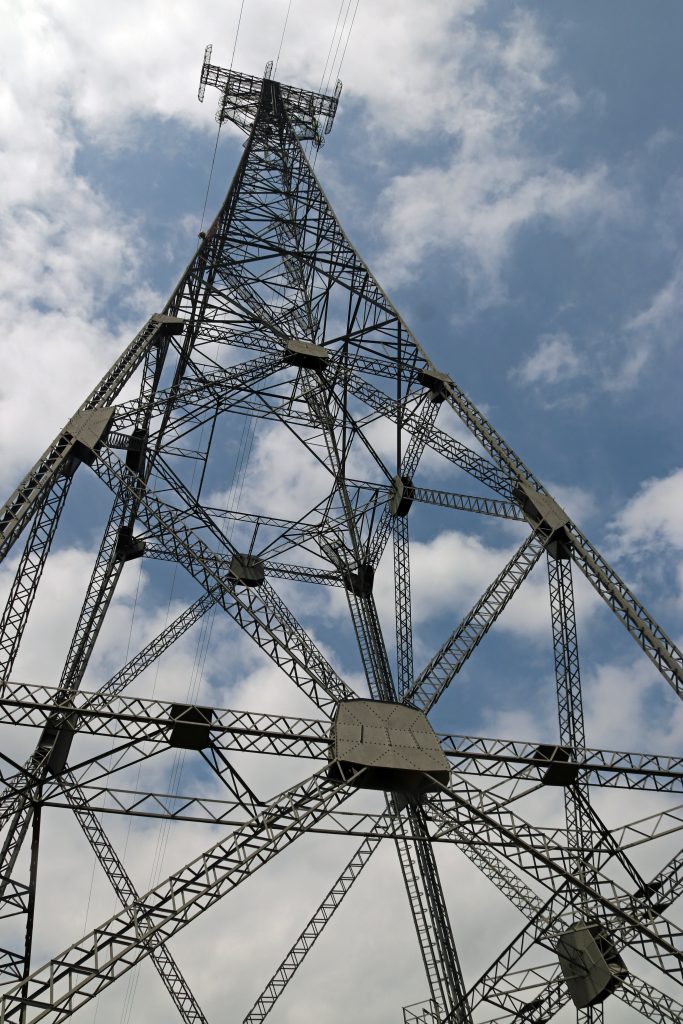
The impressive anchor pylon near Beachley Point
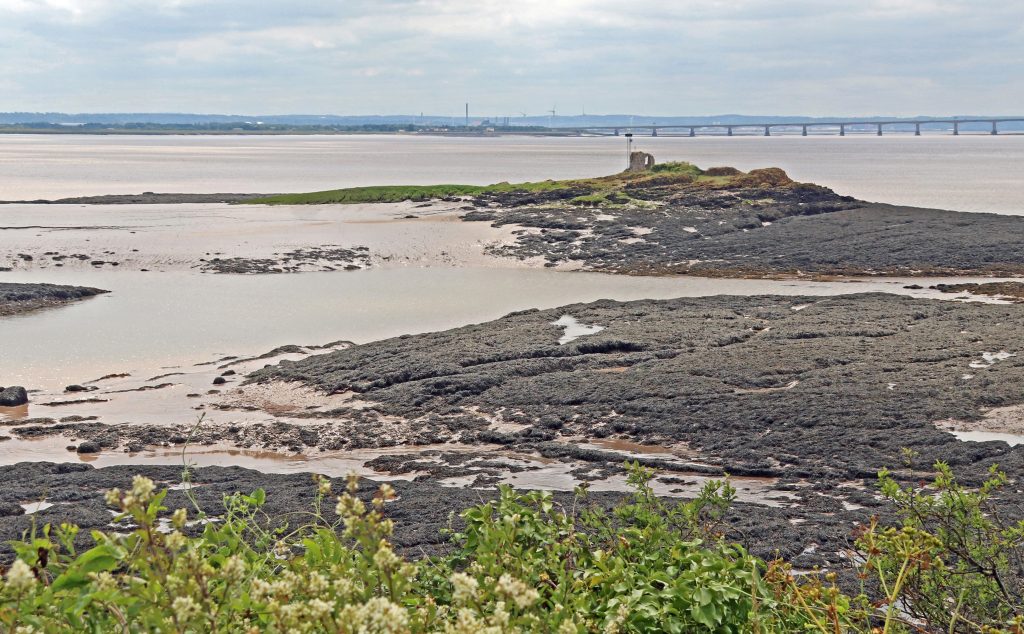
Across the seaweed towards the island of many names
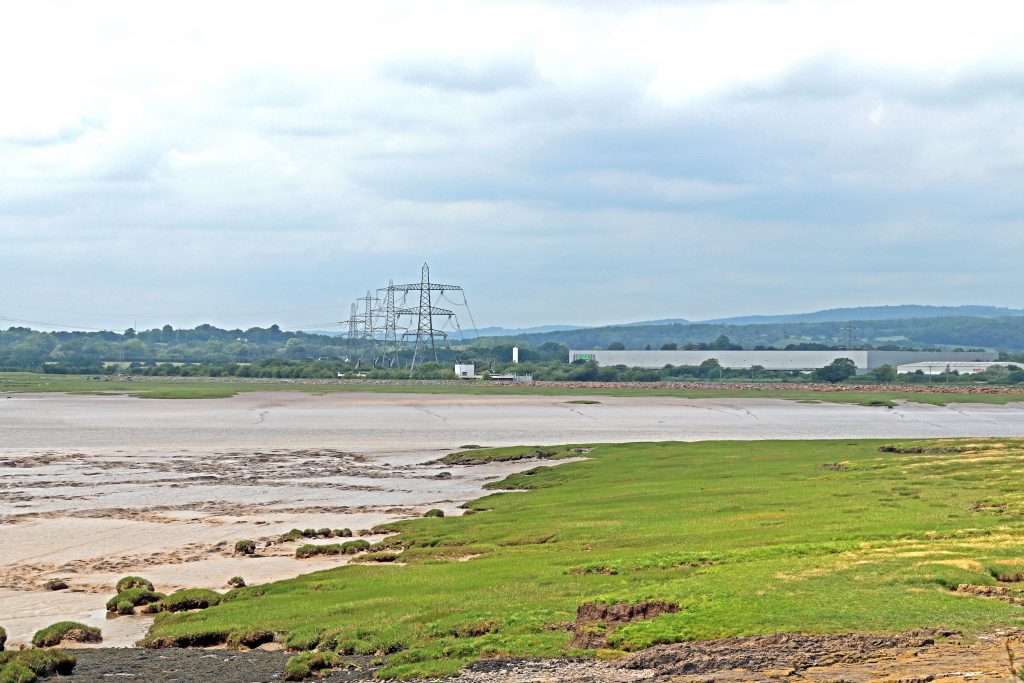
View across the mudflats towards the Wye Estuary
Black Rock – tidal landscapes, lave fishing and estuary connections
After retracing our steps, we drove to Black Rock, where we enjoyed our picnic lunch accompanied by spectacular views of both bridges stretching across the estuary. The scene was made even more striking by the vast intertidal zones laid bare by the low tide. With the mudflats and seaweed-draped rocky reefs exposed, the foreshore revealed a captivating and ever-changing landscape, though a treacherous one, as signalled by the white lighthouse that stands guard over the offshore reef (Charston Rock) hidden beneath the water at high tide. Later, treading carefully, I explored the edge of the marsh and was fascinated by its intricate microtopography. Dense tufts of saltmarsh grass rose on small hummocks, criss-crossed by a network of hidden and shallow hollows, some still holding water. It was a remarkably complex and diverse ecological system — shaped by a long and layered history of both erosion and deposition. Even just inland from the true marsh edge, isolated stems and clumps of cord grass were beginning to take hold, pushing up through the drying cracks in the mud.
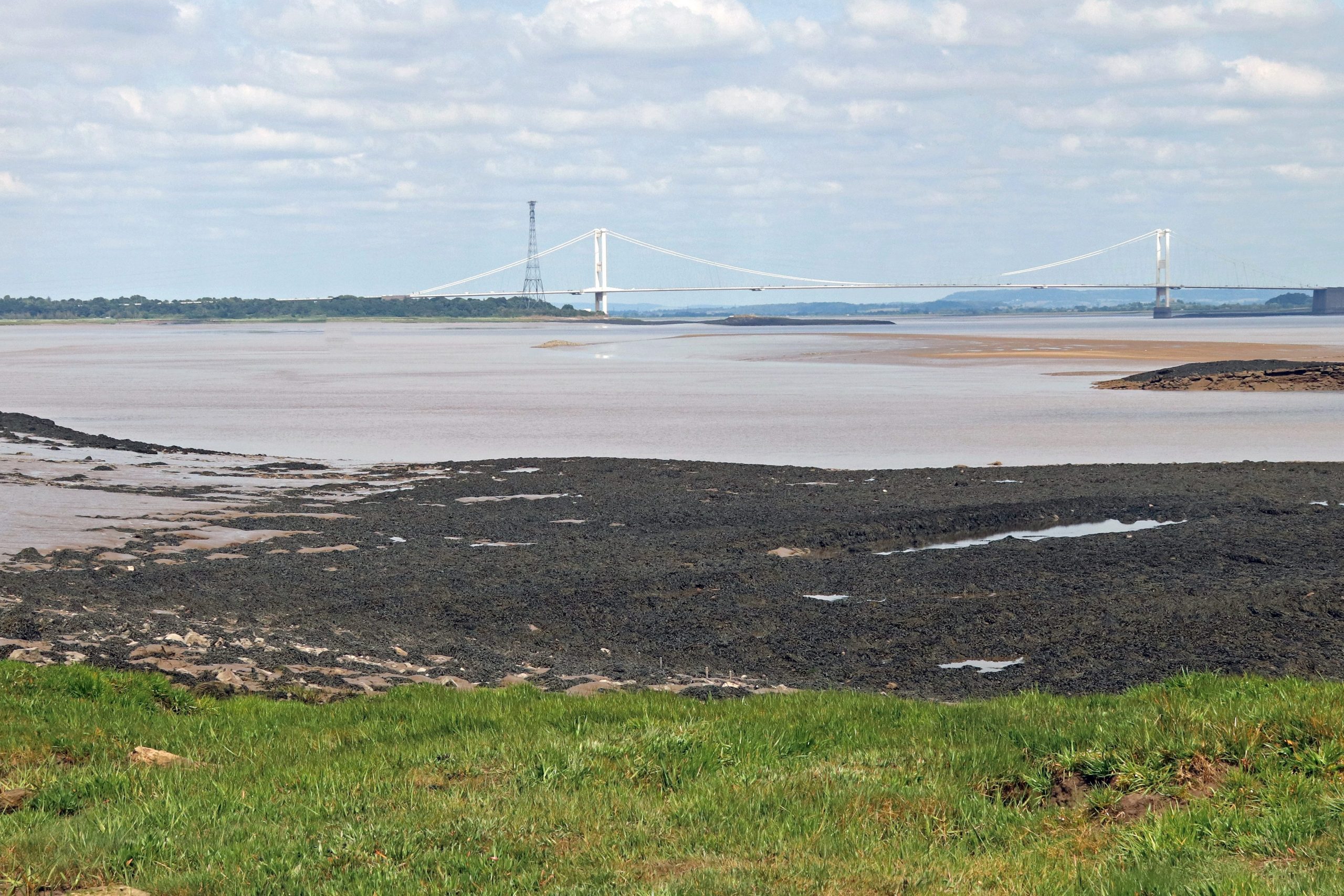
View upstream to the Severn Bridge from Black Rock
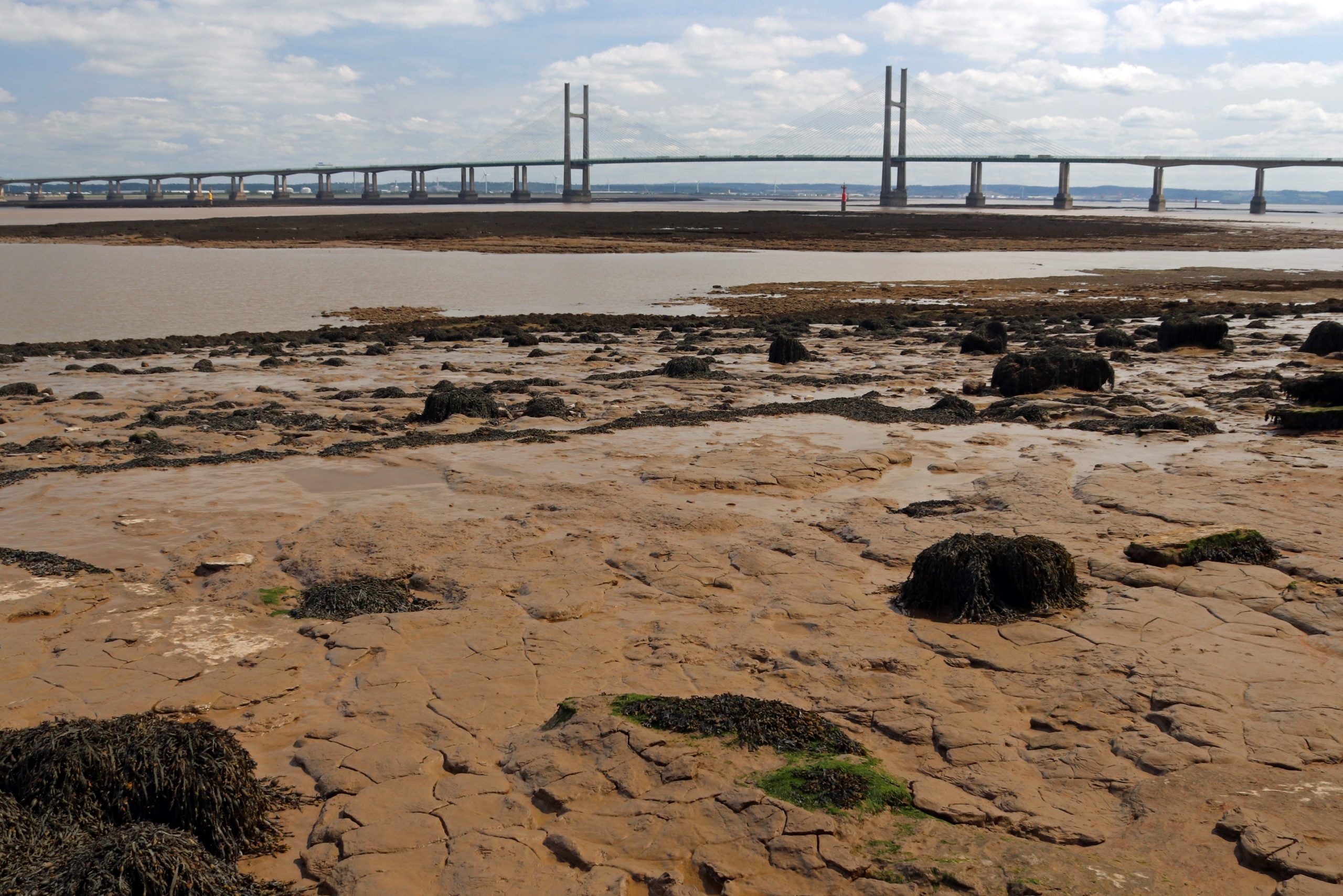
View downstream to the Prince of Wales Bridge
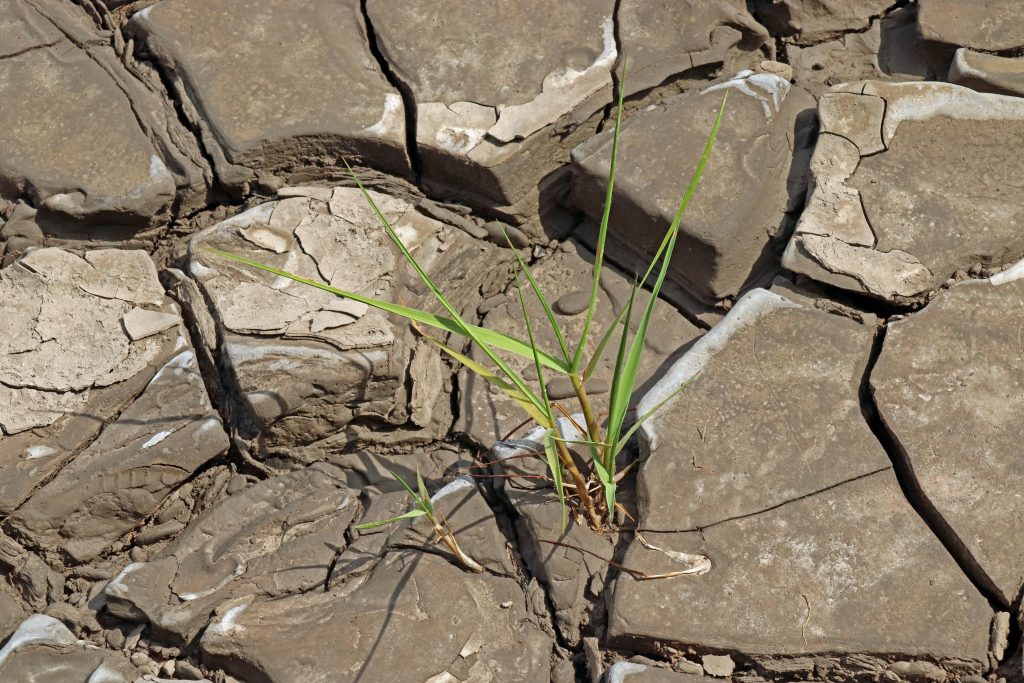
Cordgrass attempting to colonise the mudflats
Suddenly, we spotted one of the famous lave net fishermen striding across the mud, likely returning from the channel after a session of fishing. He carried his distinctive willow-framed net, just visible in the photo below. Although now a catch-and-release heritage fishery for salmon — somewhat contentiously — this centuries-old tradition is still upheld by a few dedicated local fishermen at this heritage site. According to their Facebook page, the group has built quite a following, and their videos are well worth exploring. You’ll find everything from explanations of how the nets work to footage of their fishing finds, including ancient fish traps, curious debris, most unwanted items, and more. If you’re interested in learning more, they’re hosting a special open day on 25 August. To celebrate this enduring tradition, there’s even a striking, larger-than-life oak sculpture of a fisherman and salmon, carved by local chainsaw artist Chris Wood, proudly displayed near the picnic site overlooking the estuary — a piece we stopped to admire.
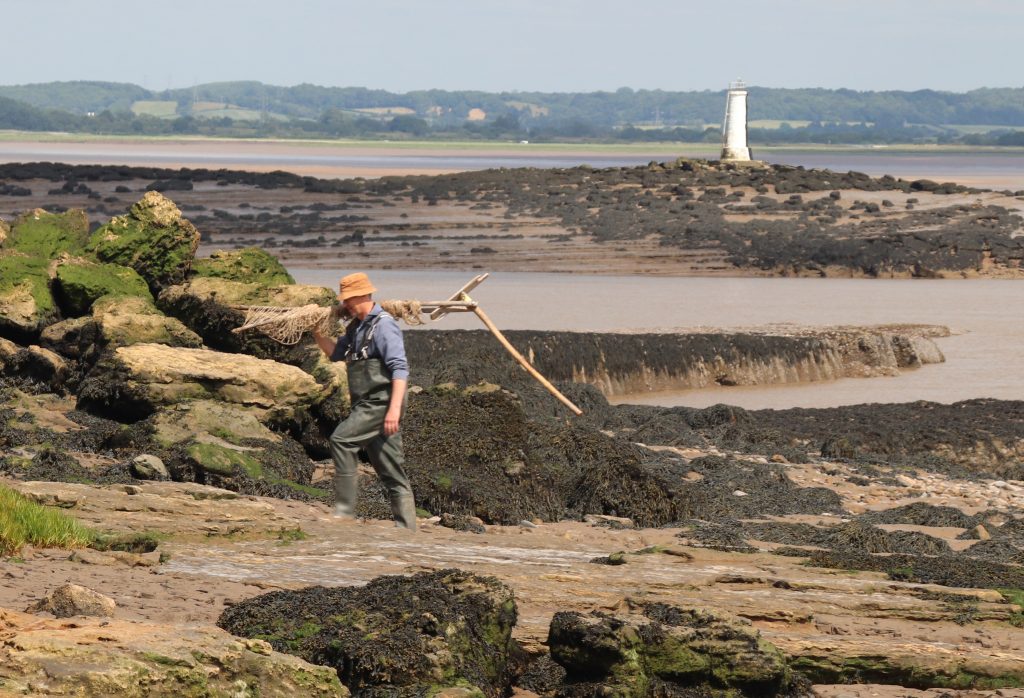
A lave net fisherman returning to shore with the Black Rock lighthouse in the background
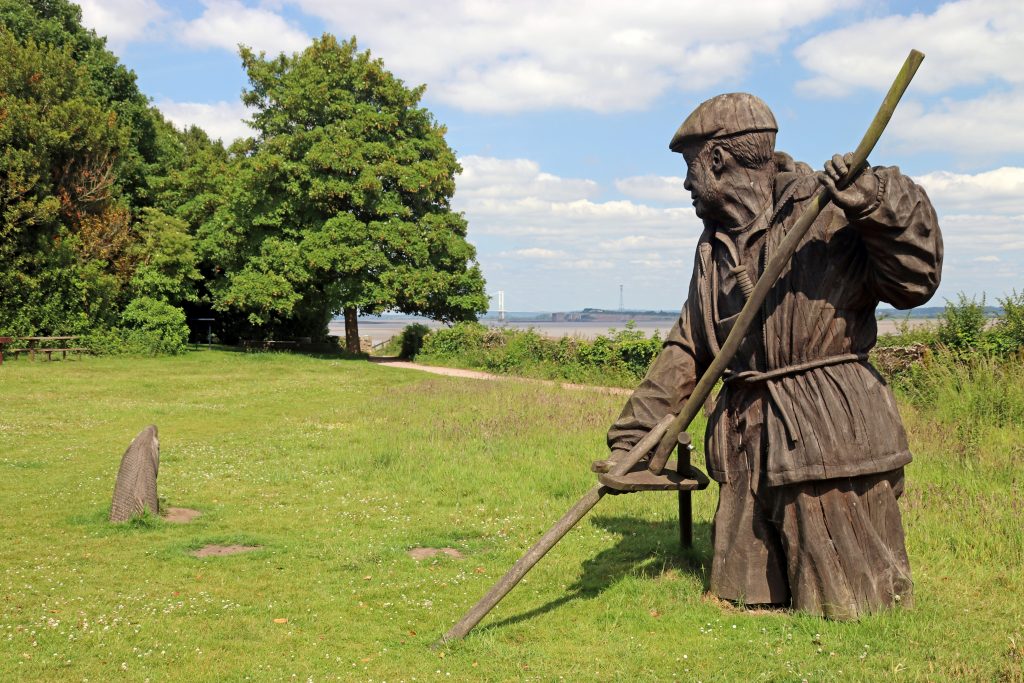
The Fisherman sculpture at Black Rock picnic site
Nearby, facing out to sea, another sculpture from the People and the Landscape series caught our eye — standing proudly atop the remaining stump where the rail-steam ferry once crossed to New Passage, which we’d visited just a month earlier. The Engineer — a distinguished figure in a smart coat, hat, and walking stick, holding a model of a factory in his left hand. This sculpture pays tribute to all those who worked on the Severn Tunnel, the two bridges, and the seawall that protects the Gwent Levels. It’s inspired by the intrepid and resilient 19th-century engineer Thomas A. Walker, who completed the Severn Tunnel and oversaw the development of the neighbouring village of Sudbrook — where we were to head off to next.
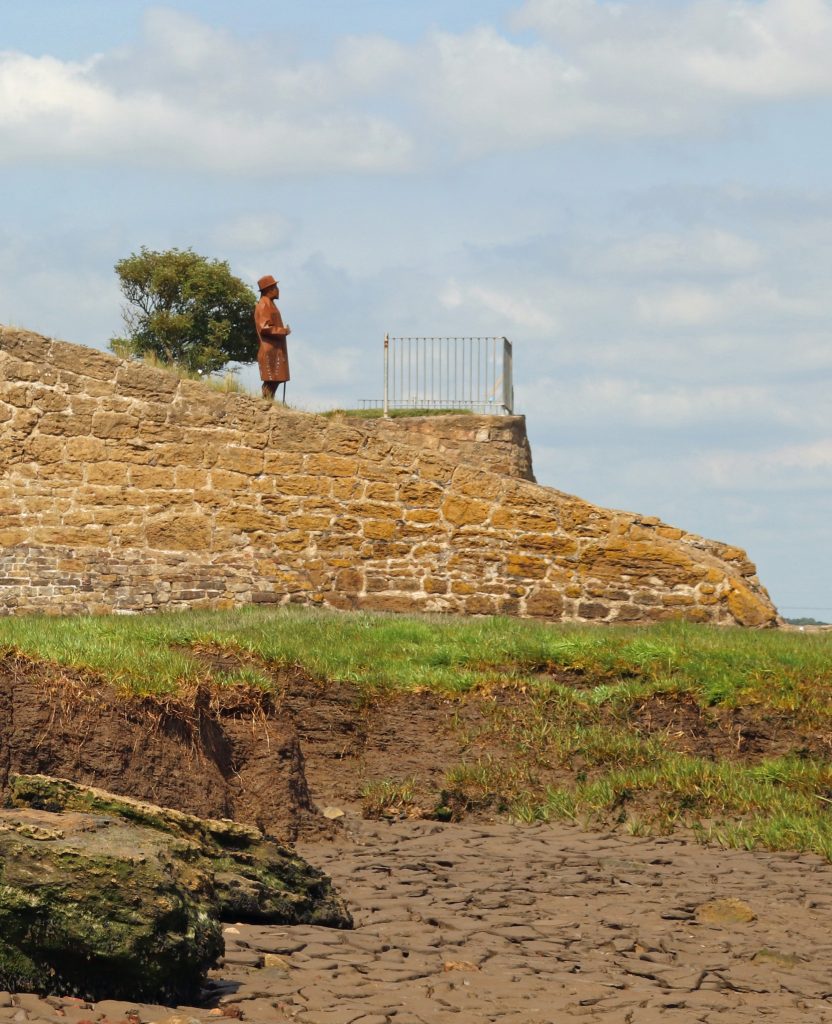
The Engineer sculpture standing proud above the old Black Rock slipway
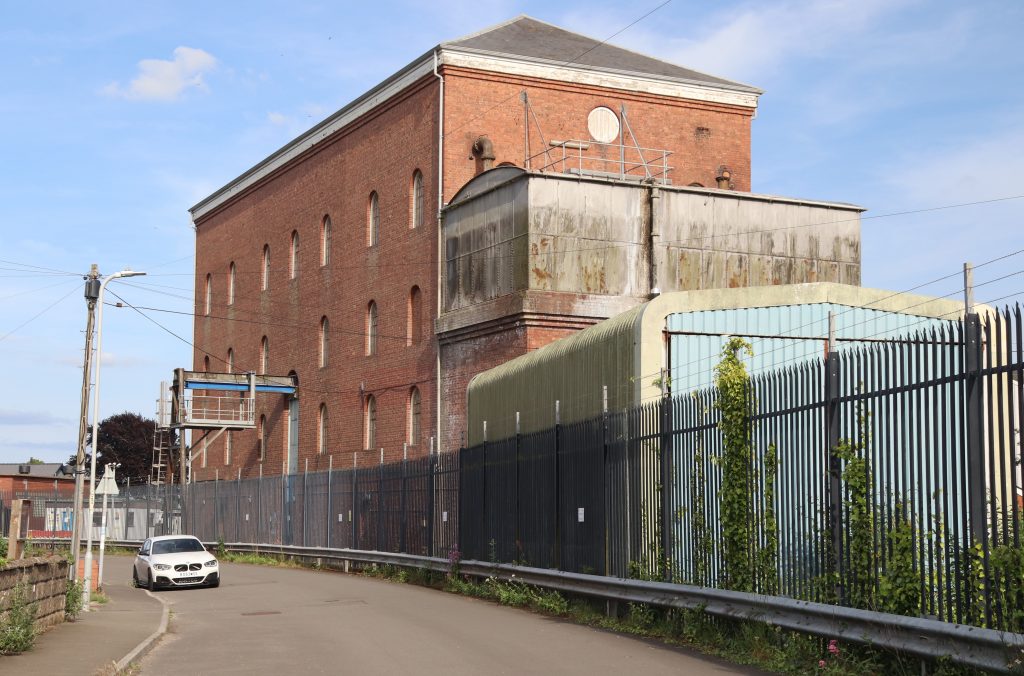
The imposing Victorian Sudbrook Pumping Station
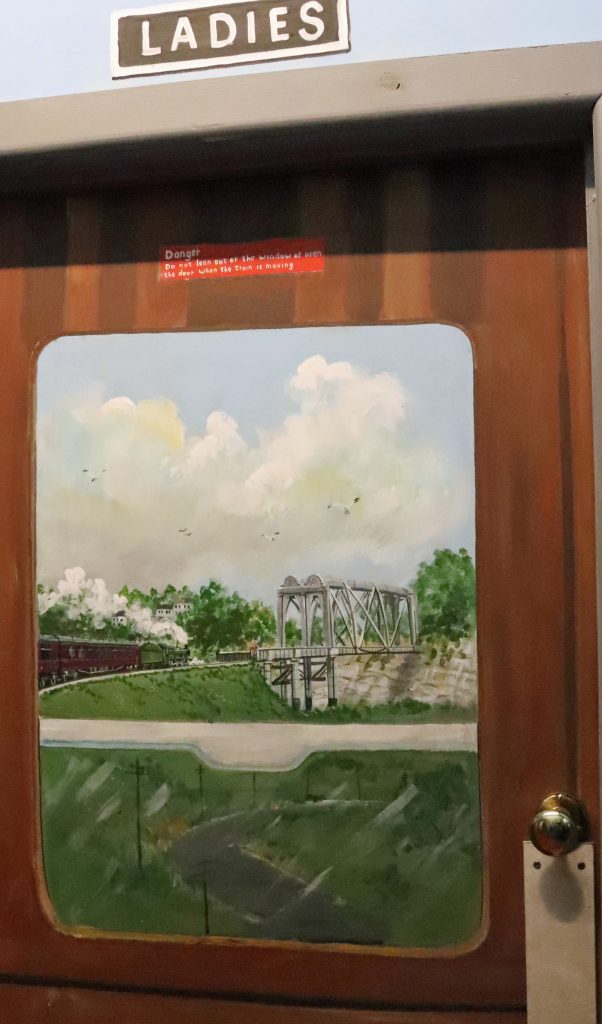
The view on the door of the Ladies toilets

Sudbrook – discovering more Severn heritage
The shade along the leafy path gave us some much-needed relief as the temperature climbed, and it was with a certain relief that we reached the edge of Sudbrook. After passing some nondescript modern developments, we found ourselves on a long street lined with cottages — part of Walker’s workers’ village from the nineteenth century, built during the construction of the Severn Tunnel. With their colourful façades and flower-filled gardens, it was striking to think these homes had once been humble dwellings for the labourers working on this ambitious project – one we still rely on today, as trains whisk us through the Severn Tunnel in under four minutes on our journey to and from South Wales. As we approached the imposing red-brick Sudbrook Pumping Station rising high above the cottages at the heart of the village, we could hear the steady whirring of machinery. No fewer than fourteen pumps are required to keep 50 million litres of water out of the tunnel every day, and, as Network Rail informs us, these must be replaced every three decades. As we learnt later from our visit to the local museum, confronting and containing the ‘Great Spring’ was one of the great engineering feats of the late nineteenth century.
The Sudbrook Interpretation Centre is quite a gem and is worth a visit, although tucked away in the corner of the Sudbrook Non-Political Club, it wasn’t that easy to find. Though we seemed to enter through a back door, we were immediately transported into another world — greeted by colourful murals in the entrance hall celebrating railway triumphs and journeys. Even the toilet door was painted, as you can see below.
The exhibition room, though modest in size, held a fascinating and eclectic mix of local stories and memorabilia that we eagerly explored. Alongside informative display boards lining the walls were towering stacks of scrapbooks, school projects, and old photo albums. Glass cabinets showcased an array of finds from the mud of the River Severn—many with real historical significance. There was even the horn of a medieval cow and a whale bone from a whale that washed up at Sudbrook a century ago, in 1925!
We took our time delving into the material — not only was it genuinely fascinating, but it also offered a welcome cooling refuge from the sweltering heat. I have to personally thank the Caldicot and District Historical Society, not just for curating such an engaging collection, but also for the thoughtful touches like the tea and coffee-making facilities. If only every community around the Severn Estuary had such a valuable and lovingly maintained resource.
The Prince of Wales Bridge – yet another perspective!
After enjoying the cool respite of the museum, we stepped back into the searing afternoon heat to complete our bridge-to-bridge journey — determined to reach the Prince of Wales Bridge on the Welsh side of the estuary by foot. Skirting behind more of the original workers’ cottages, we eventually found ourselves crossing a football pitch by the water’s edge. But this was no ordinary pitch — it stands within Sudbrook Camp, an ancient hill fort likely dating back to the Iron Age. Over the past two thousand years or so, significant coastal erosion has claimed much of the southern ramparts, now lost to the sea. Perhaps something the residents of the extensive new housing estate to the west of the village — partly nestled within the remaining ramparts — should be mindful of, especially given the size of some of the debris scattered along the strand line on the marshes.
With the sun beating down, I must admit I struggled to walk the rest of the path, which, being wide open to the coastal marsh, offered no shade. The ever-changing marshes and sweeping coastal views kept me going, though I found myself increasingly distracted by the roar of traffic growing louder and more thunderous as we neared the bridge. After nearly emptying our water bottles, we finally reached our destination — and the cool shade beneath the bridge’s undercarriage was a truly welcome relief.
Amid the relentless noise of traffic, focusing on taking meaningful photos was a challenge, but I hope the ones that follow convey the sheer scale of this mighty structure from our vantage point — a strikingly different perspective from what we’d seen on the other side of the estuary only a month ago. Here at Caldicot, the bridge twists sinuously across the marshes, stretching into the distance like a giant centipede resting on towering pillars. We savoured our final glimpses through the arches, offering an intriguing view of this impressive feat of engineering, before making our way back to Black Rock — via the wonderful refuge of the Sudbrook Interpretation Centre, of course.
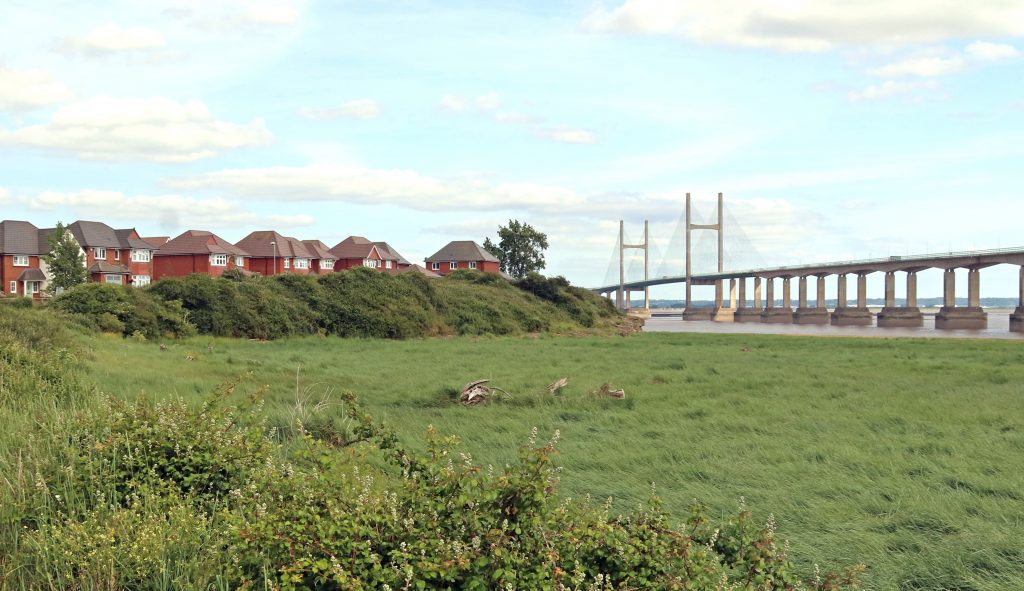
Housing nestling behind Sudbury Camp – note the storm debris on the marsh
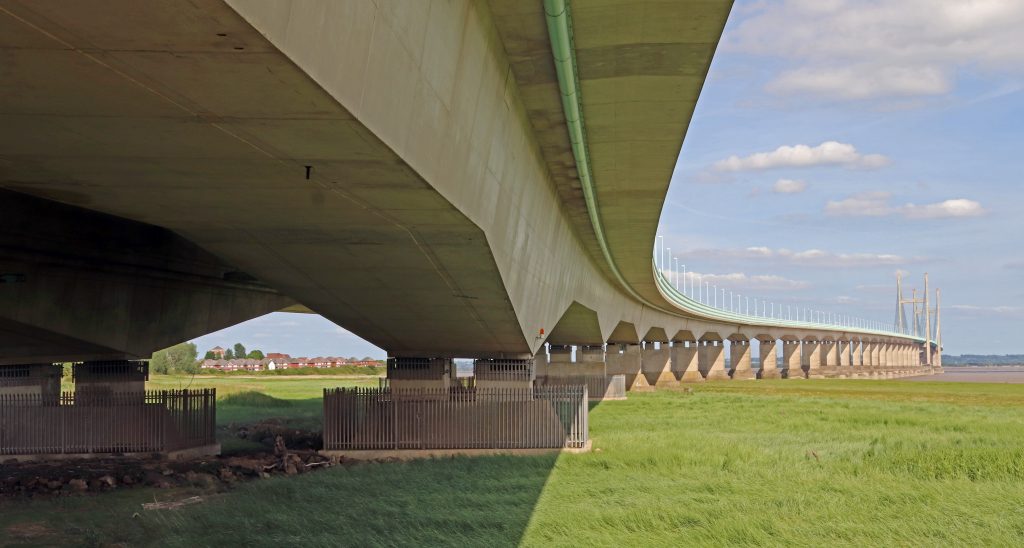
The Prince of Wales bridge meandering above the marshes at Sudbrook

Further reflections and conclusions
Whether it’s an unexpected perspective on a familiar place or a fresh angle on a well-known structure, there’s always an element of surprise that keeps us engaged as we explore each stretch of this remarkable estuary — and this walk was no exception. It was far from a mirror image of my previous walk, though there were many similarities and parallels — not least the sweltering heat on both occasions. But new stories had emerged on this side: tales of the traditional lave net fishery, for instance, and the unexpected popularity of the old Beachley slipway as a photo shoot location.
The strategic importance of river crossings — and their influence on the ups and downs of coastal communities — is something both stretches of the estuary share. Sudbrook, for one, quite literally owes its existence to the construction of the Severn Tunnel. Today, it’s a far cry from Walker’s original ‘new town’ plans, but one thing hasn’t changed: the Great Spring still needs taming. Indeed, next time you crack open a Budweiser, Stella, or a pint of Welsh bitter, there’s a chance you’re actually drinking water from that very spring — it now supplies the local brewery at Magor! As for me, after a scorching day out, I gave the beer a miss and opted for a tall glass of my trusty Severn Beach/Pilning cordial, the perfect way to reflect on yet another memorable day by the estuary.
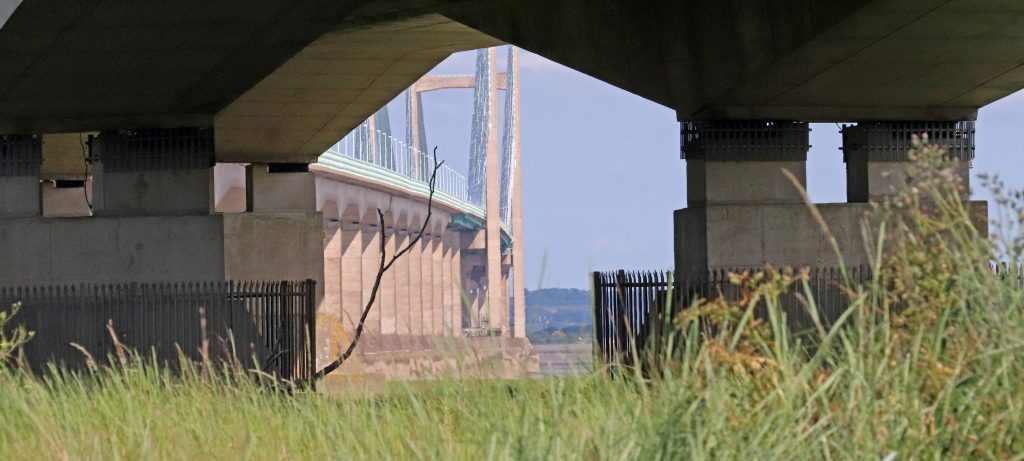
An intriguing perspective through the arches of the Prince of Wales Bridge
Further information
Check out this link for a stunning photo of a bridge section being installed over the ferry slipway at Beachley
Living Levels Loop and Links Walk 5 – Caldicot to Black Rock loop
Sudbrook and Portskewett trails through the ages
The Severn Estuary Forum Programme is out now!
We are delighted to announce the release of the full programme for the Severn Estuary Forum 2025, taking place on 3rd July in Weston-super-Mare. This year, the forum brings together a rich mix of expert talks, panel discussions, and community stories.
Register for the forum and explore the programme here:
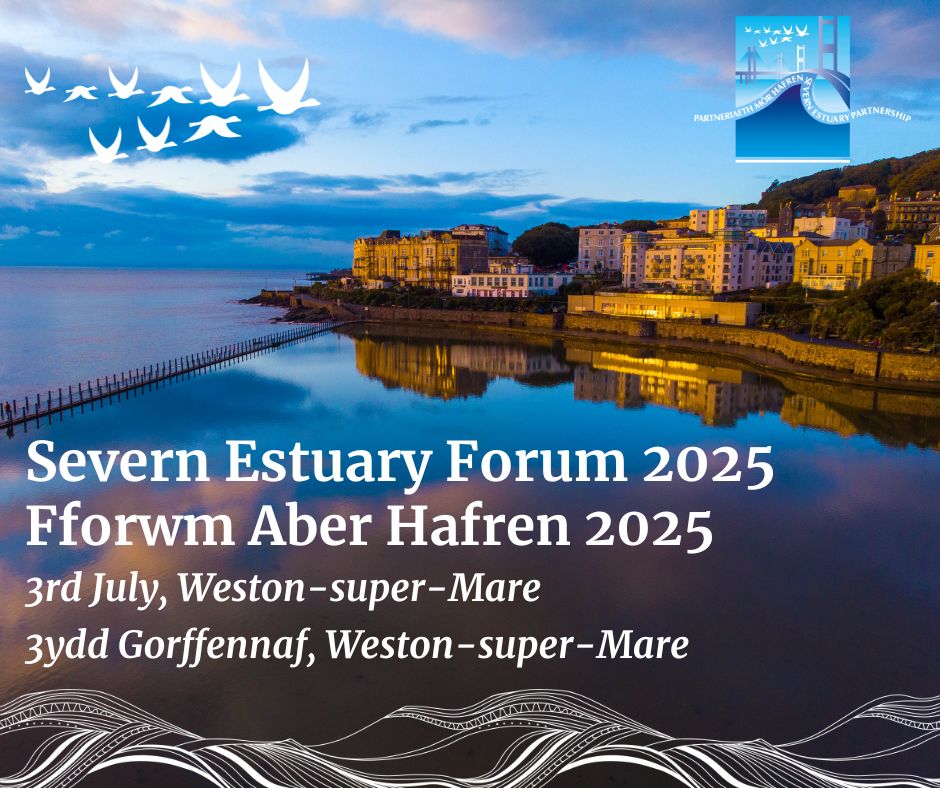
Exciting Student Placement Opportunity – Join us in ‘Future-proofing’ the Severn Estuary
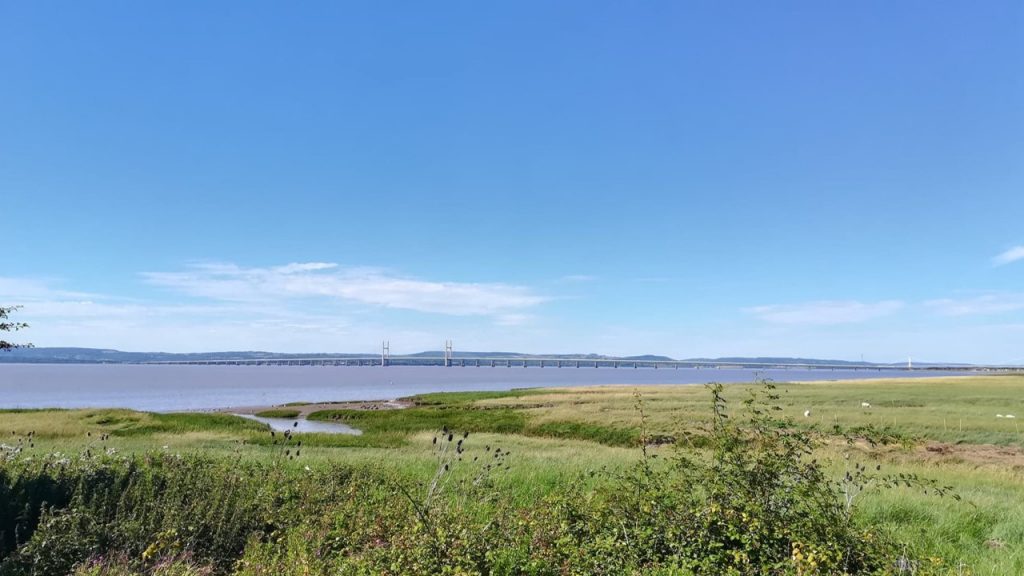
We’re pleased to offer an exciting student placement as part of our “Future Proofing the Severn Estuary” project. Hosted within Cardiff University’s School of Earth and Environmental Sciences and funded by the Nature Networks Programme through the National Heritage Lottery Fund, this project focuses on enhancing the protection and resilience of the Severn Estuary Marine Protected Area (MPA).
As a placement student, you’ll play a key role in updating our State of the Severn Estuary Report—a crucial resource for environmental monitoring and decision-making. You’ll help develop an evidence and data collection plan and work directly with stakeholders to identify data needs, gaps and resolution requirements for decision-makers.
You’ll be part of a dedicated and supportive team, gaining valuable experience in data gathering, stakeholder engagement, and environmental reporting. The role offers flexible, blended working and will involve travel across the Severn Estuary area.
This is a fantastic opportunity for a student passionate about marine conservation, sustainability, and environmental data. Applications are open until 20th June. For more information about the role and how to apply, click the button below.
Join us and help shape a sustainable future for one of the UK’s most iconic coastal environments.
Aust Cliffs to Severn Beach: reflecting on the passage of time
Written by Dr Rhoda Ballinger, SEP Chair
Rhoda delves into deep time at Aust Cliffs, visits four estuary crossings from different periods and reflects on coastal change and flood risk around Severn Beach.
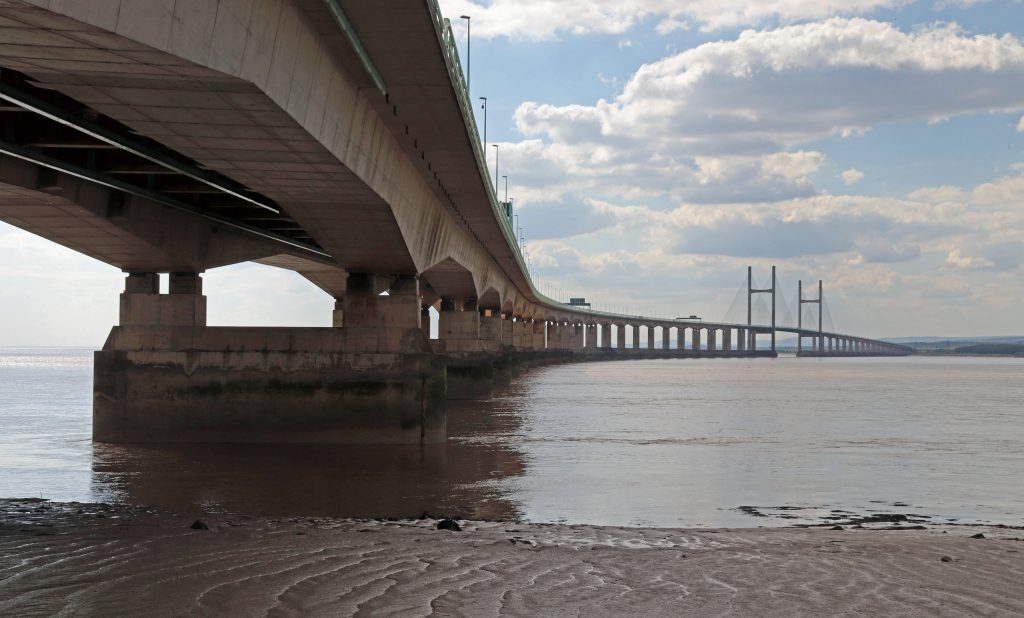
Photo: The Prince of Wales Bridge crossing over some of our estuary’s most treacherous waters
Introduction
Since becoming SEP Chair in April 2024, I realised I’d completed a dozen walks, but hadn’t yet explored the shores of several local authorities around the Estuary. With this in mind, I decided to focus my next few walks on filling those gaps. So, this month, having heard about various management projects along the South Gloucestershire coast in recent SEP meetings, I decided to explore the shore between Aust and Severn Beach.
On one of those fine sunny days in early May, I ventured out with Geoff, my husband, to explore the shore between the bridges on the English side of the estuary. Once again to inform my article, I’m grateful to the members of the community for sharing their rich local knowledge and history. Val George has been involved with the Pilning & Severn Beach History Group since its inception in 1999 and Alderman Peter Tyzack, vice-chair of Pilning and Severn Beach Parish Council, is no stranger to SEP, having been Chair of our Steering Group.
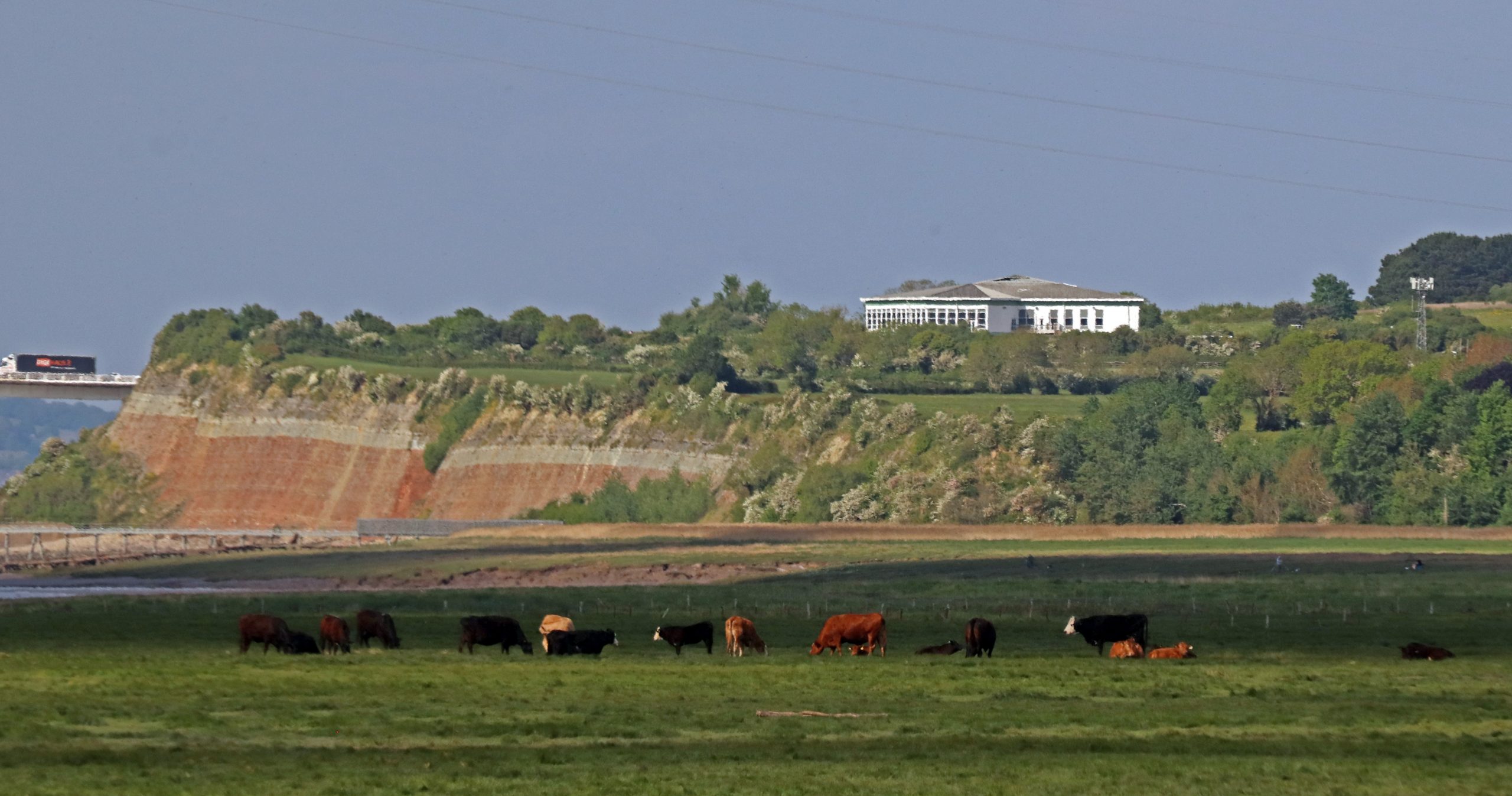
Photo: Cattle grazing on the marshes in front of the iconic Aust Cliffs

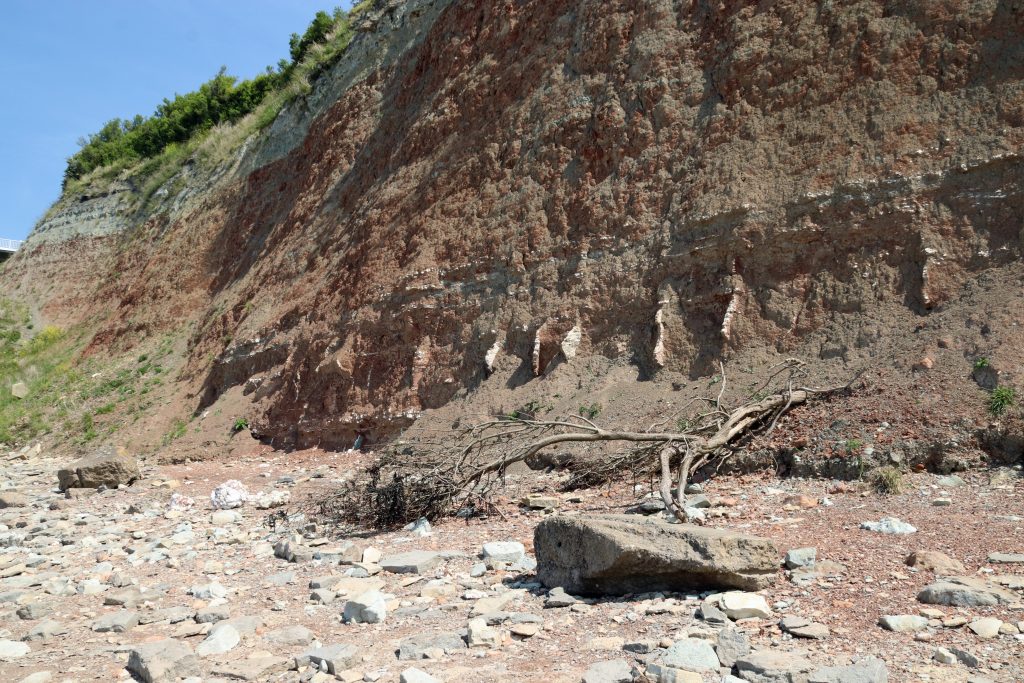
Photo: The impressive Aust cliffs showing evidence of active erosion
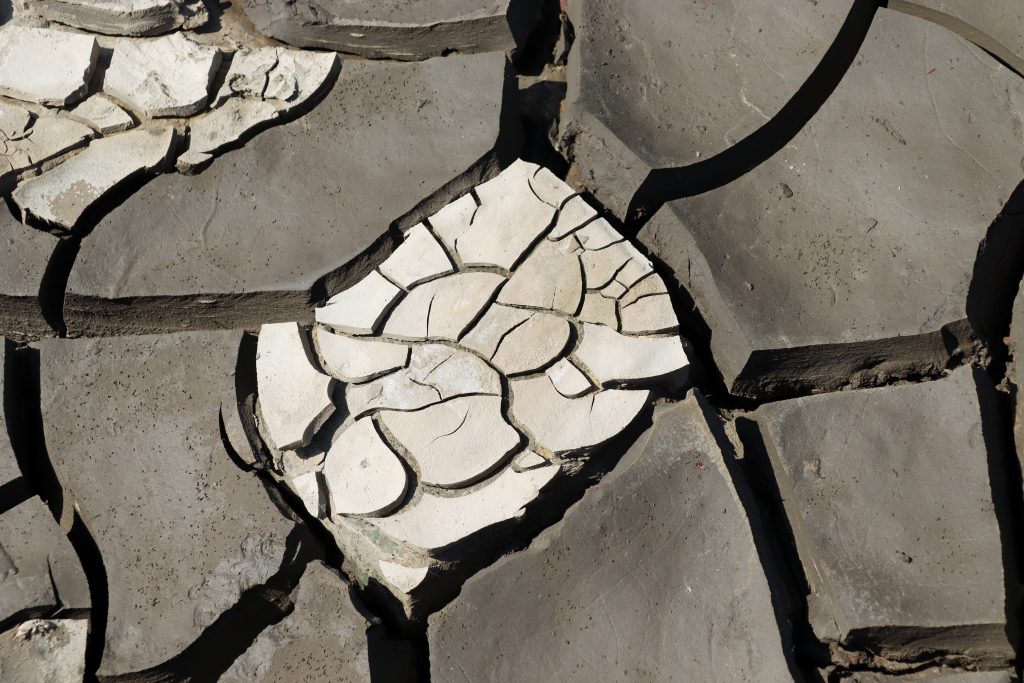
Photo: Mud cracks on the current foreshore

Aust cliffs – a glimpse into deep time
We started at Aust Cliffs, the sister site to the Penarth-Lavernock shoreline which I’d visited on my first e-news walk. I was especially excited to visit these cliffs, renowned for their geological significance. Designated as a Site of Special Scientific Interest (SSSI), they offer one of the most remarkable records of environmental change from around 210 million years ago, when rising seas flooded a once-arid desert landscape. These days they’re a mecca for fossil hunters, containing the famous ‘Rhaetic Bone Bed’ with its incredible wealth of remains of fish and marine reptiles/ dinosaurs. What might we find?
As we neared the shore, the towering cliffs rose above us, showcasing a striking sequence of coloured strata—from red and green marls to cream and white limestones—that was truly impressive. From a distance, it might have looked like a giant slice of sponge cake, but up close, there was fascinating geological detail. White veins jutted out from the ancient red desert rocks, resembling the worn, jagged teeth of some long-lost giant beast. These were made of gypsum, formed when highly salty water evaporated in shallow, temporary lakes (playas), similar to what occurs in the Dead Sea today. Glittering chunks of gypsum lay scattered across the shore like discarded chess pieces, having tumbled from the cliff face above. As we continued along the beach, carefully skirting recently fallen trees, I questioned the official claims of ‘slow’ erosion—prompting me to take a cautious step back. Later, I also wasn’t surprised to learn that for reasons of safety the first classic sketch of this cliff in the 1820s, had been made from a rowing boat offshore!
The beach here quickly morphs into soft mud – and, determined not to have another Severn Estuary mud immersion experience after my Severn Bore visit, I focused on studying treasures within the mid-shore. To my surprise, the muds were a spectacle in themselves. Mud cracks, formed from the drying out of mud as the tide had waned, had created a fascinating display of intricate and complex polygonal patterns. From every angle there was a cubist masterpiece – a shame our visual artist friend, Heather Green, who studies and draws inspiration from our intertidal areas, wasn’t with us.
Having exchanged a few words with a couple of fossil hunters, who were leaving with a plastic bag of goodies, we scoured the beach. No sharks’ teeth or bones from dolphin-like ichthyosaurs and long-necked plesiosaurs today. We had to make do with observing a motley collection of marine shells—mostly fragments of oysters and scallops—from boulders that had fallen from the cliff. With little time or expertise, we couldn’t examine the site’s renowned fossil insect deposits—the richest Triassic insect locality in Britain. As a small consolation, though, a pair of peacock butterflies performed a brief pas de deux as we left.
Old estuary connections: The Severn Bridge and the Old Passage
We carefully negotiated our way over a sea of boulders to get a rare view of the undercarriage of the bridge, now definitely a senior, at sixty years old. Here, it was at its most impressive, rising elegantly above the still, brown waters of the Severn. However, whilst the photo might suggest a peaceful, tranquil view, we struggled to appreciate the scene against the constant roar of traffic. More disturbing, however, is the news today, that new weight restrictions have come into force on the bridge. Hopefully, a technical solution will be developed soon to keep this vital bridge safe and functioning.
Moving along the shore toward Old Passage, there were more mud cracks, mysterious wooden structures jutting out into the water, and countless views of the bridge—keeping my camera busy the entire time! Before too long, the boom of motorway traffic gave way to the enchanting calls of reedbed birds and the graceful reeds, wafting gently in the light breeze, provided ever more photo opportunities.
We emerged out of the reed beds to spot the decaying wooden skeleton of the old slipway, which stretched across the marshes and mudflats before disappearing into the calm, brown waters of the Severn. This was the site of an ancient estuary crossing, dating back at least to Roman times—or possibly earlier—serving as a vital, though sometimes treacherous, link between Aust and the Beachley Peninsula. Given the calm still waters on our visit, it was difficult to imagine how perilous this crossing had been. Despite fatal accidents, a small car ferry had operated here until the Severn Bridge opened in the 1960s.
Memories of the ferry terminal live on, immortalised by Bob Dylan’s visit and featured on one of his album covers, as well as in the 2005 documentary No Direction Home. In my husband’s family album, there’s also a photo of the MV Severn Queen—one of the last ferries to serve here along with her sister ship, the MV Severn Princess, which carried Dylan across the estuary. No longer here, but now lying at rest on the other side of the estuary at Chepstow, we had to make do with exploring what remains of the slipway structure and its rusting artefacts.
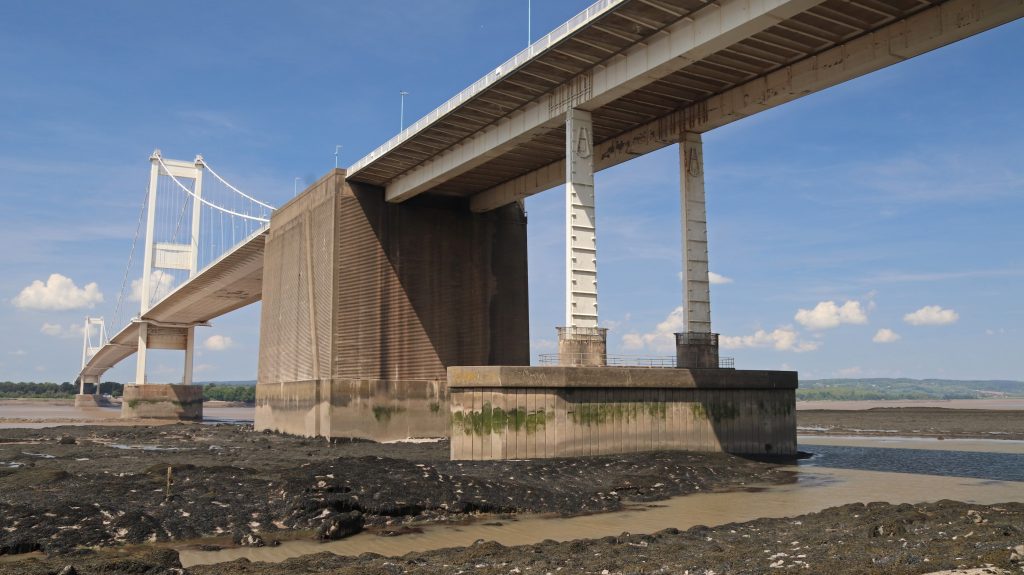
Photo: A rare view of the undercarriage of the Severn Bridge at near low tide
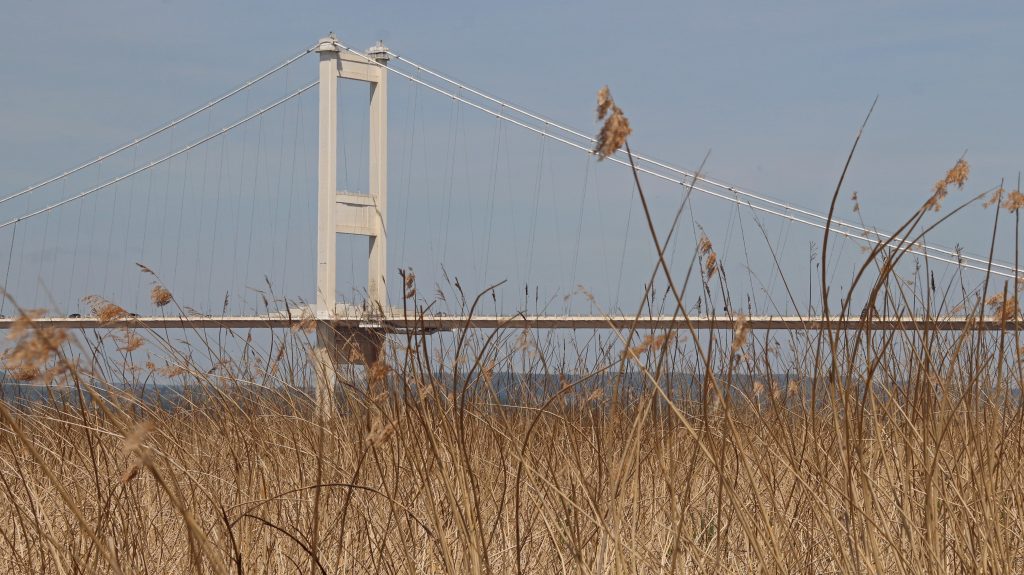
Photo: Looking through the reed beds back at the Severn Bridge
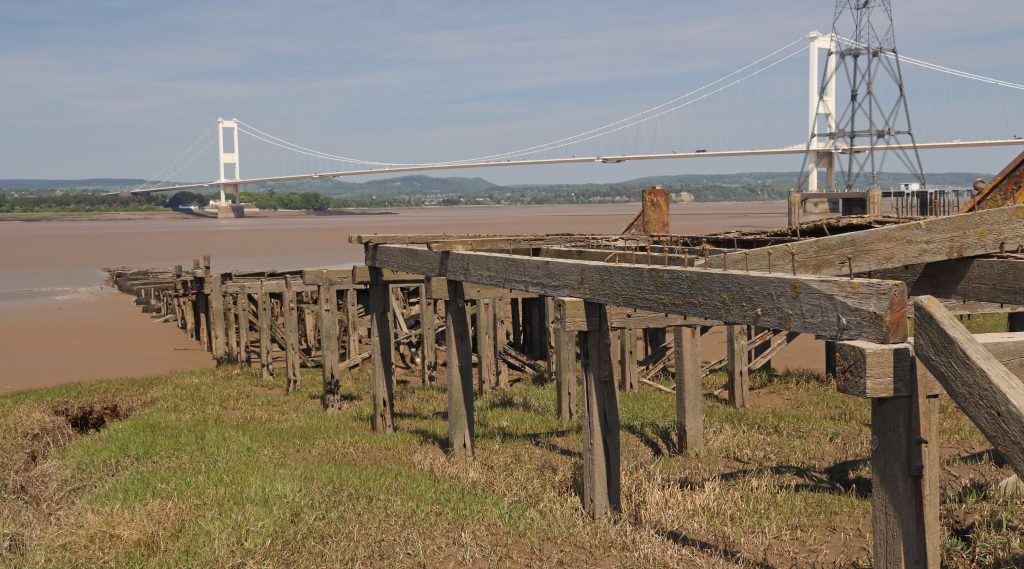
Photo: The wooden remains of Old Passage, marking the former ferry route across the Severn
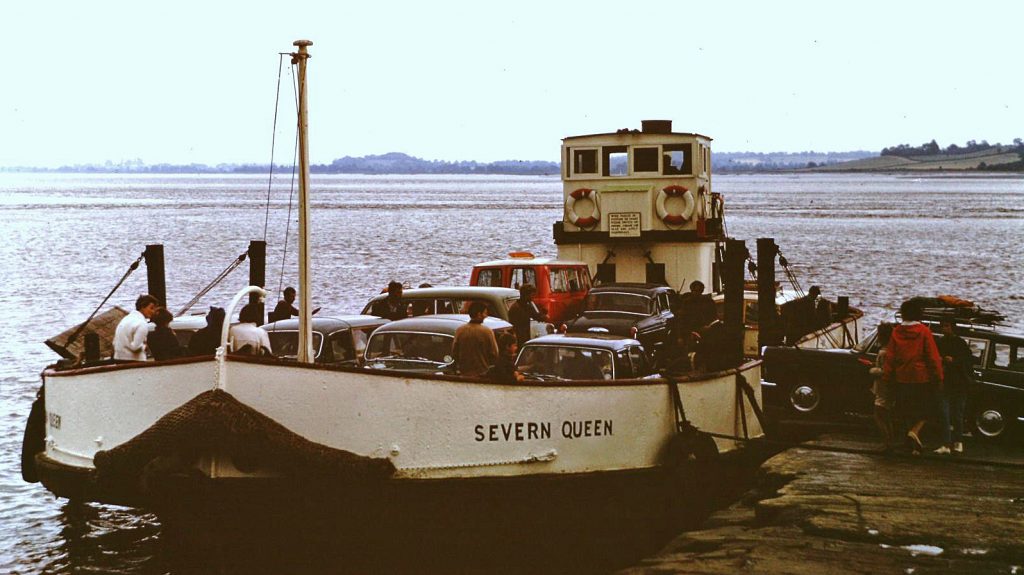
Photo: MV Severn Queen, one of the three last ferries to use Old Passage (A.L. Ballinger)
Between the bridges – agriculture and ecology dominate
Along Passage Road and further on along the Severn Way atop the flood embankment, we enjoyed some ‘typical’ estuary landscapes – great wide-open vistas across broad, low-lying verdant marshes with distant views of the bridges. There were also wonderful hedgerows, adorned with frothy white cow parsley and extensive patches of white scurvy grass brightening up the marsh edges. Agricultural pastureland gave way to conservation areas, including the Pilning Wetlands, created and relandscaped from sections of the old military firing range and sheep grazing fields at Northwick Warth. Here, as the website suggests, a telescope would have been useful. I just made out a flock of Canada Geese, but frustratingly, the distant waders and dabbling ducks eluded me. In season and with proper equipment, I’m told you can spot a wide variety of birds here, including curlews, dunlin, and snipe. Indeed, over two hundred different species have been recorded including rare Glossy Ibis and Red Necked Phalarope. No wonder so many birders were out and about!
As we approached New Passage, I was delighted to be able to recognise a couple of shelduck resting on the muddy banks of Chestle Pill, a deep tidal creek which meanders across the marsh. The scale of the extensive engineering around the creek pointed to serious flood risk concerns though. As I later discovered the recent multi-million-pound Avonmouth and Severnside Enterprise Area (ASEA) Ecology Mitigation and Flood Defence Project has provided for lots of new defences including innovative design features such as the see-through glass barriers you can see along this stretch.
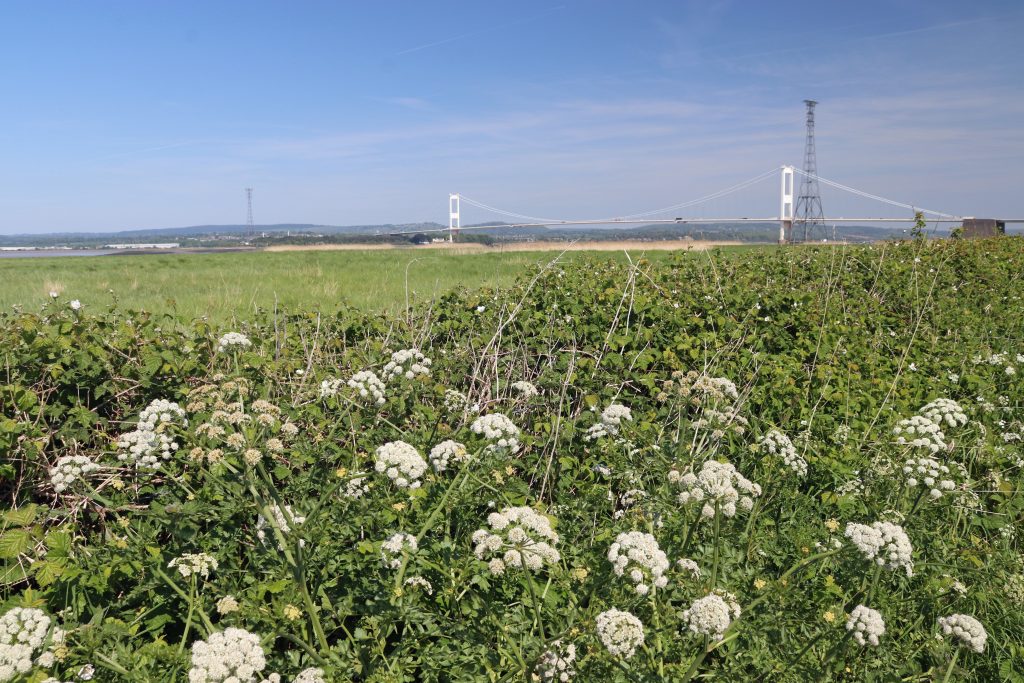
Photo: Floral interest along the way – wonderful hedgerows of wild cow parsley
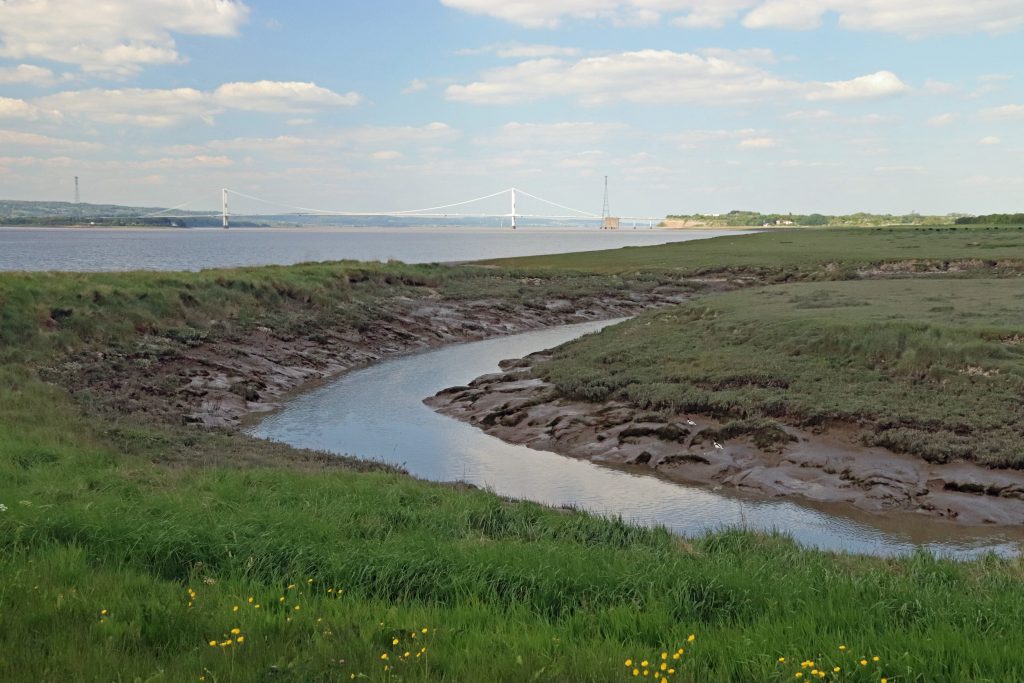
Photo: Chestle Pill at the southern edge of Northwick Warth
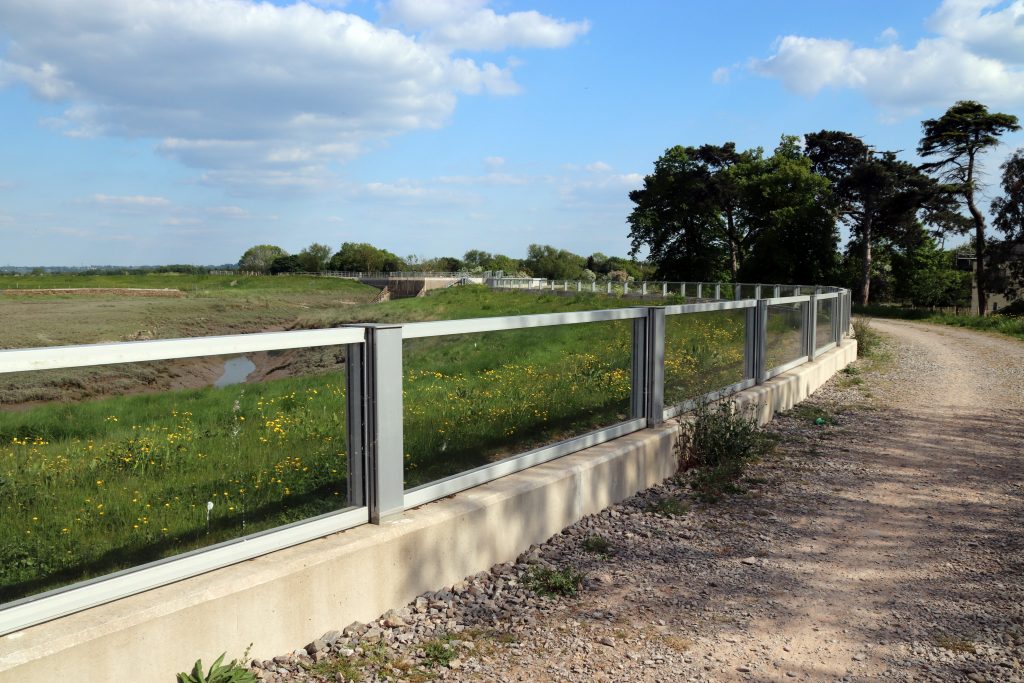
Photo: See-through coastal defences along Aust Wharf Road
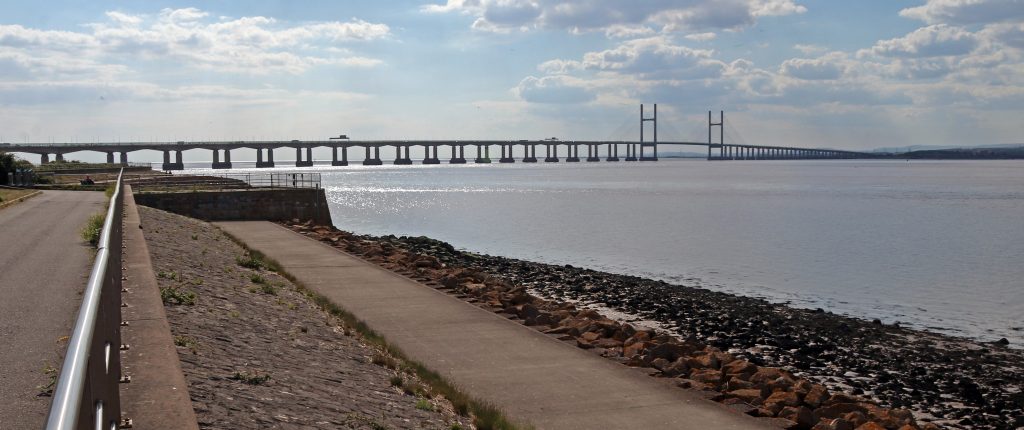
Photo: The remaining stump of New Passage with the Prince of Wales Bridge in the distance
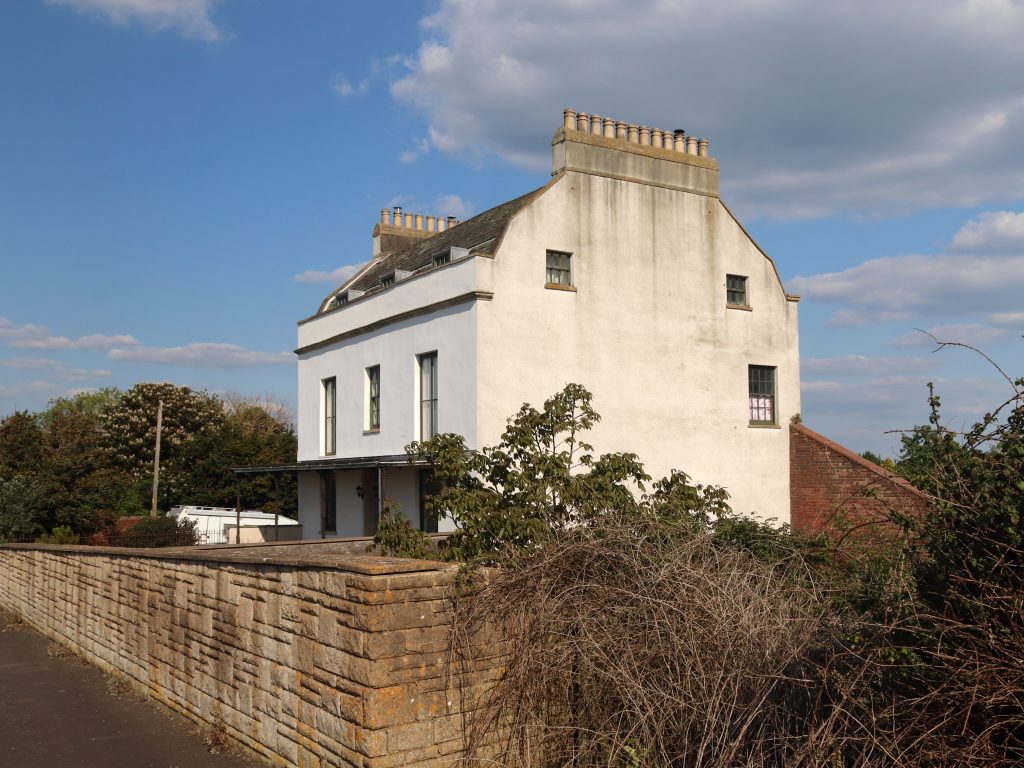
Photo: Severn Lodge Farm, one of the remaining old buildings at New Passage
More recent estuary connections: New Passage & the Prince of Wales Bridge
We continued along the path that runs atop a stark stone-and-concrete sea wall, tracing the line of the old Binn Wall—built in 1815 to replace earlier 17th-century defences. Although its appearance on 19th-century maps might suggest it was indestructible, the Binn Wall has been upgraded and raised several times in response to flooding. Today, the newly improved wall serves as a promenade, offering locals and visitors sweeping views of the Prince of Wales Bridge. As we ambled along, we noticed a small kink in the seawall. Goodness – was this New Passage? It’s certainly nowhere near as eye-catching as the relic structures at Old Passage. However, as we were to learn from the informative plaques and the New Passage Heritage Trail, its history is every bit as fascinating.
New Passage offered a more direct crossing and, although there’d been on-and-off operations here since the early 17th century, it was the arrival of the Bristol and South Wales Union Railway in 1863 that truly transformed its fortunes. Locomotives pulled carriages onto a wooden jetty stretching well out into the estuary, allowing rail passengers to easily board the ferries to Portskewett. Despite this, the crossing was notorious for its harsh conditions. Indeed, Thomas Telford famously described it as “one of the most forbidding places at which an important ferry was ever established.” Delays were frequent – so much so that a large hotel was built for waiting passengers. However, it was the opening of the Severn Tunnel in 1886 which brought ferry services here to an end. The pier was dismantled shortly afterwards. Today few original buildings from New Passage’s heyday remain although, Severn Lodge Farm—once a lodging place for visitors and notable for its impressive twenty-four chimneys— is still a local landmark.
Beyond New Passage, we eventually reached the Prince of Wales Bridge, which was even more imposing at close quarters than at a distance. Amid the roar of traffic overhead, we followed the track beneath the bridge, taking in its immense scale from this dramatic new perspective. Wow! The supporting pillars are indeed huge and the whole structure is so much sturdier than its younger upstream cousin. It’s almost as if the Severn Bridge is the graceful ballerina, and this, the tough, almost invincible rugby player. There were plenty of photo opportunities too as we tried to capture the bridge’s graceful, almost serpentine curves and its striking presence. Then, just beyond the bridge, we spotted the famous iron pipe, which, as Peter Tyzack later explained, is the outfall for fresh water pumped from the Severn Tunnel.

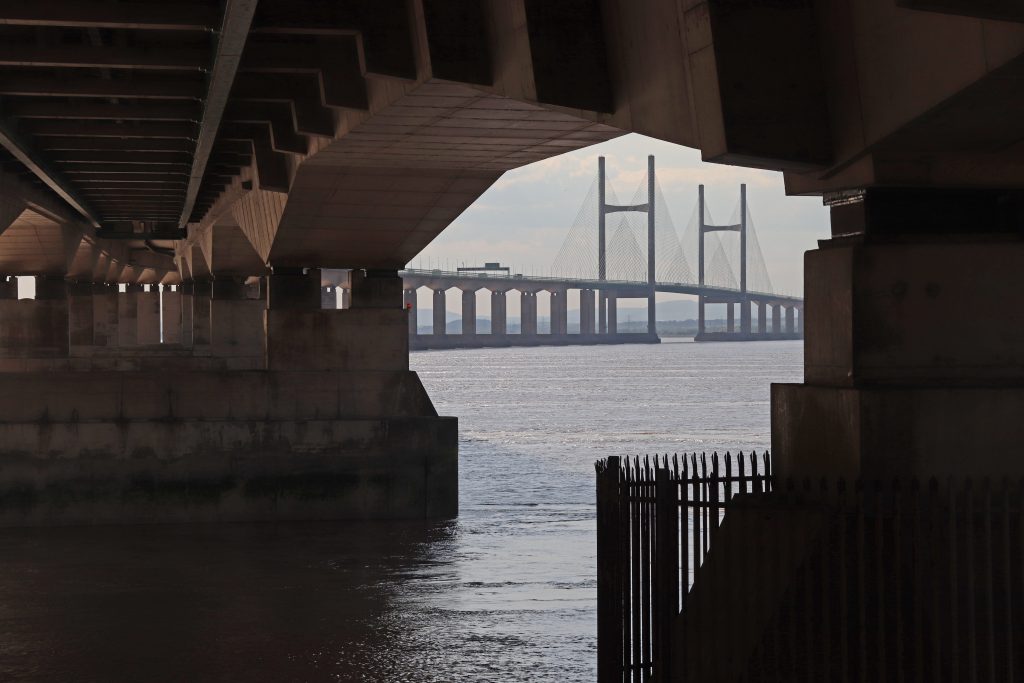
Photo: A new perspective of the Prince of Wales Bridge – from below!
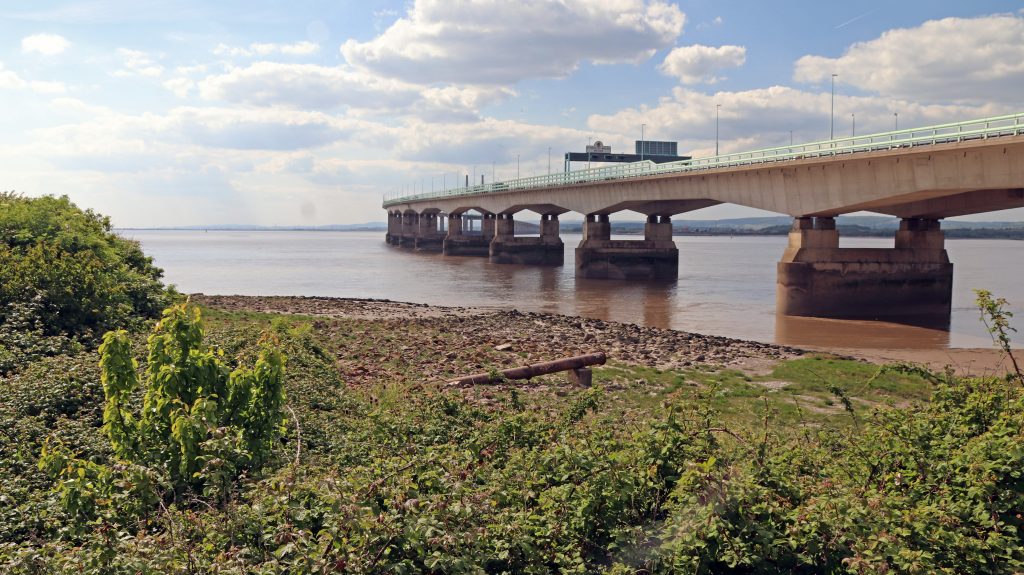
Photo: The outfall pipe from the Severn Tunnel with the PoW Bridge behind
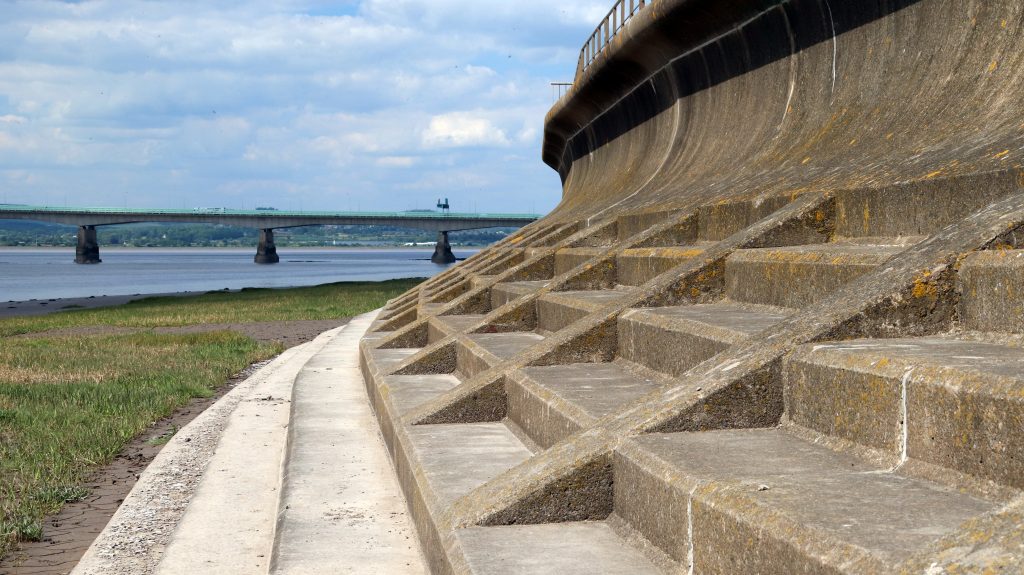
Photo: The green shore fronting the sea wall at Severn Beach
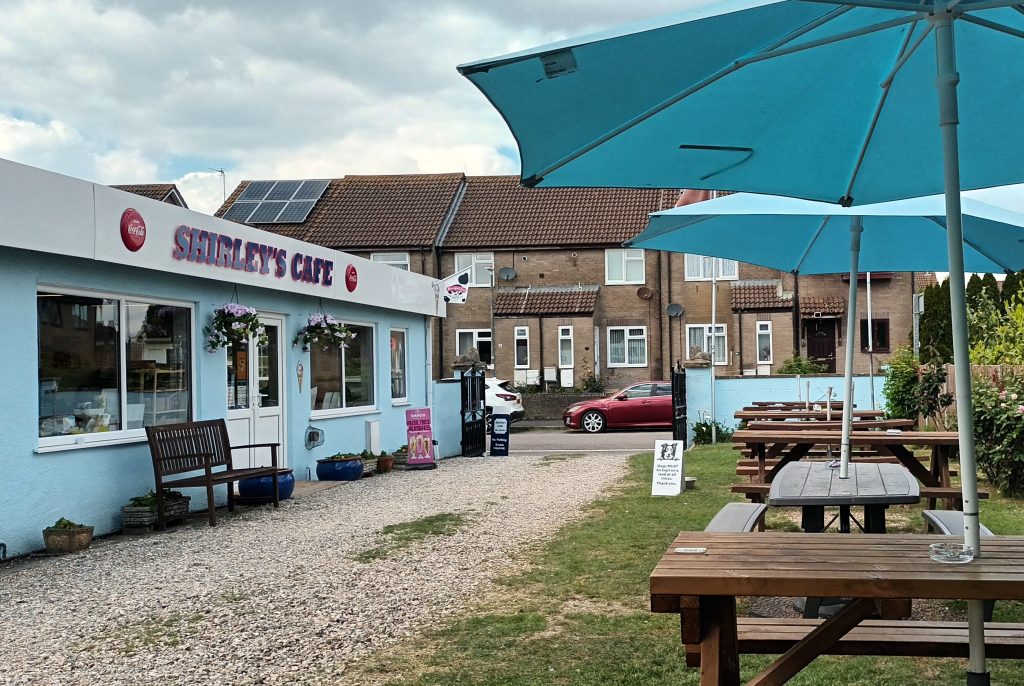
Photo: Shirley’s café – almost the sole reminder of Severn Beach’s heyday as a seaside resort

Severn Beach – Seaside tourism, suburbia and industrial change
Following the promenade, we were joined by a growing number of fellow walkers as we approached Severn Beach. I was slightly disappointed, though not at all surprised, to find it wasn’t a traditional, touristy beach. After all, this is the Severn Estuary! Instead, mud, shingle, saltmarsh and even more mud. A great haven for wildlife and birdlife though, not that we had time to study these now, having spent more than a few minutes en route gathering elderflowers to make my annual cordial. We couldn’t miss the hulks of driftwood—entire tree trunks—strewn along the shore, stark reminders of why such substantial sea defences are needed here. Nestled, perhaps even cowering, beneath the towering defences, rows of neatly laid-out modern housing estates stretched as far as the eye could see.
Severn Beach once truly lived up to its name, drawing thousands of visitors each summer—as we learned from the display inside Shirley’s Café, one of the few remaining buildings from the village’s heyday as a seaside resort. It even aspired to be the Blackpool of the Southwest! Thanks to the vision of local entrepreneurs and the opening of the station in May 1922, Severn Beach became the go-to place for day trips for people from Bristol and beyond. Development opportunities, akin to those along the Costa Blanca in the 60s, were suddenly unleashed. A grand hotel, cafés, pubs, shops and wooden bungalows sprung up. Attractions, including a fun fair, boating lake and the much-loved Blue Lagoon swimming pool, alongside donkey rides, beauty contests and dance competitions drew in the masses. There were a few issues, however—local hearsay claims that the sand brought in to improve the shingle beach was washed away by the first high tide. Then, after a highly successful second season in 194, the highest tide in over a decade caused widespread damage, turning wooden bungalows into floating houseboats. It was, however, the development of the motor car and the rise of foreign holidays in the 1960s which caused the resort’s final demise. The boating lake and Blue Lagoon were demolished in the 1970s, ironically making way for improved sea defences to protect the growing number of houses in the area.
Val and Peter, like much of the local community are certainly proud of the area’s history. We followed Val’s local history group’s heritage trail, discovering a series of informative plaques and locating key sites from the resort’s past, including the boating lake and Blue Lagoon—now peaceful, grassy seafront areas. With the current popularity of open-air swimming, some residents might hope to see the lido restored. For now, the resort’s revival includes the recently refurbished (2018) Tea Cottage and the anticipated opening of the Severn Beach Miniature Railway, later this year.
Standing at the end of the promenade, looking toward Avonmouth as our walk concluded, we took in a starkly different, more industrial landscape—where wind turbines, chimney stacks, and large factories dominate the skyline. Peter notes this area has changed quite considerably over the last few decades. Thanks to major investment in improved transport infrastructure, this area has been transformed into a key energy hub. It now hosts the 1,140 MW Seabank gas-fired power station and the Severnside Energy Recovery Centre, which converts waste into electricity enough to power roughly half the homes in South Gloucestershire. According to Peter, there’s an old outfall pipe from the 1960s Imperial Chemical Industries (ICI) Severnside Chemical Plant and fertilizer factory, which operated until the early 1990s. Apparently some of the foreground isn’t natural: Peter explains that much of it is made up of demolition waste, likely dumped there cheaply and conveniently to serve as a basic sea defence. He also notes significant accretion along the coast here, especially since the construction of the Prince of Wales Bridge. I wonder: was this an intended effect, or a lesson we should consider for future large infrastructure projects in the estuary?
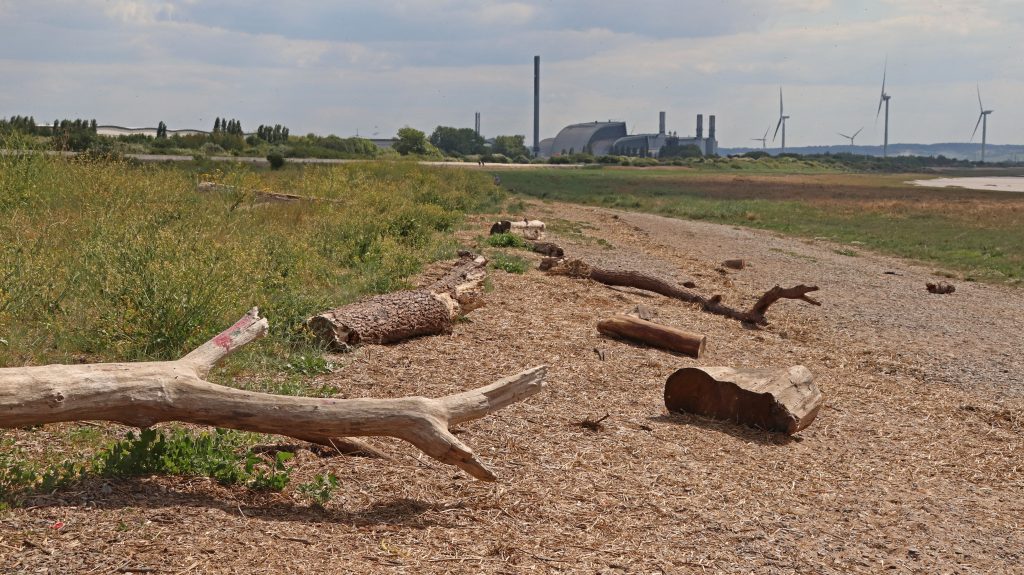
Photo: looking across the foreshore at Severn Beach towards Avonmouth


Photo: My Severn Beach/Pilning 2025 Vintage Elderflower Cordial
Further reflections and conclusions
Once again, it had been a fun and fascinating day out. What’s truly interesting is not only how much this stretch of coast has changed over the past century, but how quickly and dramatically the economic fortunes of individual communities have shifted—especially with the arrival of major transport infrastructure. While New Passage and Old Passage were made obsolete almost overnight by the Severn Tunnel and Severn Bridge, the opening of a station at Severn Beach transformed a quiet rural area into a bustling seaside resort nearly as rapidly. The impact of the longer-term economic development of the Avonmouth Severnside Development Area on this stretch of coast is perhaps a little less tangible, although demand for housing is obvious, and concerns about the possible impact of ‘huge warehouse construction on the water table’ trouble Val.
Wherever you go along the estuary, there are countless stories to be told. From my experience, you’ll always find proud locals eager to share their knowledge, concerns, and passion for their stretch of coast. The journey from Aust to Severn Beach has been no exception—both Val and Peter shared far more information than I can do justice to here. Val’s deep enthusiasm for local history and Peter’s genuine love for living on this wild coastline were truly inspiring.
Despite Val’s worries about flood risk, I’m confident that the major investments behind the ASEA Ecology Mitigation and Flood Defence Project and the new South Gloucestershire nature-recovery initiative, Linking the Levels, will help secure a bright future for this coast and its communities. Meanwhile, I have a few bottles of homemade 2025 vintage Severn Beach/Pilning elderflower cordial to enjoy—a perfect reminder of another special day spent exploring the Severn.

Further information
The New Passage and the Pilning wetlands
Severn Beach Circular via Aust and Northwick walk
Explore the New Severn Estuary Biosecurity Plan
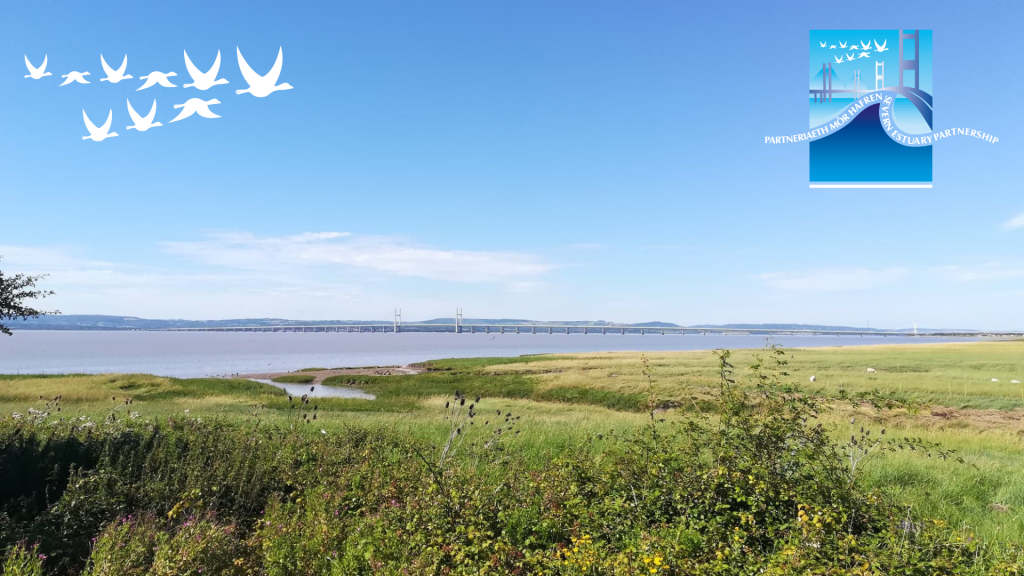
This year, to mark Invasive Non Native Species Week, we are excited to announce the launch of the Severn Estuary Biosecurity Plan—a collaborative and proactive strategy designed to address the growing threat of Invasive Non-Native Species (INNS) across the Severn Estuary.
This plan represents a united effort to safeguard one of the UK’s most dynamic and ecologically significant estuarine environments, recognised for its nationally and internationally important habitats and wildlife.
Led by the Severn Estuary Partnership, and funded by Natural England and Natural Resources Wales, the Biosecurity Plan has been co-developed with a wide network of stakeholders, including local authorities, marine industries, environmental NGOs, and recreational user groups. The Severn Estuary Partnership would like to thank all the individuals and organisations who dedicated their time to developing this plan in our workshops and one-to-one sessions.
The plan takes a pathway-based approach, targeting the main routes by which INNS are introduced and spread. It focuses on six priority sectors: recreation, angling, commercial operations, marinas, habitat and species restoration and field research and monitoring.
To support implementation, this dedicated online resource is hosted on the Severn Estuary Partnership website. This includes sector-specific guidance, practical tools, and actions to help make biosecurity more accessible, effective, and embedded in day-to-day activities.
Looking ahead, the next phase will include targeted outreach and training sessions, monitoring and evaluation of uptake and effectiveness and continued support for local users and stakeholders to adopt and champion biosecurity best practice.
To explore the full plan, access resources, or get involved, visit: www.severnestuarypartnership.org.uk/biosecurity/ or email us at severn@cardiff.ac.uk
To learn more about Invasive Non Native Species Week, click here.
Newport Wetlands – great expectations from a post-industrial landscape
Written by Dr Rhoda Ballinger, SEP Chair
In my April article I explain what’s so special about the RSPB Newport Wetlands Reserve, the ‘jewel in the crown’ of the Gwent Levels, and discovers some of the fascinating history and archaeology of the coastal landscape around Goldcliff.
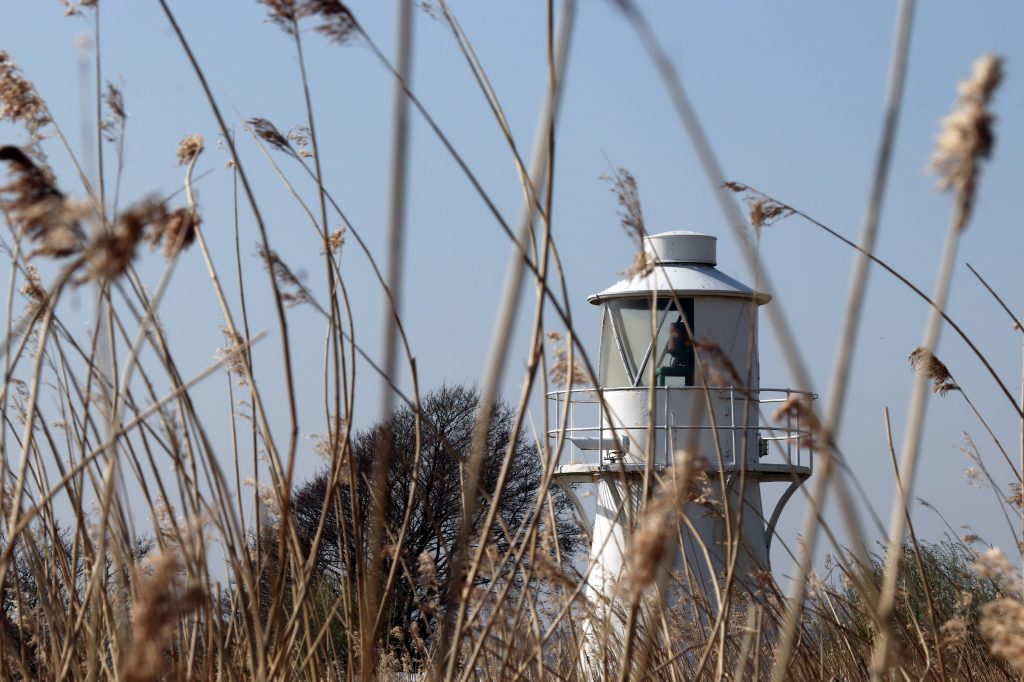
East Usk Lighthouse
Introduction
Only a month ago, there were major celebrations to mark the twenty-fifth anniversary of the construction of the RSPB Newport Wetlands Reserve. Created from heaps of polluted ash from the nearby Uskmouth Power Station, this conservation site was part mitigation for the loss of intertidal habitats caused by the creation of the Cardiff Bay barrage. Amazingly enough, the National Nature Reserve is now frequently viewed as the ‘jewel in the crown’ of the Gwent Levels and is famous for its shrill carder bees and its booming bitterns, amongst many other species.
Keen to put my recently acquired knowledge from a RSPB winter wader ID course to the test, and with ‘great expectations,’ I headed out with Geoff, my husband, to the reserve at the western end of the Caldicot Levels. We planned to explore some of the reserve as well as the coast around Goldcliff, famous for its historical and archaeological significance as well as its nature conservation value. And, once again, I’m delighted to be able share some comments from a local person with in-depth knowledge of and enthusiasm for the area in my article. Mike Pointon is a keen amateur naturalist with a particular interest in birds, who founded the Friends of Goldcliff Lagoons back in 2014. He’s not only worked alongside others to improve facilities for birdwatchers but also leads walks and has carried out monthly WeBS and hightide counts at the lagoons.
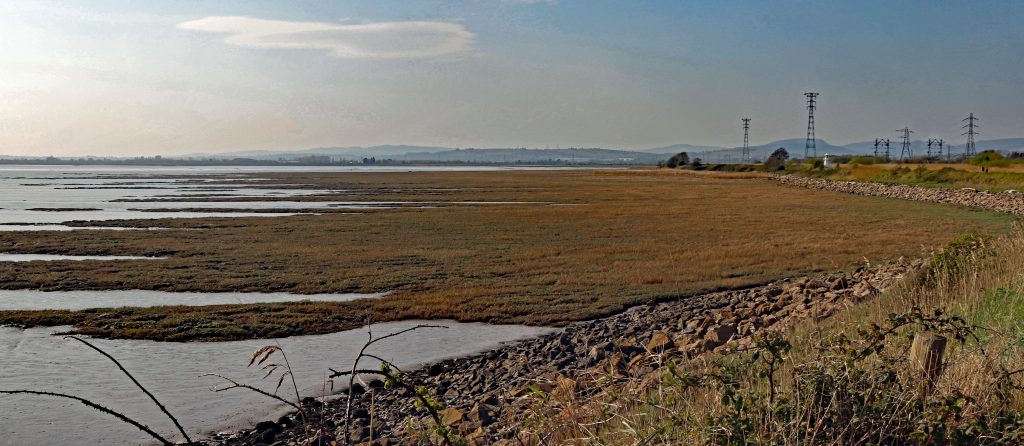
Extensive intertidal marshes, east of the Usk
The Reserve
As we planned the details of our walk in the coffee shop in the Visitor Centre at the start, the first avian challenge momentarily appeared – a distant dark speck flitted amongst the reeds at the far end of the pond. The elusive creature darted between the reeds, testing the limits of my DSLR camera’s zoom lens and a rather basic pair of binoculars we’d bought. The bird appeared quite small and possibly fluffy. Perhaps it was a baby bird? It was on its own, though, and it certainly didn’t resemble any of the species I’d seen on my bird ID course. Eventually, it swam closer. It continued to scurry nervously from one clump of reeds to another, teasing its small audience of onlookers inside the cafe. Eventually, it posed for a short while in front of us, giving me just enough time to capture a quick photo. Then as quickly as it had emerged, it disappeared into the reeds at the far end of the pond, having completed its morning performance. It was a little grebe. Well, I think it was. Certainly, so much smaller and fluffier than the great crested grebe which I’d recently seen gracing the waters of the Lisvane Reservoir in NE Cardiff. Wow! If that was the overture, what was the main performance going to be like?
We eagerly ventured along the waymarked paths into the reserve to do a hybrid walk, encompassing part of the ‘Wetlands Experience’ and the ‘Estuary Trail’ so we’d also be able to see Goldcliff as well on our short visit.
As we walked towards the shore in the reserve, we were surrounded by a sea of golden reeds, wafting gently in the breeze. Ribbons of vibrant green new growth edged the long unnaturally straight water areas which gleamed bright blue in the sun. Apart from a squishing sound as we walked across a floating pontoon amidst the reeds, it was relatively calm and peaceful. Perhaps a little too calm and peaceful? We stopped at various lookout posts where information boards tantalisingly displayed a range of possible birds we could encounter. No birds in sight today though. Hmmm. Overhead the towering pylons and power cables dominated the skyline and were reminders of the adjacent industrial site and the area’s continuing importance for power generation. Still no birds. The forbidding industrial backdrop, the scene for several episodes of Doctor Who loomed large behind the haven of the reserve. Still, no birds….
Then, just as we were about to move on, a few large birds swooped down and landed on the water in front of us. Certainly not a flock, but at least a handful of birds. And … they were easily recognisable! Canada geese! May be a grade one entry though, given their prevalence across our shores. However, as I found out later, they’re not a native bird, having been introduced from North America some 300 years ago. After some rather amorous advances between a couple of these geese, all too brief for my camera skills, I was able to capture some shots of these elegant birds, including the one here.
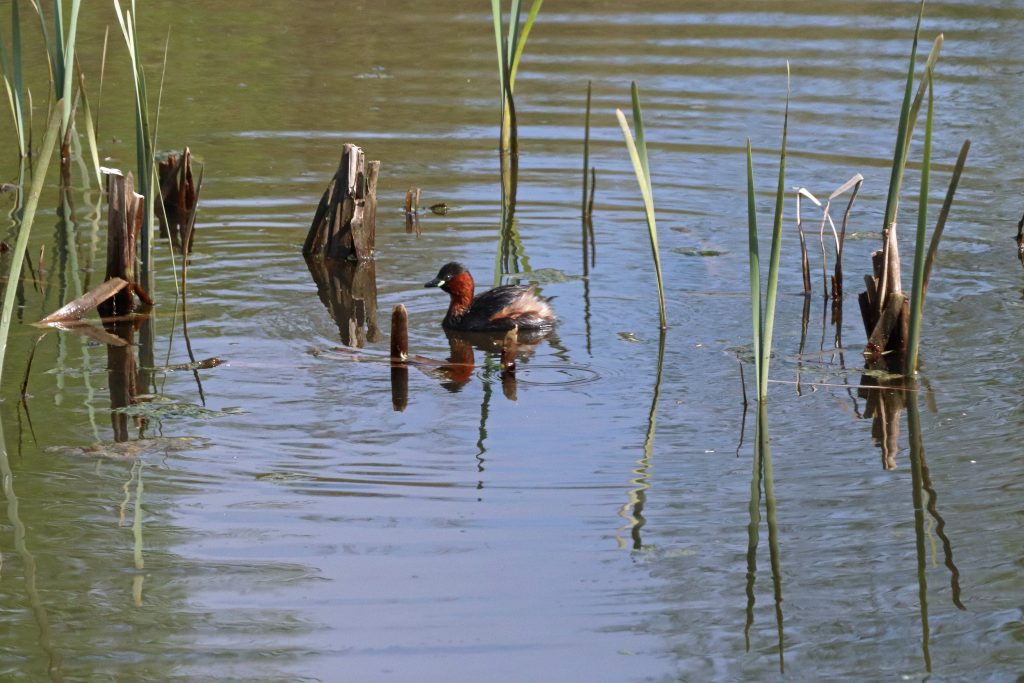
A little grebe entertains the café clientele
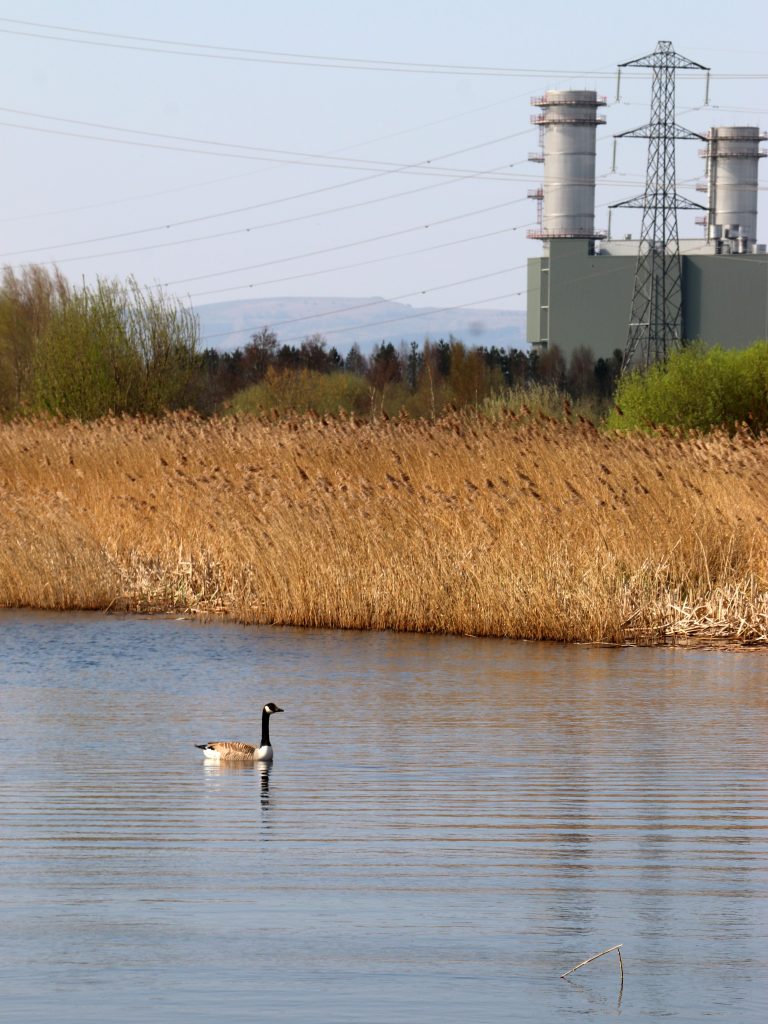
Canada goose on the reserve

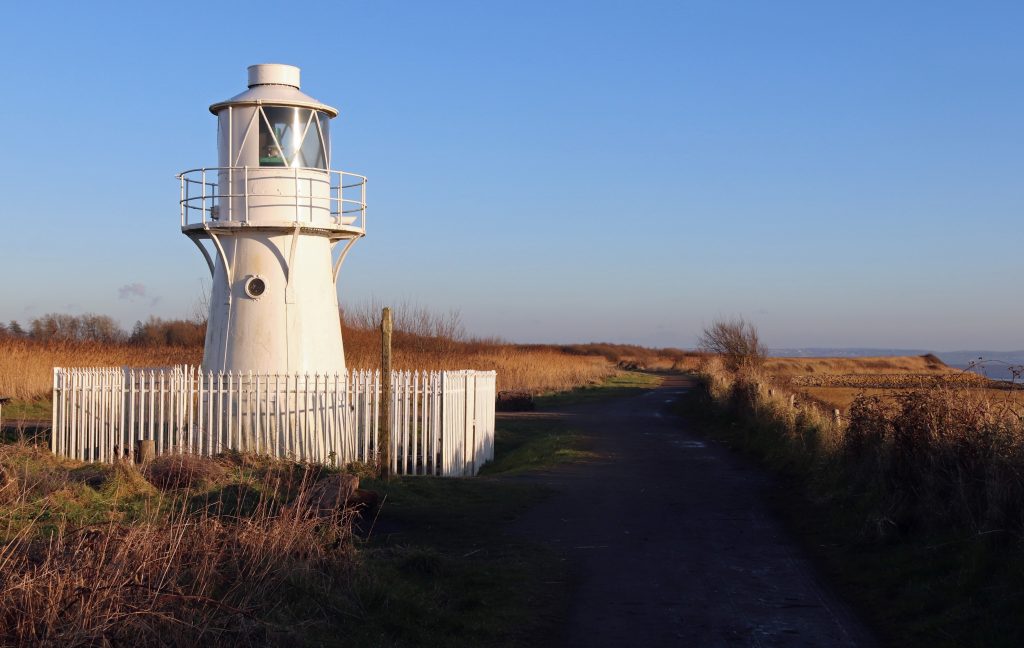
East Usk Lighthouse
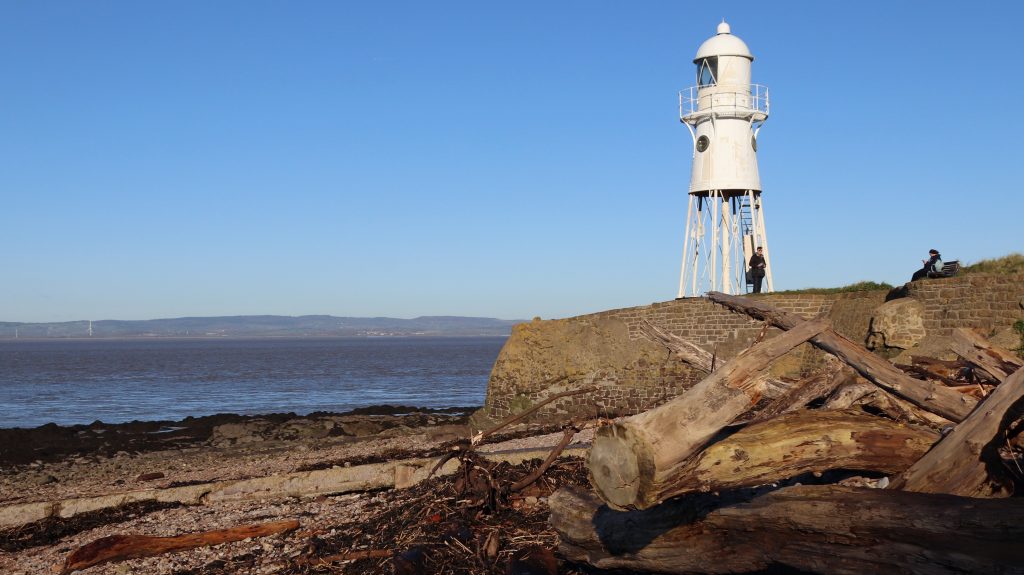
Blacknore lighthouse at Portishead
Walking further towards the shore, the lighthouse beckoned. However many times I’ve been to the reserve, I always seem to find myself clicking away, trying to capture a new camera angle and avoid that iconic, some might say, rather hackneyed, image of the lighthouse. Oh dear… yes, that’s my cover photo! On today’s visit, however, the ‘white cone on the water’s edge’ as Peter Finch describes it, was looking particularly fine in the golden light and seemed as popular as ever with the visitors. Glistening white, protected by its very own picket fence, this somewhat diminutive lighthouse looked more as if it belonged in a model village rather than being a working lighthouse. This is the East Usk Lighthouse though, and its light provides a vital navigation aid to ships approaching Newport. Indeed, its importance goes beyond that. It was the first Trinity House lighthouse to use a special valve, enabling the light to turn off and on remotely just using daylight. The most striking aspect to me though on our visit today, was the lighthouse’s resemblance to the Blacknore Lighthouse on the other side of the estuary at Portishead, where I’d visited only a couple of months ago. Back when the East Usk lighthouse was built in the late nineteenth century the structures would have been near-identical twins. Now, following tonnes of disposal of fly ash from the Usk Power Station which buried the legs of the East Usk lighthouse, they’re merely distant cousins!
From the raised embankment at the seaward edge of the reserve, the marshes stretch out as finger-like protrusions into the estuary’s mud. More bird-watching possibilities? Much to my excitement and relief, even with our limited apparatus, we could immediately distinguish the shelduck from the mallards. Fortunately, for us, they were heads down, enjoying the rich pickings of the newly exposed muds! However, even with their characteristic chestnut stripe and reddish bills, the shelducks are still quite well camouflaged against the russet browns and blue greys of the intertidal landscape. So are the curlews, but with their distinctive long, down-curved bills, we were just about able to pick out the odd one. Then, a few gulls flittered across the sky. They took a sudden turn and wheeled and glided onto the silver muds … unfortunately, just beyond the limits of our magnification. Well, at least our bird count had been reasonable. I’d also been reminded of my previous visit, when, thanks to the RSPB guide’s telescope, I’d seen scores of curlews and lapwings jam-packed at the water’s edge here as the tide was receding. Despite our show today and these memories, I was still a little envious of Mike’s memorable moments. These include doing early morning Bearded Tits surveys at Uskmouth and hearing ‘Reed and Sedge Warbler singing, perhaps even a Cuckoo calling and a Whitethroat and singing its rasping courtship song as it dances along the hedgerow’, all ‘whilst the mist rose above the reedbeds.’
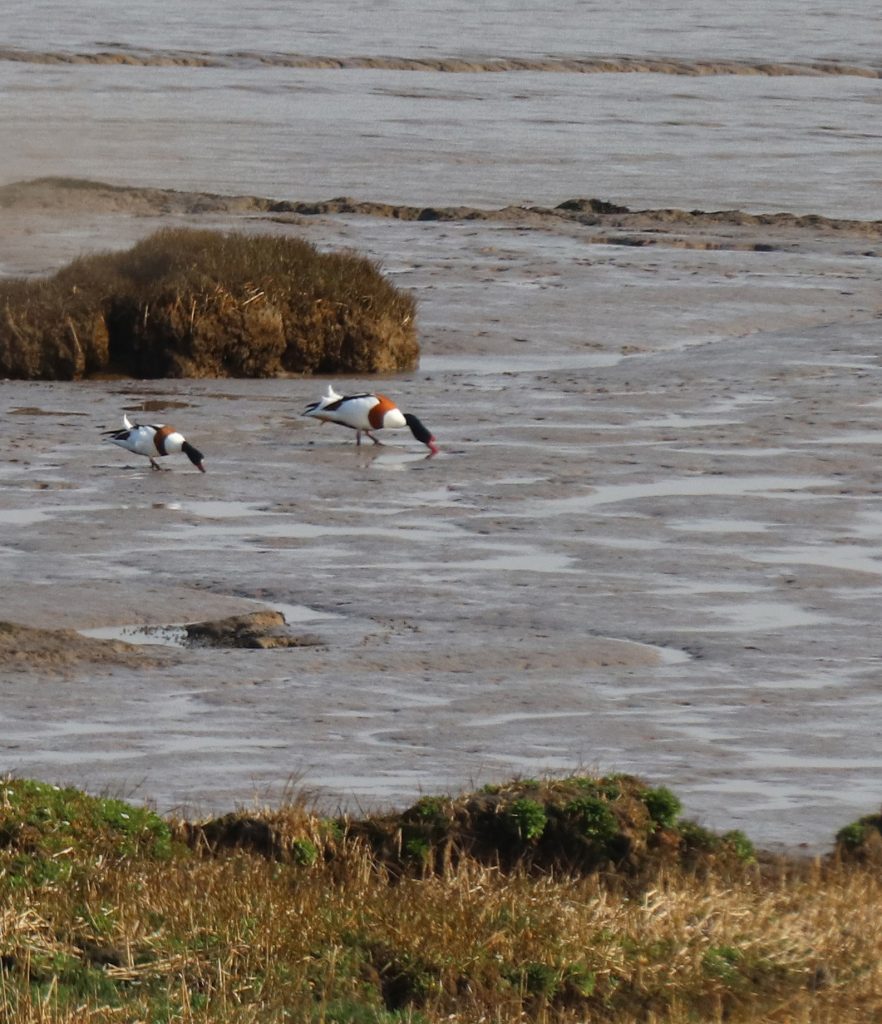
Shelducks feeding on the rich intertidal muds
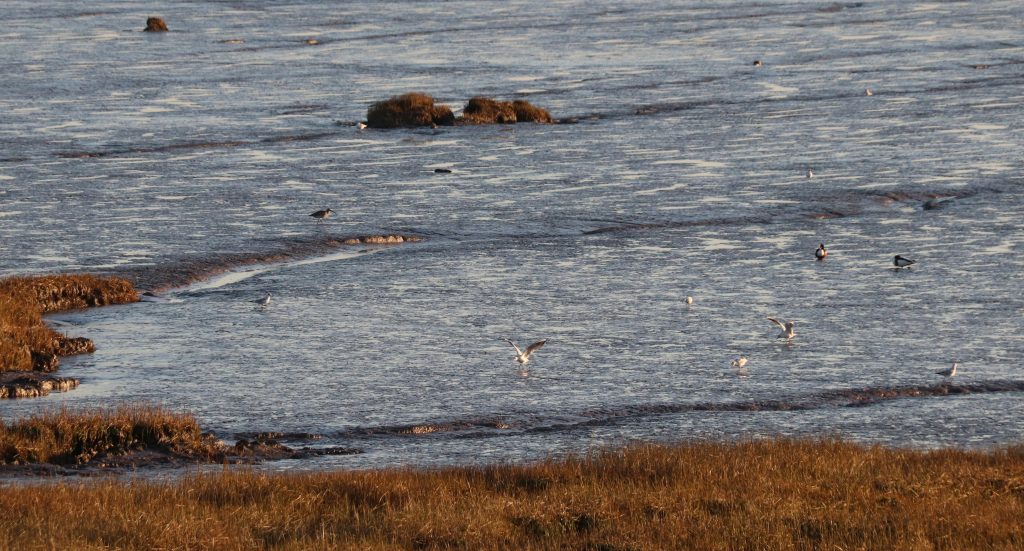
The white specks of coastal birds (gulls, shelducks and a curlew) on the silvery muds
Before we turned back to go on to Goldcliff, we strolled a little further along the coastal path, enjoying the ever-changing shoreline. The West Usk Lighthouse, which once marked the western entrance to the Usk river channel for ships heading to Newport docks, was just visible. Much more noticeable was the massive strandline. This coronet of gnarled driftwood encircled the entire coast, following the base of the embankment. The sheer scale of the mighty tree trunks engulfed in the debris were a stark reminder of the power of the winter storms which have plagued those inhabiting these shores over the millennia. Expecting to see today’s plague, plastic and other litter, I was very pleasantly surprised: there wasn’t any! I found out later that there’d been a litter pick by staff from Natural Resources Wales (NRW) and RSPB only a week or so before as part of Spring Clean Cymru when bags and of bags had been collected.
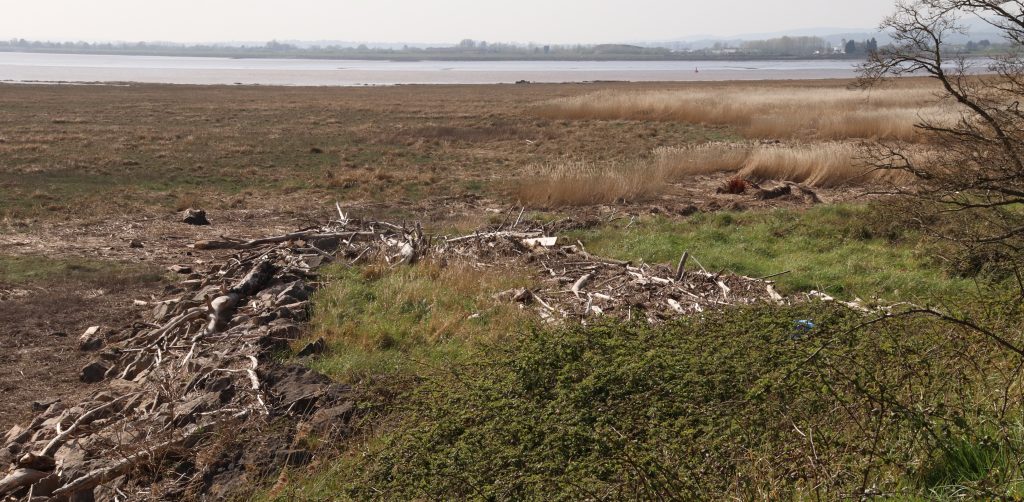
Looking towards the Usk a prominent strandline backs extensive intertidal marshes
The Goldcliff shoreline
We then wove our way along narrow lanes towards Goldcliff between a patch work of fields lined with deep and dark drainage ditches, a legacy of the Romans and the medieval monks who’d captured and tried to tame this watery landscape from the sea. No environmental impact studies in those days, just the need to provide valuable agricultural land to survive.
Then a small incline gradually came into view. This was the famous Goldcliff, a ‘rocky eminence’ which had caught the attention of the celebrated medieval cleric and celebrated travel writer, Gerald of Wales/Giraldus Cambrensis back in the twelfth century. In Gerald’s account, he’d noted that ‘when the sun’s rays strike it, the stone shines very bright and takes on a golden sheen’ and he’d even suggested that the ‘skilled’ might ‘dig down into the mineral deposits to extract sweet honey from the stone and oil from the rock.’ Centuries later, on our visit, there was no honey, oil nor indeed any gold. Only the rusting plinth of the old Goldcliff lighthouse provided a dash of colour, but even that looked in a sorry state, having lost its lantern in recent years. Not quite the magical place I’d hoped for. A substantive seawall skirts around the cliff and obscures seaviews. Any remains of the old Goldcliff Priory lie were also well hidden within ‘Hill Farm’, behind the sign reading ‘private property, keep out.’
Still, there was a great view from the cliff top and indeed also from the seawall which doubles up as the track of the Wales Coastal Path. Sites of previous walks, wind turbines, docks, piers and even the Prince of Wales Bridge were just discernible across the hazy estuary. Today, however, our attention centred around birds. There were a lot to see – gulls, mallards, shelduck and the odd curlew wading across the foreshore. Perhaps my bird ID was improving after all. Then in flew a flock of seabirds. They swirled and swooped in unison high above our heads before plummeting down to momentarily settle on the distant mudflats. They took to the air again. As the flock twisted and turned, shafts of sunlight caught their plumage. Constellations of seabirds lit up the sky. What a performance and all so amazingly choreographed. I’m just sorry I couldn’t capture any of it on camera or indeed identify the birds themselves.
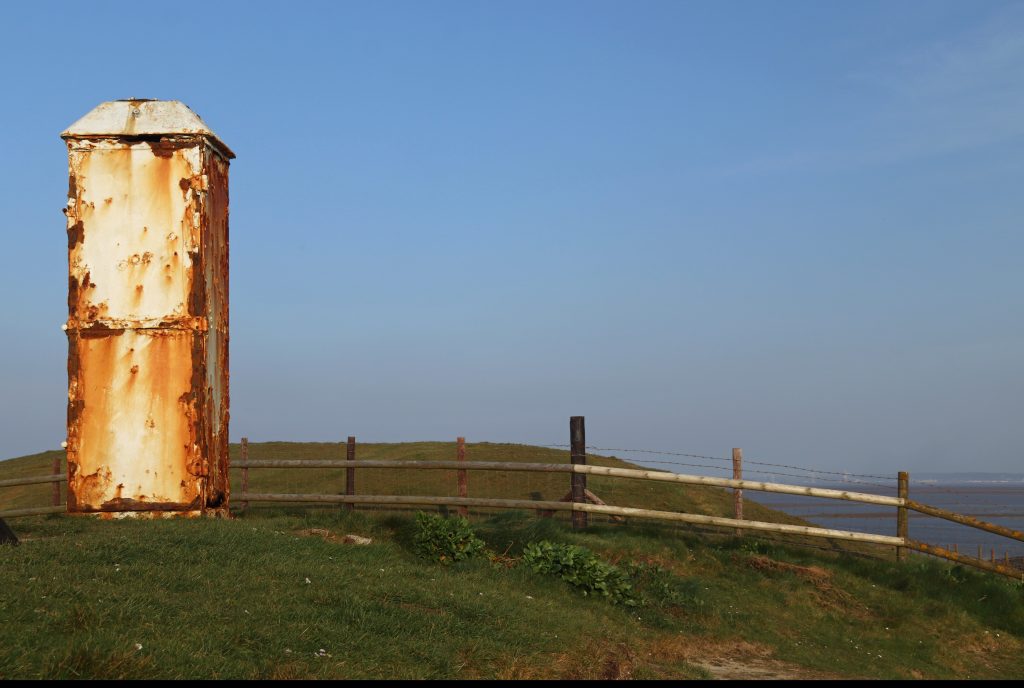
The only ‘gold’ at Goldcliff – the rusting lighthouse plinth perched on the top of the cliff
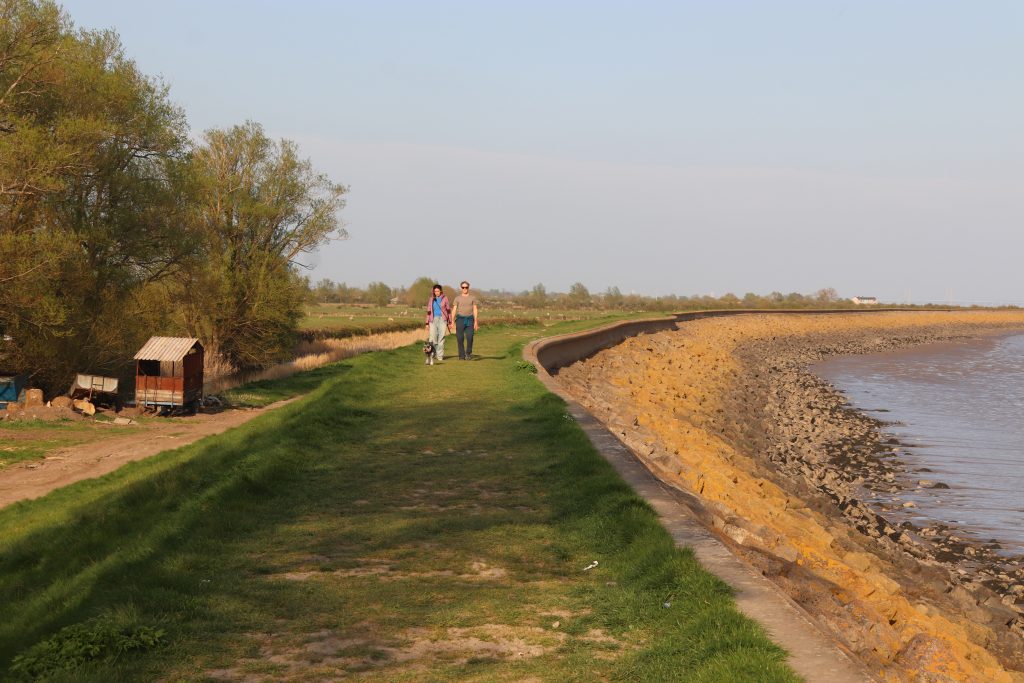
The seawall at Goldcliff

As the sun began to sink lower in the sky, a spider’s web of rivulets and channels appeared across the silvery muds and serried ranks of ancient timber poles cast long, dark shadows across the foreshore. The metamorphosis continued until the seascape resembled a scene from a John Piper lithograph, though sadly I don’t think he ever captured this stretch of Welsh coast. This was most certainly the ‘subtle landscape of land and water, a landscape sculpted by hand and time’ as described by Richard Urbanski in his account Walking the Gwent Levels. In the past, a clear calm early April day would have been an ideal time to check over the wooden frames, the putcher ranks, just prior to the start of the summer salmon fishing season. By late April there’d have been hundreds of putchers, willow baskets, full of fish which had been trapped by the previous tide. Last century the fishery declined though and finally ceased in the 1990s, marking the end of millennia of fish- trapping on the estuary. Indeed, those traps we were looking down on are thought to be of medieval origin, at a time when Goldcliff Priory was at its prime. However, the remains of considerably older fish traps (4000 BC) as well as footprints of Mesolithic age have also been discovered in the muds here and elsewhere on the estuary. How many more secrets of the tide might lie out there waiting to be discovered?
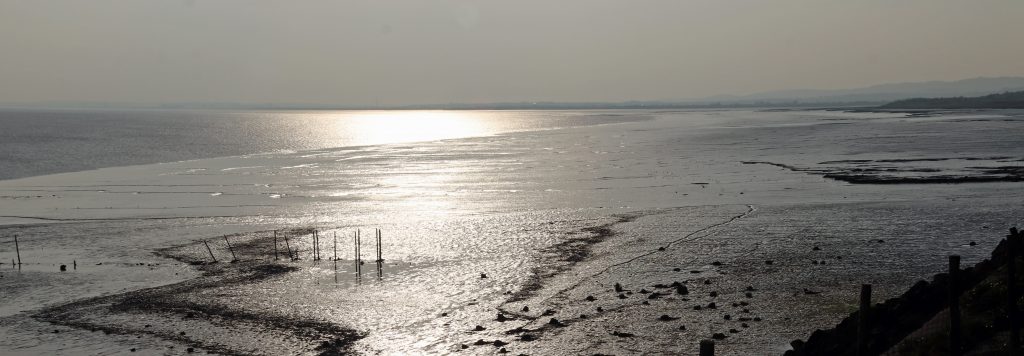
The silver shore from Goldcliff
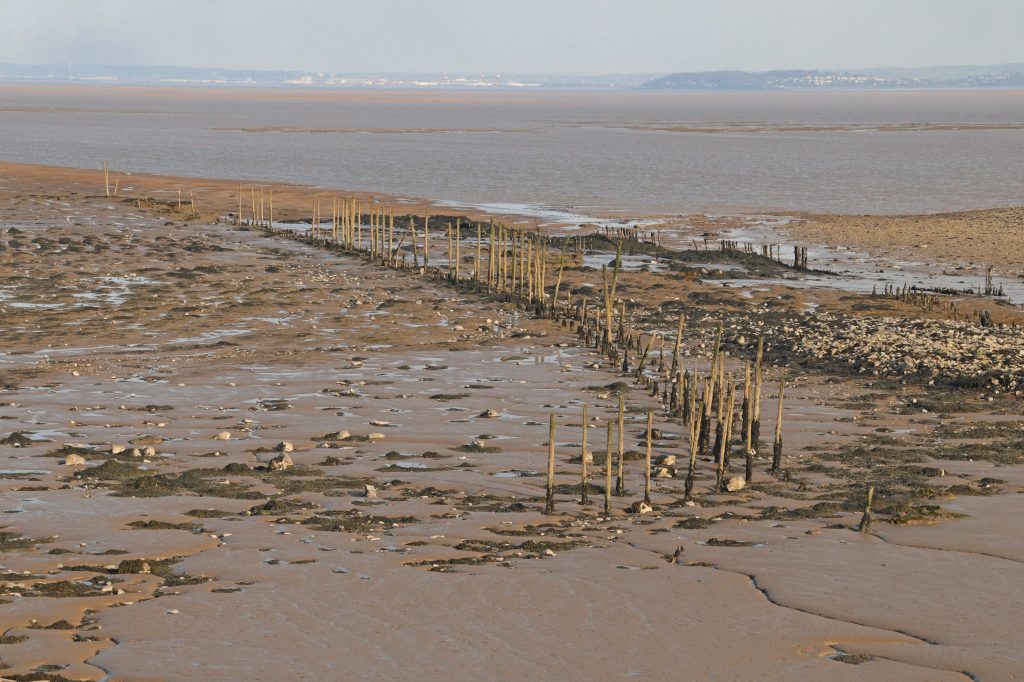
Ancient putcher frame stretching across the foreshore at Goldcliff
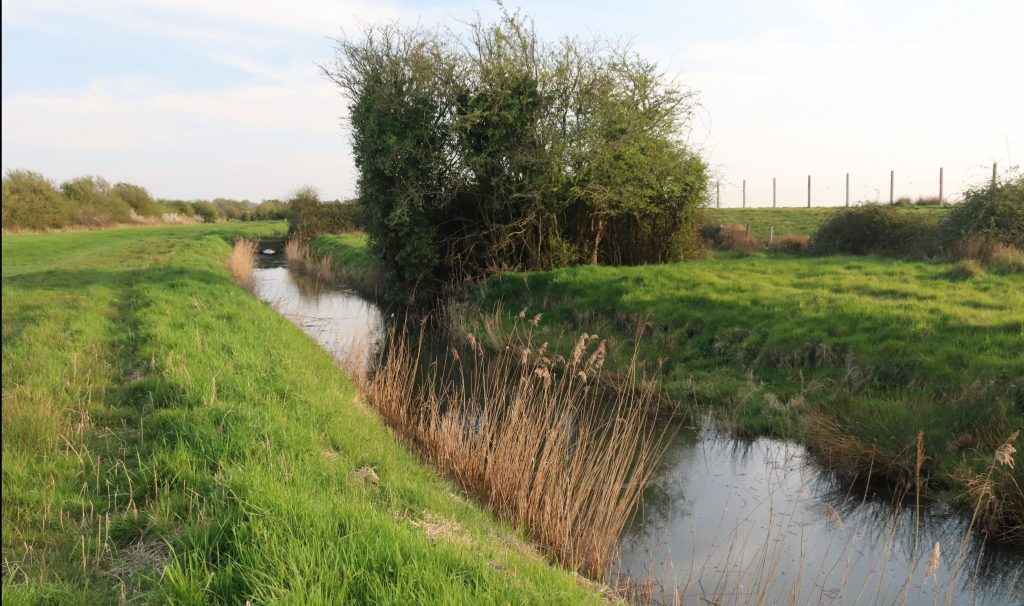
Mireland Pill Reen, one of many large drainage ditches across the Levels
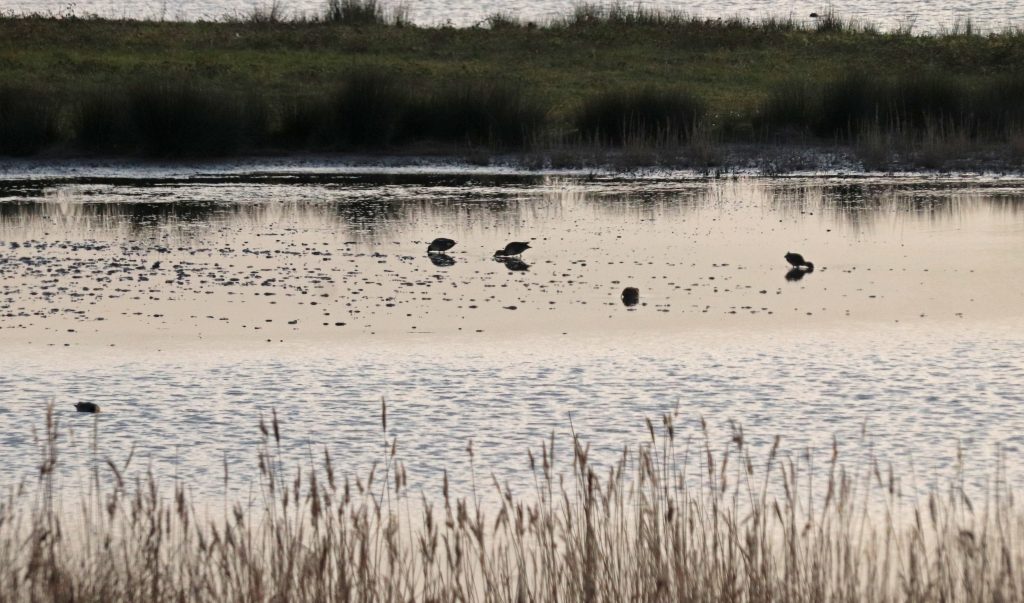
View from Hide 1 into the Monks Lagoon, Goldcliff
The Goldcliff Saline Lagoons
On to the famous Goldcliff Lagoons, a birder’s dream and one of Mike’s favourite birding locations. Mike particularly savours his ‘memories of watching the courtship displays of the waders here’ as well as ‘witnessing the birds on migration in autumn’. A birders’ website had previously informed me that its ‘almost always packed with waterfowl and waders throughout the year’ and provides a list of ‘nice birds that can be seen’ including the Little Grebe, Avocet, Dunlin and Little Egret. However, by now, with the rapidly fading light and our limited previous successes earlier in the day, my expectations were modest at best. We scuttled along the path by the Mireland Pill Reen, an impressive reminder of the ‘hand-crafted’ landscape of the Gwent Levels to reach the saline lagoons. Today, sadly, we’d no time to contemplate the wonders of this historic landscape and the feats of generations of engineers who’d claimed and reclaimed these precious agricultural pastures from marine inundation.
Our last stop merely consisted of a short foray into the very spacious and well-constructed hide. Hide 1, The Curlew Hide, overlooks the Monks Lagoon. Given the low light and the considerable distance between us and the birds, it really was bird spotting – the birds, mere spots, were hardly distinguishable against the darkening background. A frustrating wire fence also impaired our view and taking photographs. However, as we were just about able to pick out some waders with long curved bills …may be curlews? Lots and lots of them … but far too far away to photograph. There were also a few other types of waders tucking into the lagoon’s all-you-can-eat buffet, and so I clicked away and hoped at least one photo would be useable! Hopefully, now we’ve found this place, we’ll go back there with more time to spare and better equipment.
Final thoughts
I’d arrived at the wetlands with great expectations. although I’d neither seen nor heard any of the site’s most iconic species, I’ve certainly grown to appreciate the lure of this special place. Perched on the estuary’s edge, sandwiched between space-age industrial and traditional agricultural landscapes, it’s an unlikely place for such a success story. The original vision in establishing the original site has been more than realised. Thanks to massive engineering works, the installation of a sophisticated drainage system, and years of habitat management (overseen by Natural Resources Wales in partnership with RSPB Cymru and Newport City Council), mounds of pulverised fuel ash have been transformed into a rich mosaic of wetland and other habitats. These now support a wealth of plant, invertebrate and bird species as well as weasels, stoats and otters. There are so many groundbreaking achievements to celebrate – wading avocets, elusive bitterns and rare marsh harriers have all bred here for the first time in many years. Indeed, the reserve’s importance was confirmed through its SSSI and National Nature Reserve (NNR) nature conservation status within the last couple of decades. There are challenges, however, even here, as Mike is keen to point out. He, like many of the other birders, would like to see the area treated ‘in a more nature friendly way’ with dogs banned on the reserve. He’s also concerned about the possibility of ‘tidal power wind turbines disrupting the peace and tranquillity.’ There will always be differing ideas about the future of such precious sites, but I’m pleased to note the extensive attempts to bring the local community’s views into the fore, particularly through the Living Levels programme. Also, the achievements which have been accomplished here would not have happened without the help of armies of dedicated volunteers like Mike, who’ve given up so much time and effort to maintain and improve the site. I’m certainly starting to realise the importance of these volunteers – often unsung heroes at so many sites around the estuary.
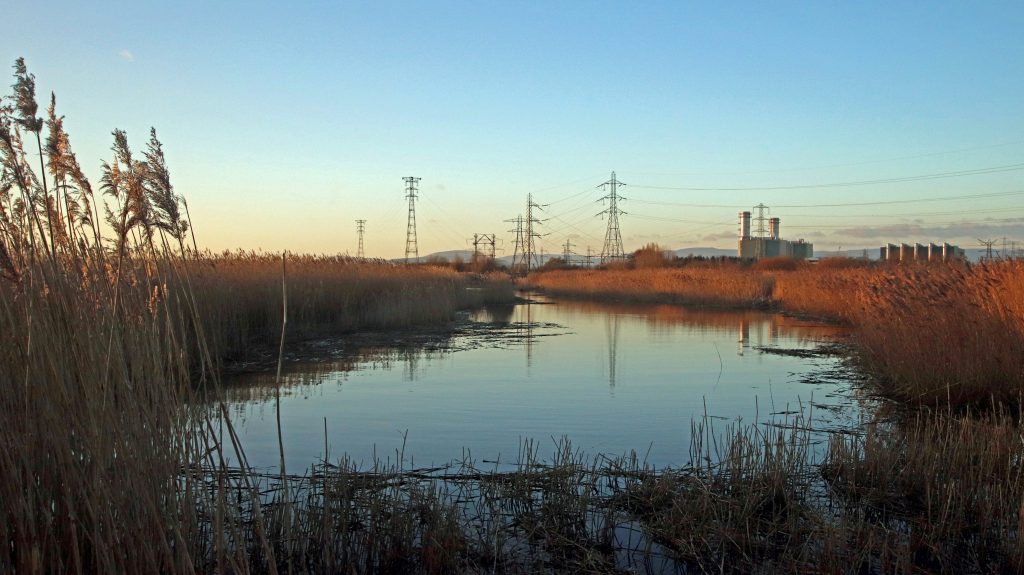
Evening light across the RSPB Newport Wetlands reserve
Apart from the nature recovery achievements at the site, I’m particularly taken by the accessibility of so much of the wetlands here to the public, although Mike warns of the dangers of treating ‘nature reserves as playgrounds for us humans.’ Young parents with pushchairs, older folks with their packed lunches and binoculars, keen birdwatchers with their giant lenses and others are all there. All sharing and enjoying their bit of ‘wildlife.’ There are lots of special events too to introduce you to the wonders of nature here. Even as I’m writing, there’s a weekend of fun activities ongoing as part of the City Nature Challenge. I agree with Mike that we should value such ‘places for quiet contemplation’ but it’s also important that people can experience, wonder and learn from these sites. Indeed, I hope to go down there myself sometime soon again to attend another workshop. However, this site is only part of the story – there’s much more to explore along the Gwent Levels as the Living Levels’ website informs me. Maybe not for my next walk, but certainly I’ll come back to this extraordinary land/seascape soon.
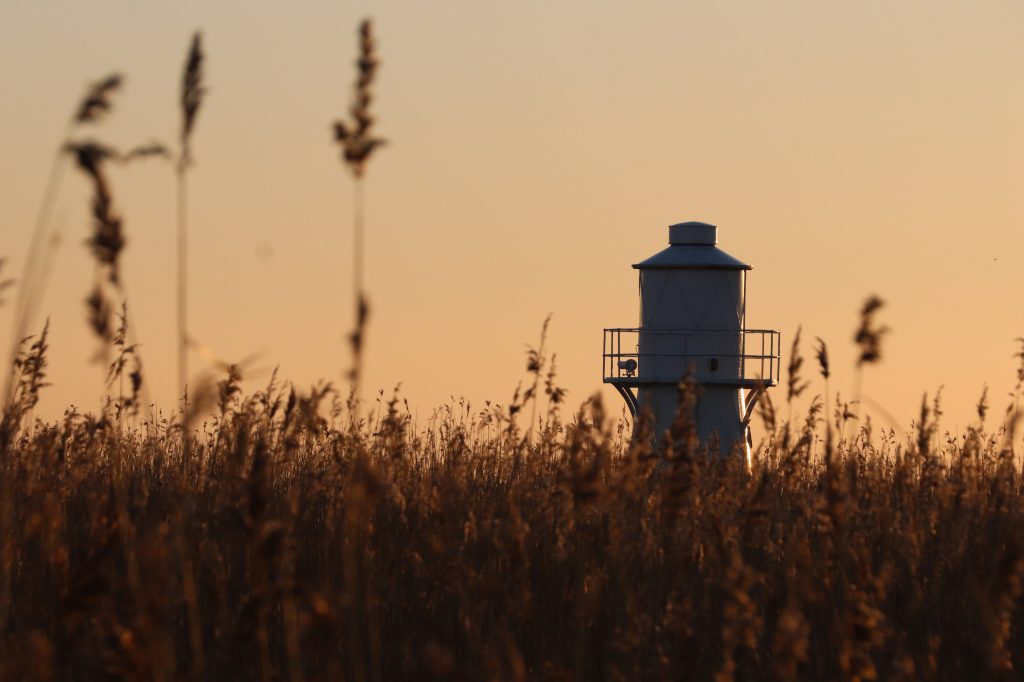
East Usk lighthouse in the evening light
A few websites of interest
Living Levels / Lefelau Byw website
The Newport Wetland and Goldcliff Loop walk
The Gwent Levels – taken the Historic Landscapes Register
Future-Proofing the Severn Estuary: SEP Secures Nearly £1 Million to Support Long-Term Conservation
The Severn Estuary Partnership (SEP) is delighted to announce the award of £992,285 in funding from the Nature Networks Fund to support the new “Future Proofing the Severn Estuary” project. This significant investment will enhance the protection and resilience of the Severn Estuary’s Marine Protected Areas (MPAs), recognised internationally for their unique habitats and biodiversity.
The Nature Networks Fund is delivered by The National Lottery Heritage Fund in partnership with the Welsh Government and Natural Resources Wales. It aims to support nature recovery and improve the condition and connectivity of protected sites across Wales. SEP’s project builds on three decades of collaborative work across the estuary, and this new initiative will play a vital role in delivering SEP’s vision for a sustainable, thriving Severn Estuary.
Strengthening Biodiversity, Engaging Communities
This funding will enable a wide range of initiatives focused on improving estuary-wide resilience and community engagement. Key actions include:
- Updating the State of the Severn Estuary Report to provide robust, up-to-date data for environmental monitoring and decision-making.
- Supporting the Bird Aware Severn programme, helping to reduce disturbance to sensitive bird populations.
- Managing invasive non-native species and supporting efforts to improve water quality.
- Empowering citizen scientists to help monitor and protect the estuary’s rich biodiversity.
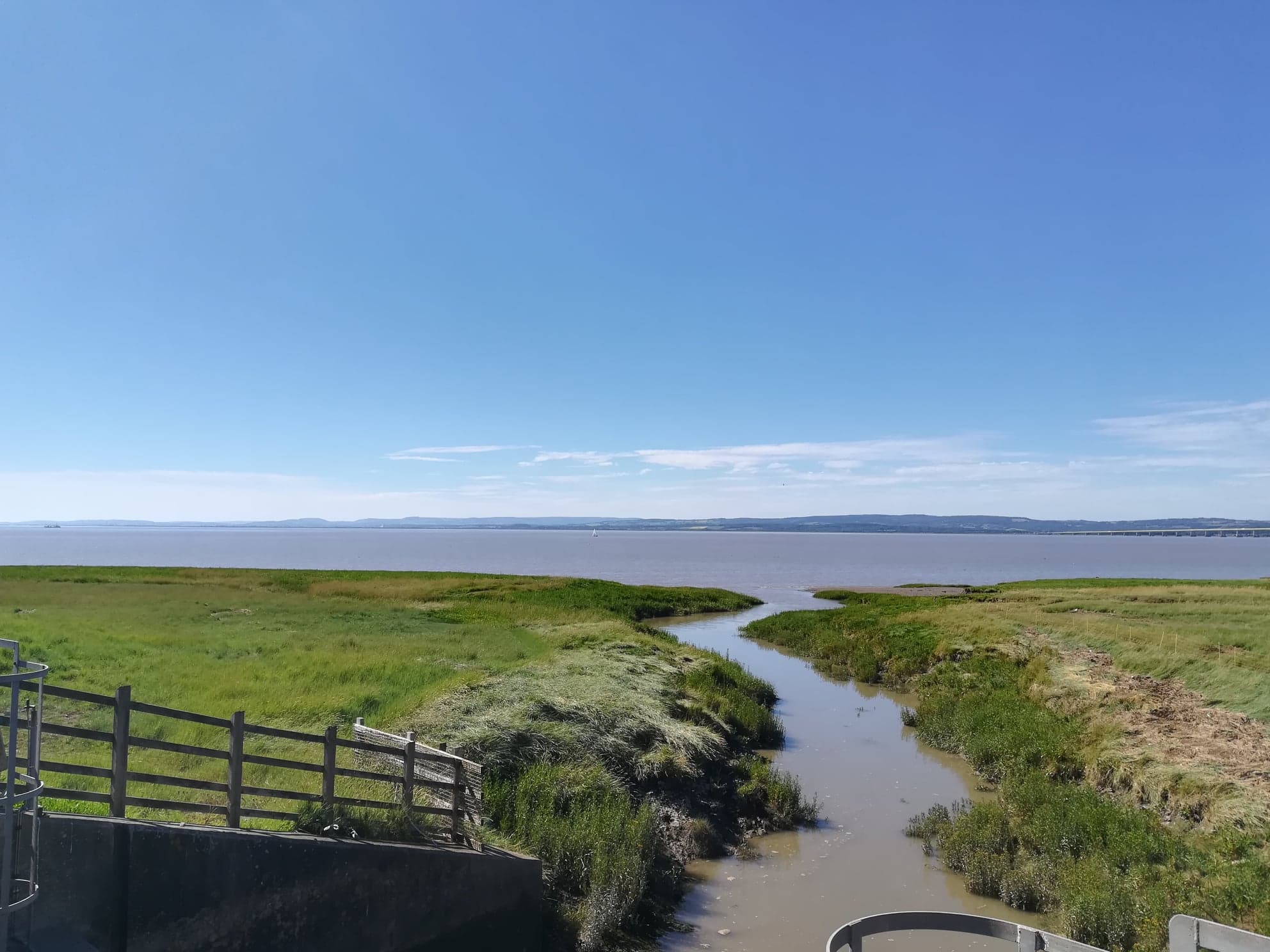
“This is an incredibly exciting opportunity to build on our long-standing work and take concrete steps toward securing the long-term health of the Severn Estuary,” said Alys Morris, SEP Manager. “We look forward to working with our partners and communities to deliver meaningful and lasting change.”
The Severn Estuary spans both England and Wales and is one of the UK’s largest estuaries, home to a vast range of wildlife, landscapes, and communities. As an independent, cross-border initiative hosted by Cardiff University, SEP is uniquely placed to coordinate action across local authorities, government agencies, businesses, and local people.
Dr Rhoda Ballinger, SEP Chair, highlighted the strategic importance of the project:
“This project reflects our continued commitment to collaborative, evidence-led action to support nature recovery and climate adaptation across the estuary. We are also actively seeking additional support to extend these efforts on the English side of the estuary and beyond.”
Andrew White, Director of The National Lottery Heritage Fund in Wales, noted:
“This latest round of awards demonstrates the ambition of the Nature Networks Fund and the importance of connecting people to the natural world on their doorsteps. We are proud to work alongside the Welsh Government and Natural Resources Wales to deliver a more resilient natural environment.”
The “Future Proofing the Severn Estuary” project contributes directly to the ambitions of the Severn Estuary Strategy (2017–2027), particularly in supporting ecosystem-based management, living within environmental limits, and using sound science to inform action.
For updates on this and other projects, follow the Severn Estuary Partnership on social media @SevernEstuary
What a Bore!
Written by Dr Rhoda Ballinger, SEP Chair
I witness a private viewing of our famous Severn Bore at Lower Parting where the Severn splits into two! This month, my article not only shares my experiences from my eventful day, but it also includes some of Stuart Ballard’s memories from his many years of surfing the Tide.
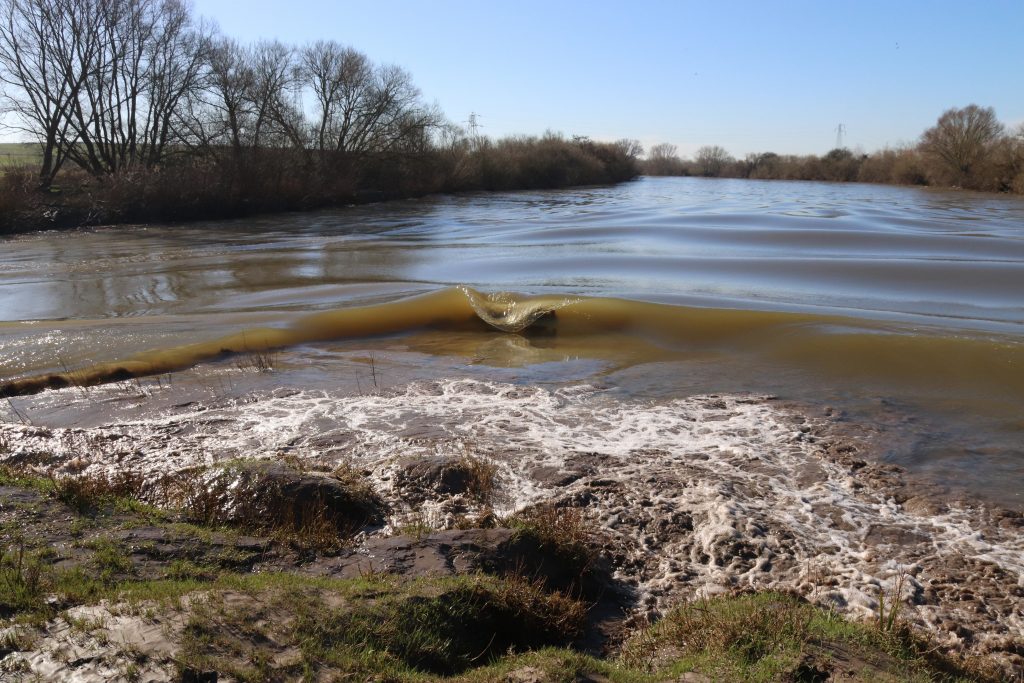
The bore arriving at Lower Parting, Alney Island
Introduction
Since discovering Alney Island on my walk at Gloucester in the autumn, I’d been keen to come back to explore this hidden gem further. Within just a few minutes’ walk from Gloucester Docks, you’re not only stepping onto one of Britain’s largest river islands but you’re also walking into a highly prized nature reserve which includes wet woodlands, marsh and pond habitats. I decided that Lower Parting, at the southern end of the island, would be a perfect place to view the bore. Inspired by the Welsh medieval monk Nennius’ text [The Wonders of Britain], the first written documentation of this natural phenomen, I was convinced that centuries of Severn folk, going as far back as the medieval monks of Gloucester, must have witnessed the bore from this very special vantage point, where the river splits into two.
An extract from Nennius’ medieval text, well over 1200 years old!
| Dau Ri Hafren – The Two Kings of the Severn ‘Two heaped-up wave crests .. Fight each other like rams. One goes against the other, and they clash in turn, and then one withdraws from the other, and they go forth again at each tide. This they have done, from the beginning of the world to this present day.’ |
An extract from Nennius’ medieval text, well over 1200 years old!
A 3* bore offering a ‘moderate’ bore ‘typically up to a metre’ and ‘a good spectacle’ on the 3rd March seemed an opportunity not to be missed. I did understand, though, that preceding meteorological and oceanographic conditions as well as the downstream river flows can modify the size and timing of the bore, so one might turn up and see very little. Anyway, with so few other high starred bores predicted this year, it was worth taking a chance. Geoff very kindly agreed to accompany me, as I’d been slightly perturbed by online discussions of previous walkers’ bovine encounters on the island and, after all, he’d introduced me to the Nennius text.
| What is a tidal bore? These natural phenomena can form as a rising tide forces water to funnel into shallow, sloping coastal inlets (or estuaries). As a tidal wave enters shallow waters, its wave height increases (due to refraction) and the wave travels inland, effectively reversing the river’s flow, sometimes for many miles inland. Bores peak around Spring tides near the vernal and autumnal equinoxes, when the tidal range is greatest. So, this year on the Severn there are only a handful of sizeable bores, even though the tidal river experiences bores twice a day on about 130 days. The speed and height of a bore are influenced by many factors, including wind speed and direction and the rate of flow of freshwater coming downstream. On the Severn, low pressure and south westerly wind are known to increase the size of the wave. |
Given my slight apprehension about a ‘no’ or ‘poor show’, I contacted Stuart Ballard, now part-time River Learning Engagement Officer with the Severn Rivers Trust, a surfing veteran of the bore and one of the famous Muddy Brothers. I vividly remembered Stuart taking me and the SEP team on a most interesting bore safari years ago, and recollected his enthusiastic presentation about bore surfing at a previous Severn Estuary Forum.
In anticipation
Having carefully negotiated the ‘path’ across the waterlogged meadows to the south of Alney Island, we finally arrived at Lower Parting. An empty wooden bench, perfectly positioned on the crest of the riverbank where the river divides into two channels, invited us to the 10:42 performance. Was this really going to be a private viewing? No need to battle through any crowds with over excited children and barking dogs this time. No cattle either (phew). But, goodness, had I got the right time, or even the right day? It was getting ever closer to the predicted time. Bores can even come earlier than predicted – but had we missed it even though we’d arrived 20 minutes early?
As if with no care in the world, the two arms of the river flowed gracefully past us, then merged without even a ripple before continuing downstream to caress the muddy shores of the tree-lined riverbanks beyond. Such a peaceful, rural idyll, with only the occasional long-tailed tit fluttering past and the gentle, distant warbling call of birds, may be skylarks.
Then, an almost eerie stillness and silence before…
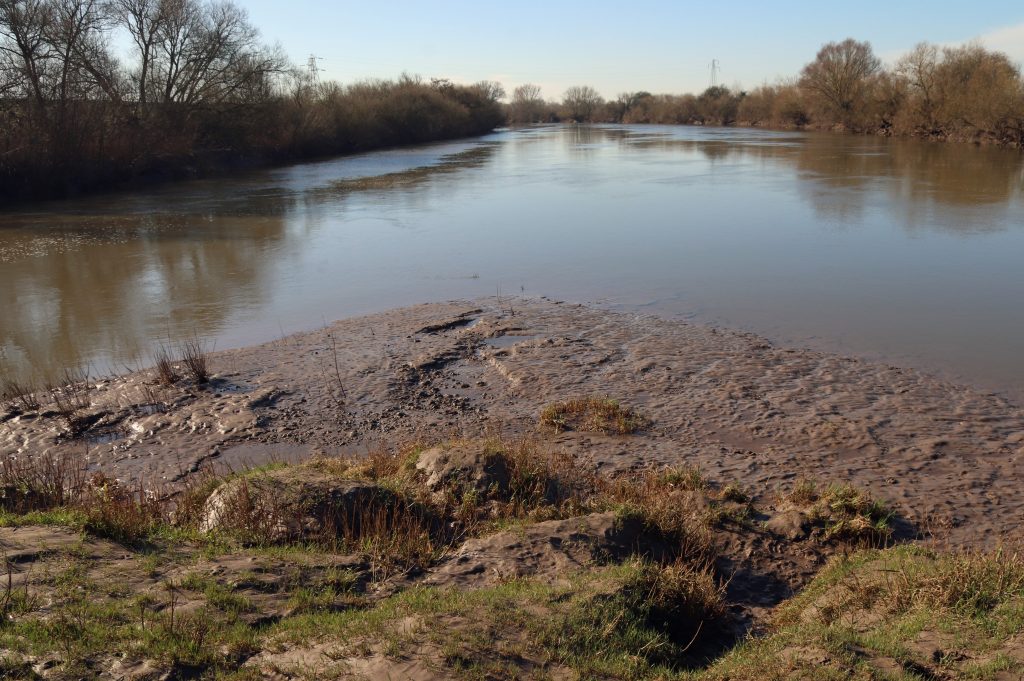
The muddy shores as the tip of Lower Parting
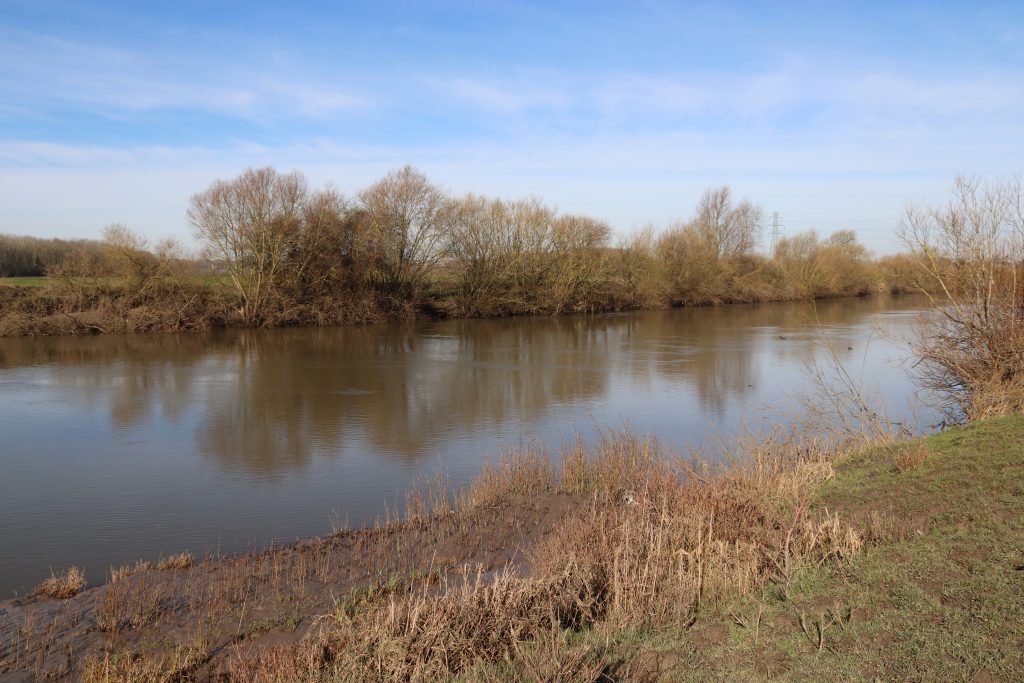
The Severn gently flowing downstream before the Bore
The spectacle
A faint swoosh.
Then, the swooshing became louder and louder.
And next, a small flick of white came into sight on the right bank of the river in the far distance.
Within seconds, it was as if an artist’s brush was outlining the riverbank with thicker and thicker strokes, almost dancing along the riverbank, until a white breaker became discernible. The wave rolled on and on, weaving and scouring its way along the bank, crashing into tree trunks and branches. The mallard ducks, which had been gliding so peacefully along the river, initially seemed unperturbed by the approaching wall of white water until, almost engulfed by the spray, they took flight.
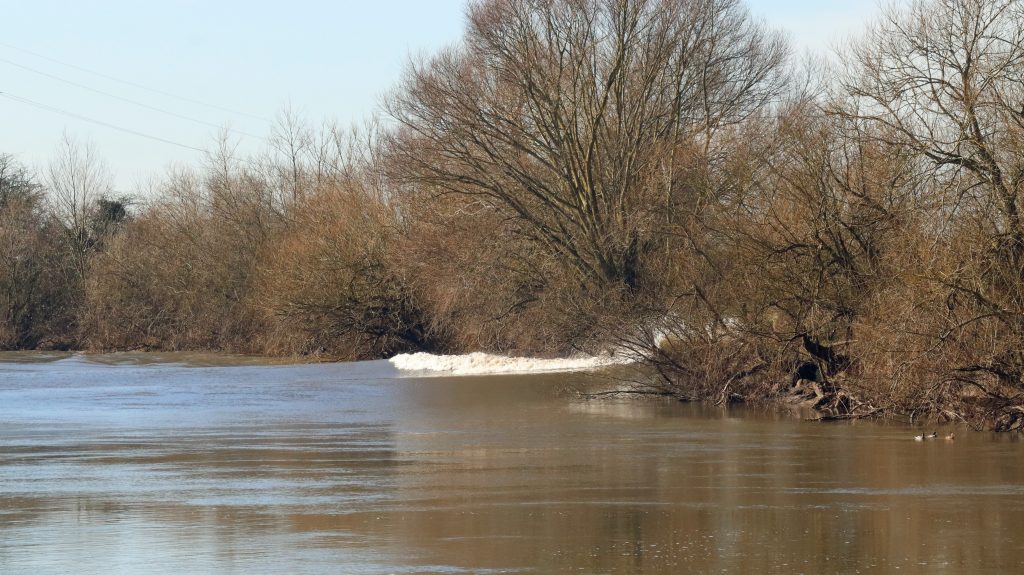
Mallard ducks unperturbed by the approaching bore
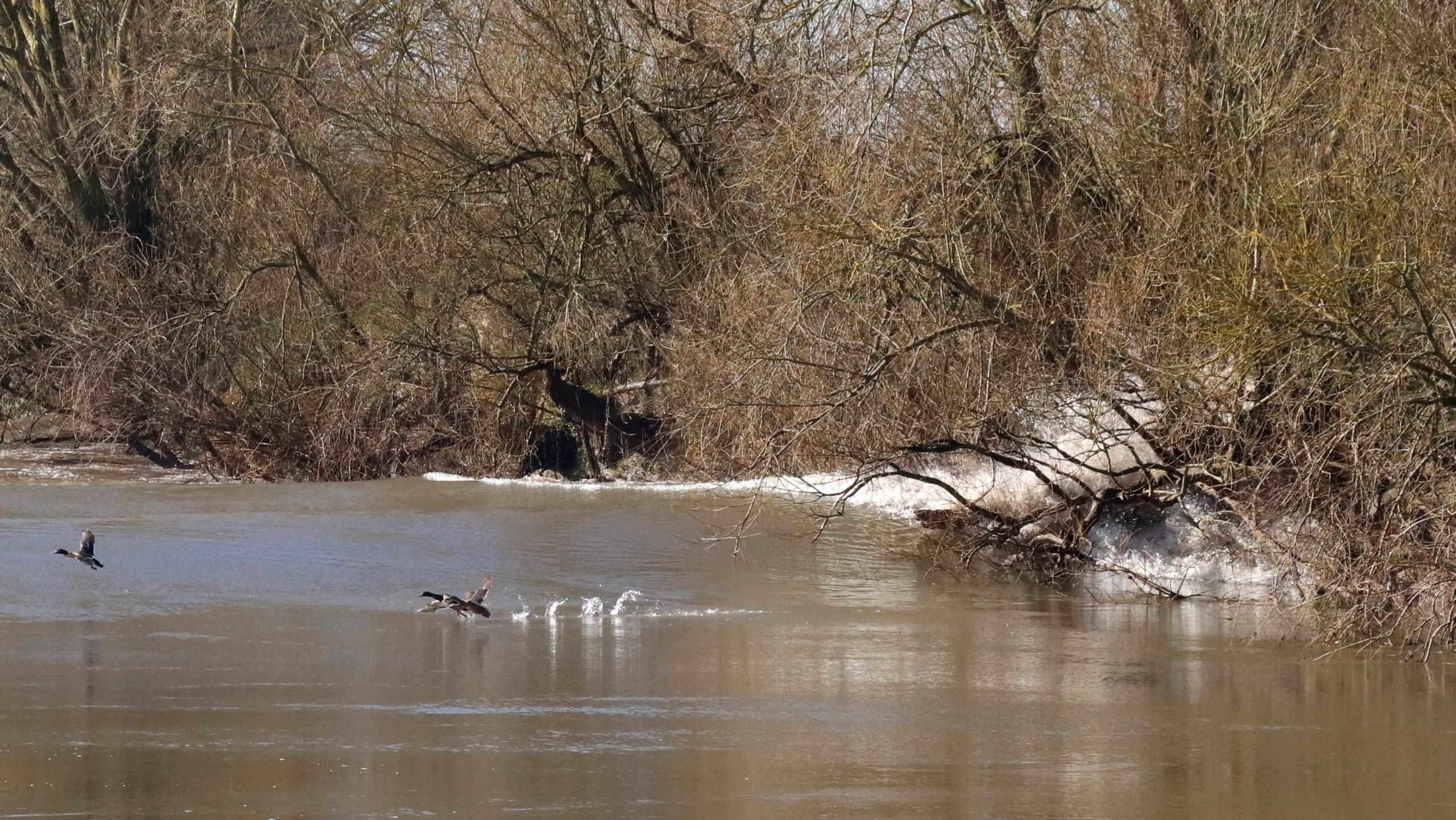
Mallard ducks taking flight at pace at the fast approaching tidal wave
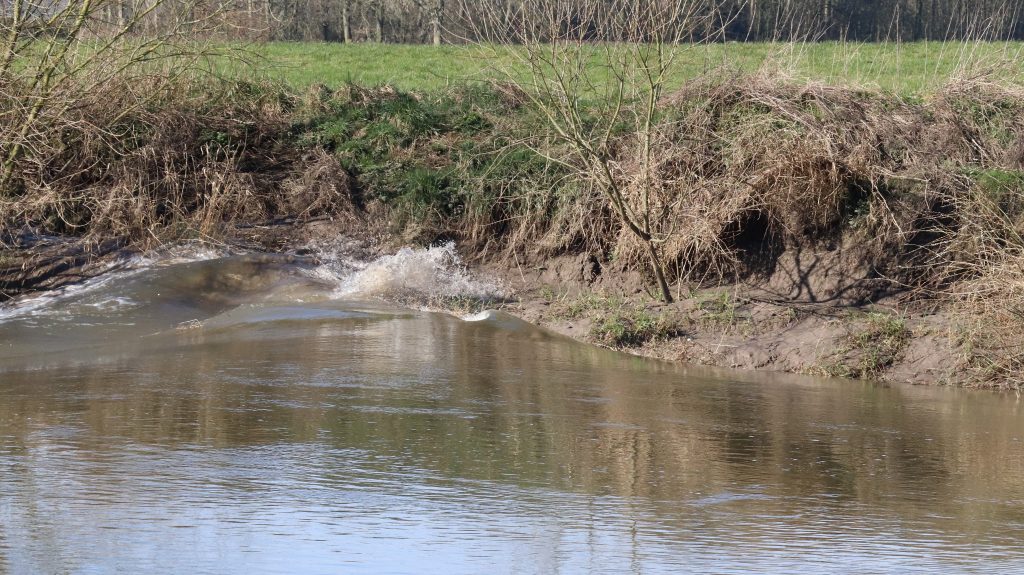
The bore progressing along the left bank
The show continued. We were suddenly aware of yet another wave meandering its way a little more nonchalantly along the other, inner left bank. This was just like Nennius had described all those centuries ago, although the rams seemed more at peace today than in his description.
And then, the most impressive spectacle of all. The bore broke on the tip of the muddy shore at Lower Parting just in front of us, creating a delightful spray fountain. There followed an unexpected performance from the secondary waves, the whelps. Looking like a series of folds in a velvet gown as they approached, each of these smooth, sleek waves broke gracefully over the previous one in almost slow motion, each drowning more and more of the steep muddy bank below. Very soon the steep bank had been consumed by the frothing waters and there was only swirling chocolate brown, muddy water in front of us.
I hope the following sequence of photos gives you a reasonable impression of this amazing piece of choreography.
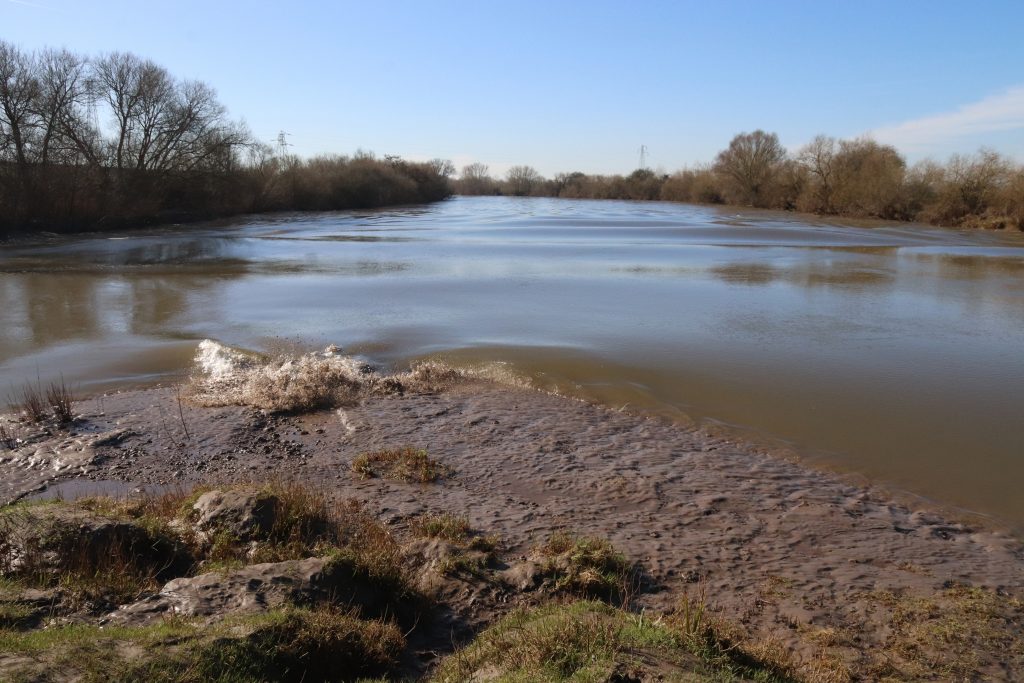
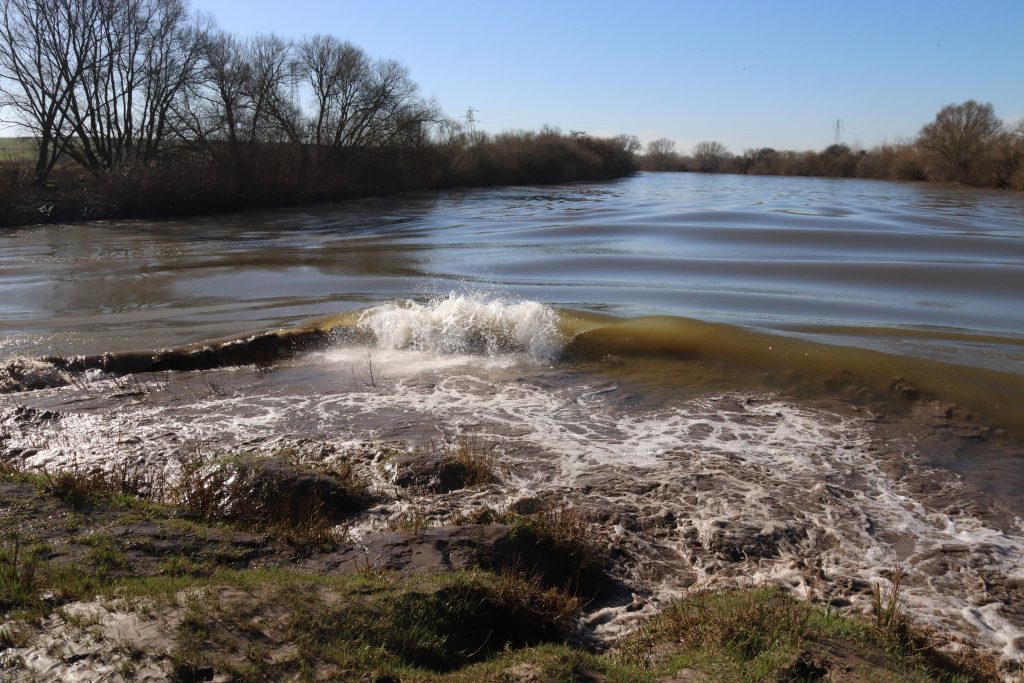
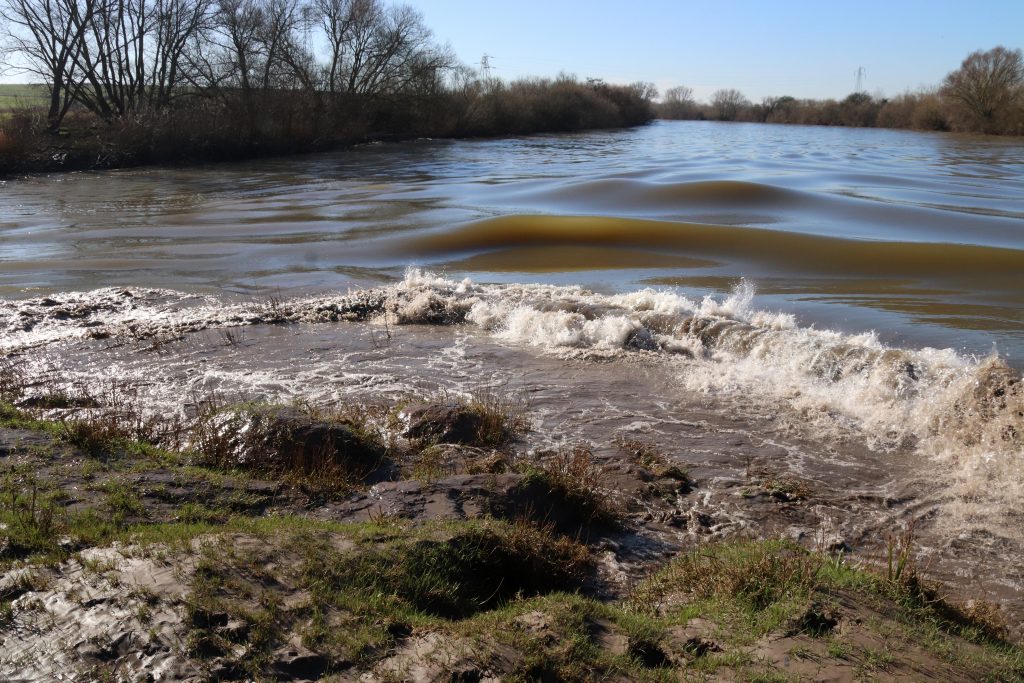
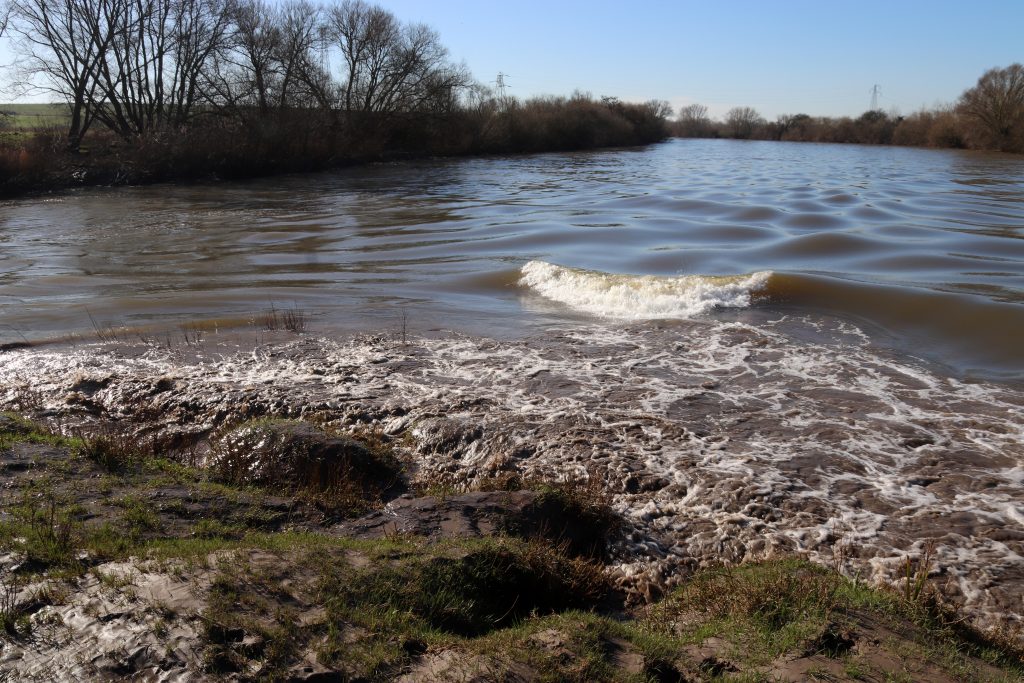
The bore’s display at Lower Parting
The aftermath
The show was over, or was it?
The riverbanks and reeds were submerged but still the tide remained in control, flowing steadily upstream and carrying flotillas of debris with it. Pleasingly, given the amount of litter I’ve seen on previous walks, there was relatively little plastic amongst these floating forests. However, driftwood in many shapes and sizes, from crocodile and alligator to otter lookalikes, surged past. Later, I found the following extract from a poem by Duncan Forbes which describes the scene so well:
Shipping the driftwood back upstream
With smells of estuary and reeds,
It fills the channel like a reen
And still the water levels rise
(Source)
By now, the river was nearly at ‘bank full stage’ – and the muddy reed beds of the riverbanks were practically submerged. The water had even started to encroach into the woodland along the banks. In the slightly hazy spring sunshine, it was as if I’d entered the world evoked by Debussy’s impressionistic piano piece Reflets dans l’eau (Reflections in the Water). In and amongst the picturesque reflections, the waters were almost dancing – amazing ripples were forming around bubbling ‘cauldrons’ of water: steady streams of air bubbles were being released, presumably remnants from the bore’s previous disturbance?
And still the waters kept rising.
After all, these are flood meadows, flat pastureland that owes its existence to natural fluvial processes. The West Channel which we were walking along was, I understand, formed by a major flood event centuries ago. As we watched the ancient drainage ditches filling up, I remembered the warnings on the information boards nearby – the river continues to rise for well over an hour after the Bore. Time to beat a hasty retreat. Not so easy though. It was getting increasingly difficult to tread across the heavily trampled, pock-marked sea of sticky mud. Then the inevitable – my walking boot became firmly stuck…I’ll spare you the details, but suffice it to say, I’ve still got a broken fingernail from prizing my boot out, but, at least after a 50° wash cycle, my sock has recovered from its mud bath. What could have been a therapeutic, tactile experience of mud walking, became a logistical nightmare, avoiding the many mighty ziggurats of cow dung strewn across the meadow. At least we didn’t encounter the cattle themselves, although I would quite like to have seen (from a distance) some of the traditional Old Gloucester breed whose milk is used to make the famous Single and Double Gloucester cheeses.
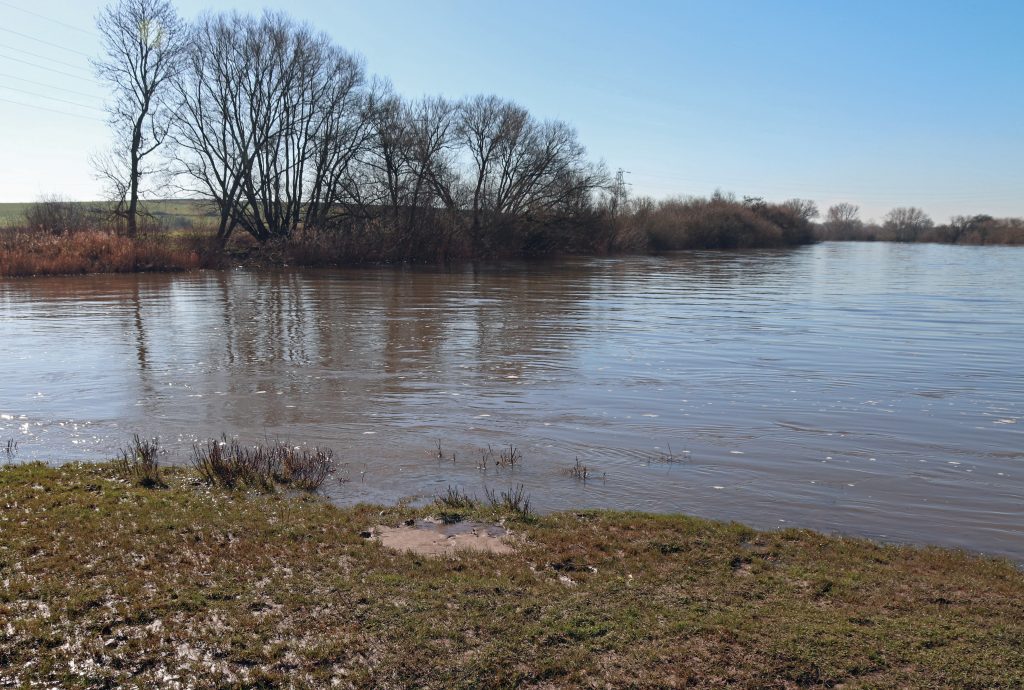
Lower Parting immediately after the Bore
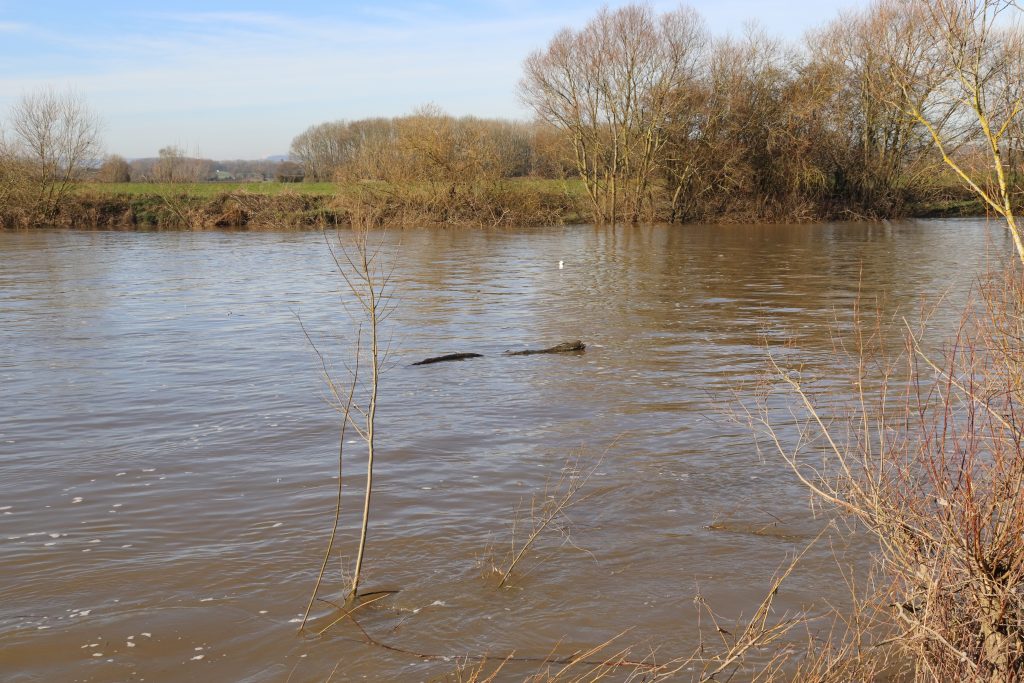
A driftwood ‘crocodile’ floating upstream in the now swollen river
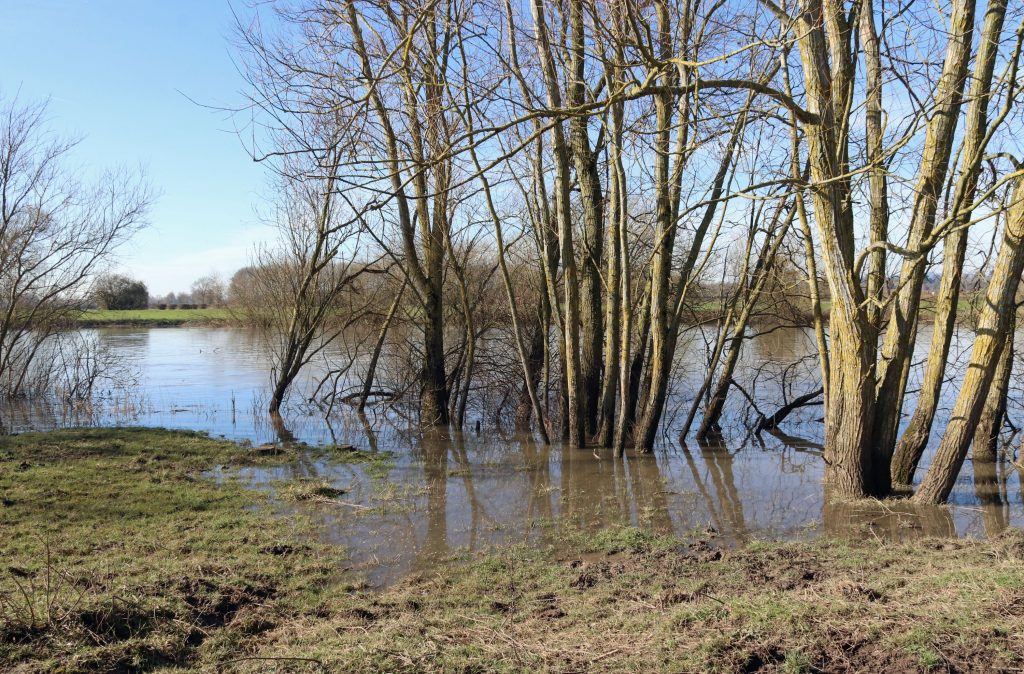
Submerged woodland along the river
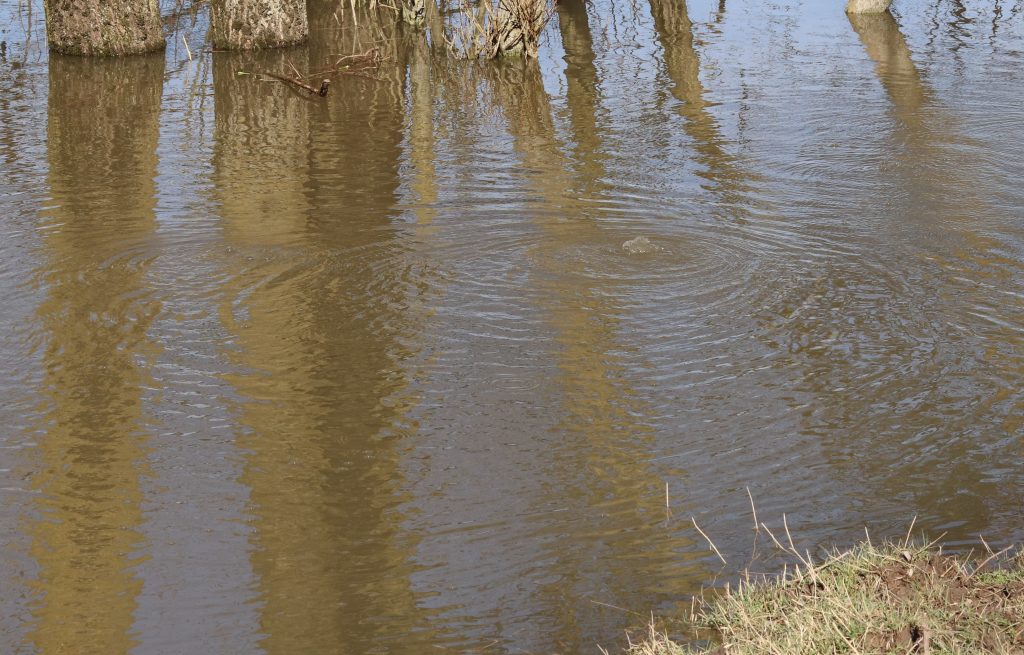
Bubbling waters on the edges of the submerged woodland
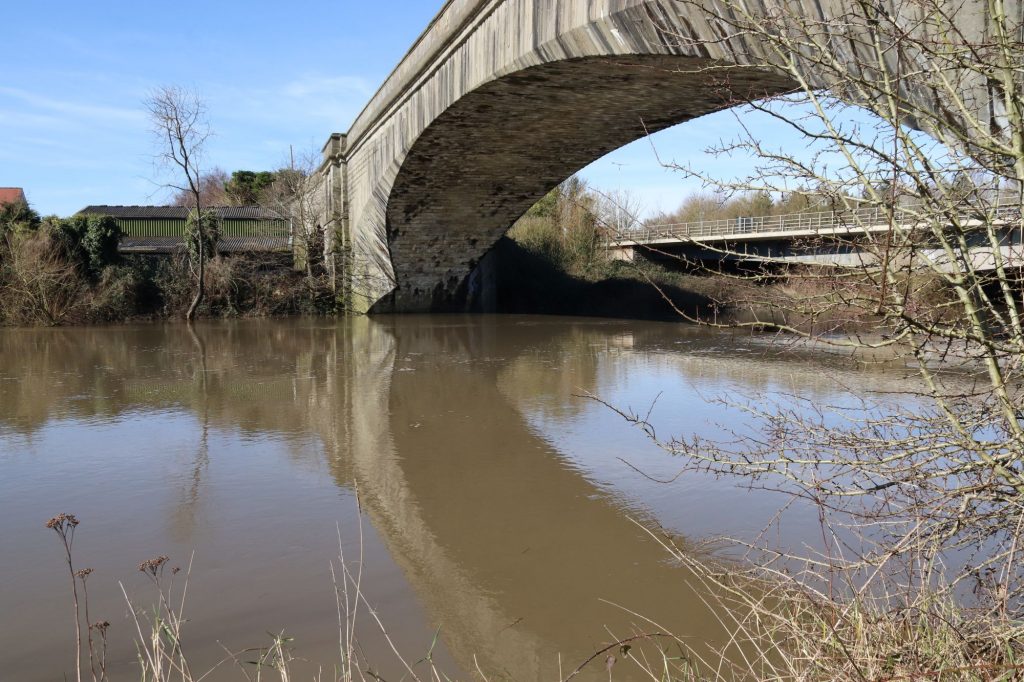
Over Bridge – the elegant stone arches of Telford’s bridge
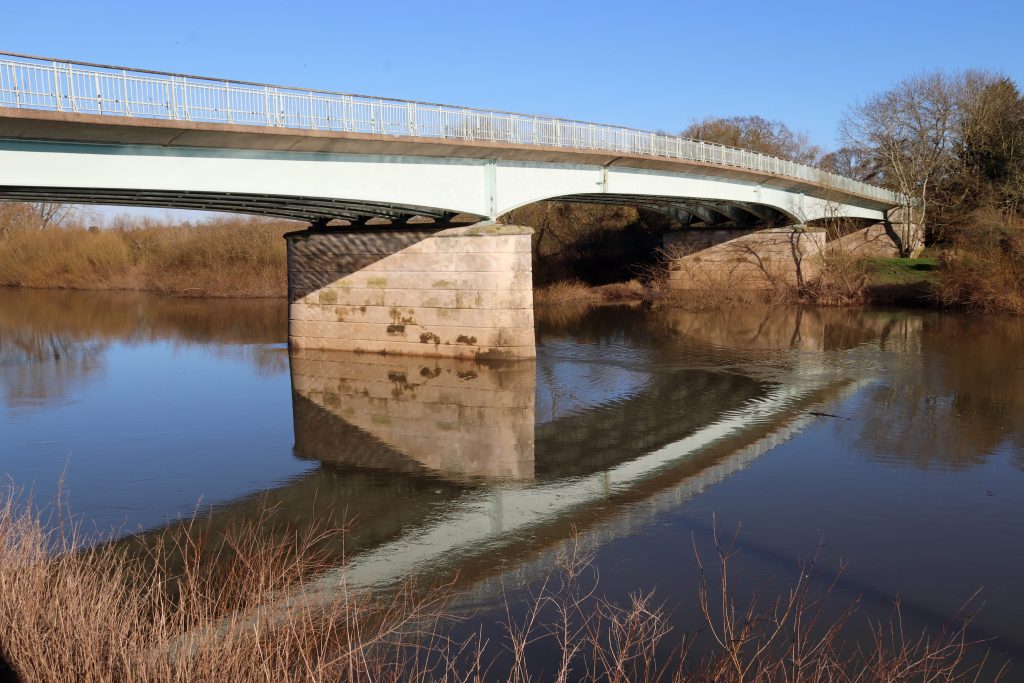
Haw Bridge
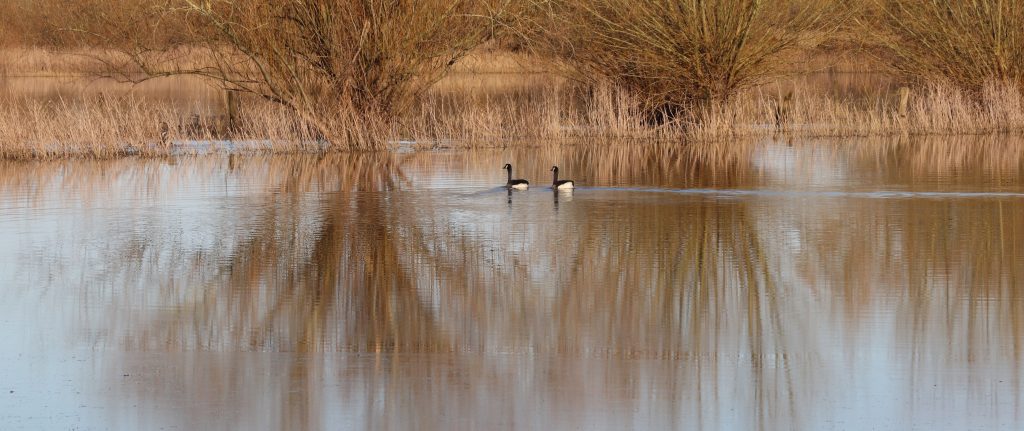
A pair of geese gliding across one of the many pools of the Ashleworth Ham Reserve
Beyond the Bore
I was so relieved to get to the dry, tarmac path that leads you under Over Bridge, from the top of which I later discovered you get a splendid bird’s eye view of the river without having to negotiate either cattle or mud! The bridge, sometimes known as Telford’s Bridge, is quite special. This elegant bridge was the lowest river crossing on the Severn for over a century until the opening of the Severn Bridge in 1966. It’s main claim to fame though is its design – by Thomas Telford of course. It employs a French ‘cornes de vache’ technique; the horn shaped cut outs on the bridge designed to reduce turbulence and increase water flow at times of flood.
After a quick change of socks and shoes, we warmed up with a hearty lunch at a nearby farm shop café. I was, however, still keen to briefly explore the river up to Haw Bridge, the inland limit of our Severn Estuary Shoreline Management Plan and SEP itself. So, we took a rapid detour by car to sample a few sites upstream before heading home. Haw Bridge itself is somewhat unremarkable, a modern 1960s bridge which replaces a former structure demolished by an empty tanker barge heading downstream. No major disasters on our visit today. By now the river had reverted to flowing downstream and seemed well behaved, even demure, certainly not the ‘naughty adolescent’ as described by Chris Witts. However, despite the somewhat idyllic river scene before us, there was plenty of evidence of previous flooding and high tides – sandbanks piled high along the road in front of the pub, and floating pontoons for the canoeists needing to avoid the steep muddy riverbanks.
Returning towards Maisemore, the normal tidal limit of the Severn, we happened to pass by Ashleworth Ham Reserve, a wonderful wetland which serves as an active floodplain during winter. Although only a remnant of a more extensive wetland landscape, it’s an important bird habitat, with Bewick’s swans and white-fronted geese as regular visitors. On even our brief encounter, we caught a glimpse of various geese, coots, mallards and common pochards.
Our final stop – Maisemore and Upper Parting, at the northern end of Alney Island. The weir at Maisemore is notable as it forms a barrier to the upcoming tides. Stuart thinks that you get one of the best views of the bore here and has even seen footage of the rare Twaite Shad doing their spawning dance at this location. He informs me that it’s quite an odd spectacle seeing the bore ‘smashing against the weir’ before a rebound wave tumbles back downstream against the flow of the incoming tide. Several hours after the bore today, however, it was business as usual with the river flowing downstream. So, another future visit perhaps? Today, after a short walk to Upper Parting it really was time to go home!
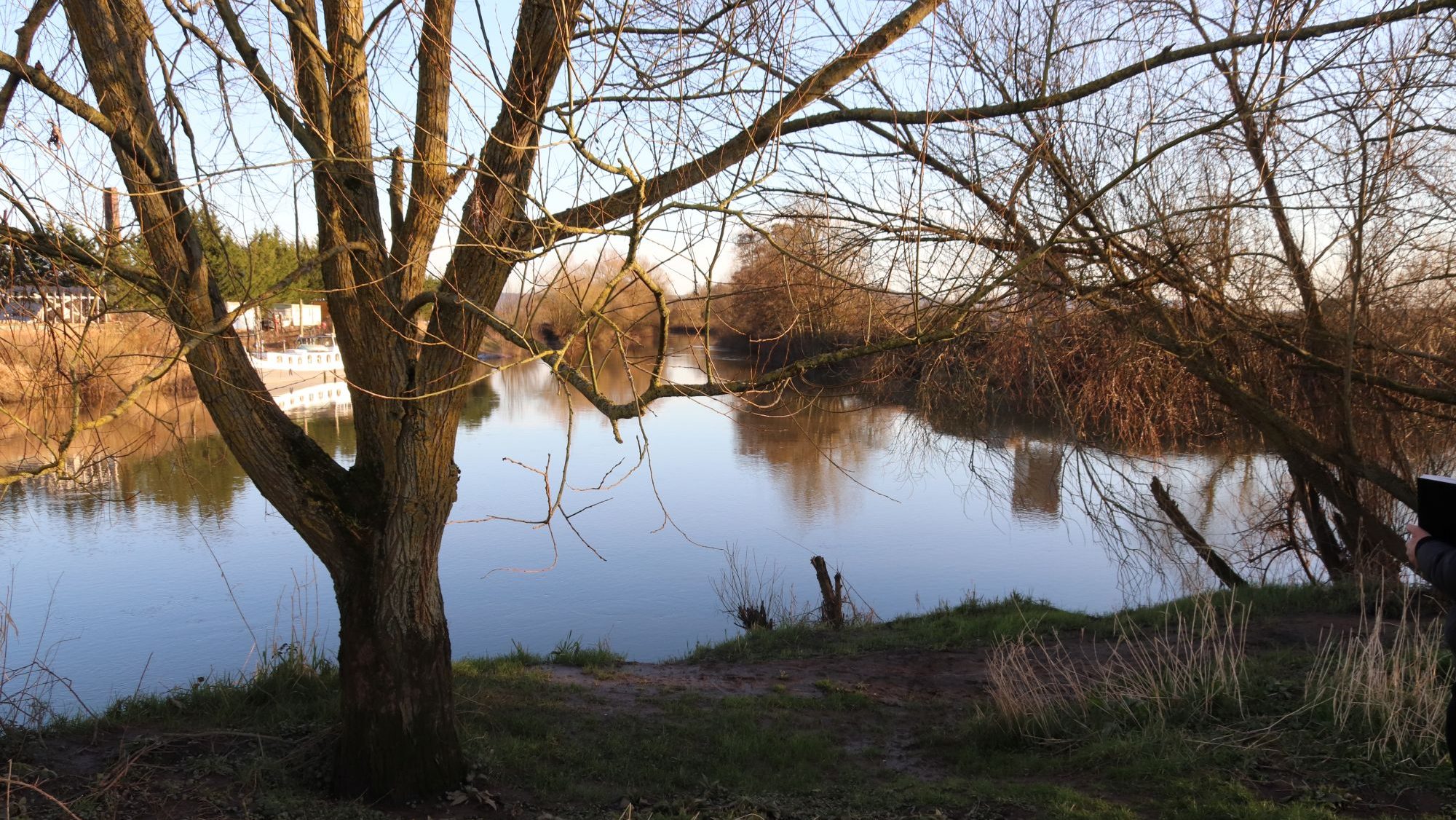
Upper Parting with the east and west channels of the Severn
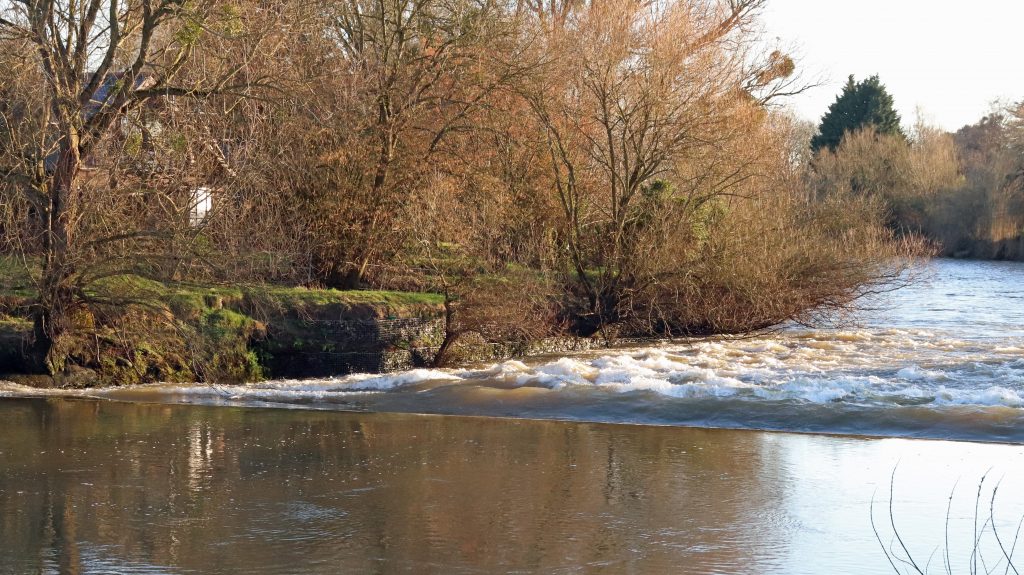
Maisemore weir – the normal tidal limit and upstream limit for the bore
Further bore memories – from Stuart’s bore surfing experiences
I’m so delighted to be able to share a few more memories from Stuart. His tidal surfing adventures have taken him across the world, including to the Benak bore in Borneo where he and other surfers were paraded like gladiators in front of a crowd of no less than 50,000. Why? The river was home to real crocodiles, not like the driftwood ones we’d seen on our bore visit!
I asked Stuart what was so special about the Severn Bore. His reply ‘the great connection with the movements of the solar system as the bore is created by interplay of gravitational forces between the Sun and the Moon…we surf on gravity waves…up the river that flows backwards.’ That sense of connection with something much greater was something we’d also felt even though we’d only passively watched the bore fly by. His most special memory? Well, it had to be ‘surfing along near Newnham with a Harbour Porpoise following me in the incoming tide.’ Or may be ‘surfing past John Powell’s salmon putcher rank at Broadoak when a Grey Mullet leapt out of the roaring tide and landed across my feet in the sunset.’ Stuart was also keen to stress that surfing the bore had given him a ‘connection with the wild nature of place and people’ which ‘had been tangible’. This, he enthusiastically explained, ‘includes the heritage and history of folk living along the river, “the long-village”, as one of the Salmon putcher fishermen called it. ‘Getting to know the Elvermen, the cider makers, surfers and the creative communities has been actually heaven!’ he remarked. Hopefully, I’ll get to know meet some of these stars of the Severn in future walks.
Stuart does admit ‘The tide did take over my life.’ He also stresses how you need to ‘understand just how long the rides can be to understand bore surfing’. He’s proud of his longest single ride of 3.3 miles, and that of his friend, Steve King who ‘holds the record for a standing ride of over 10 miles that took over an hour to complete.’
Surfing the Severn certainly does seem quite an experience. Stuart encourages us to ‘imagine catching one wave that lasts for 20+ minutes rather than the mere seconds one would expect from a wave at the beach’ and ‘how your legs would ache after that!’ He explains ‘this wave would then be carrying you for a journey upriver and inland, past churches, villages, cows, fields, cliffs, under bridges and past pubs. All this with and incredible community of local surfers that has become the ‘Bore Riders Club’, and sometimes hundreds of visiting surfers’. He points out that ‘The Springtime tides can be like a great festival’ and he’s even seen ‘people preparing champagne breakfast on the bank in the Spring sunshine surrounded by apple blossom’. Not Glyndebourne, but clearly an important cultural experience for the Lower Severn communities.
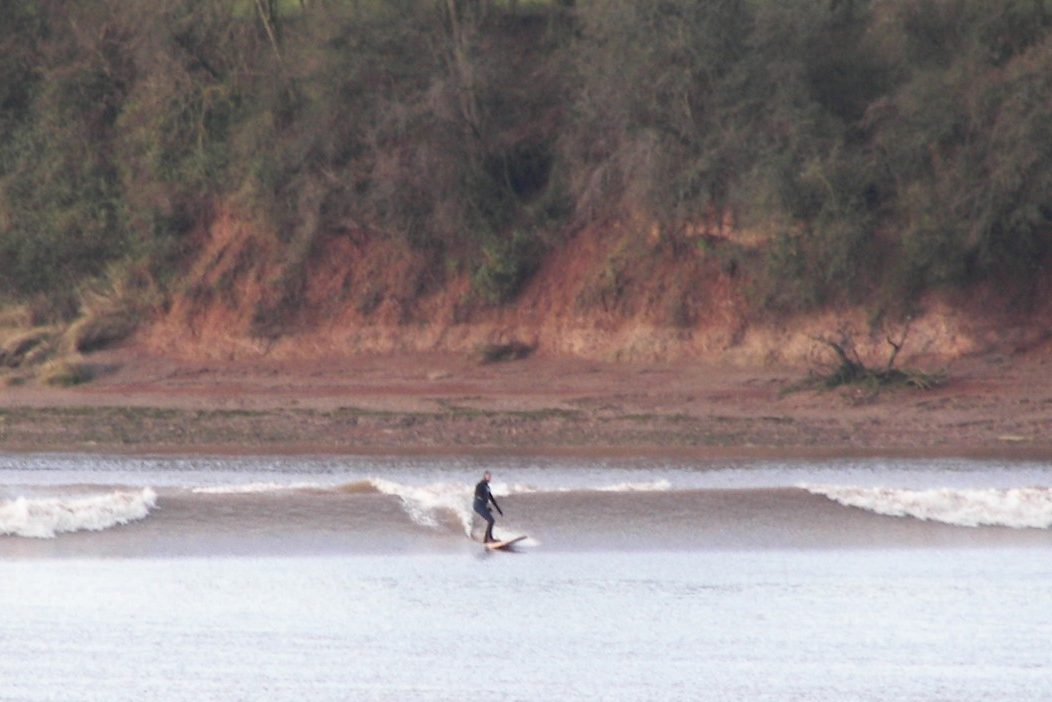
Stuart surfing a cold winter Severn Bore near Arlingham – ‘it’s unusual to have the wave to one’s self!’23/1/2007. Credit Neil Law.
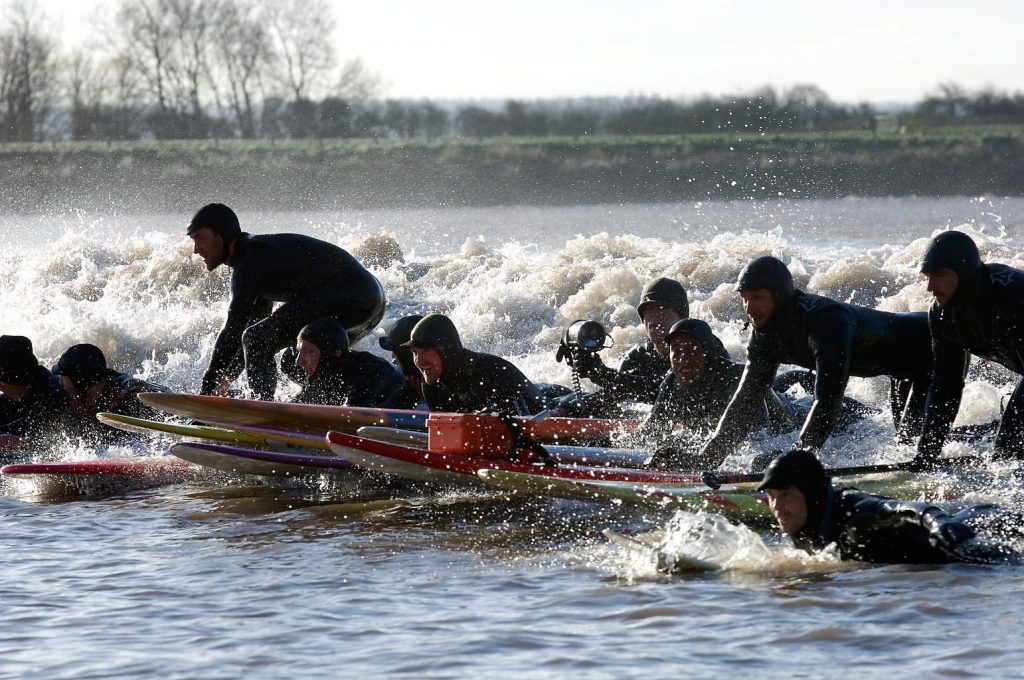
What an atmosphere as surfers flock to the big tides to ’tick off’ their bucket list (21/3/2007) Credit Mark Humpage
Final thoughts
Reflecting on my experiences and on Stuart’s stories which reveal both a passion and an intimate understanding of our tidal river, the Bore is truly one of Britain’s natural treasures. I’m not at all surprised that it was a much celebrated ‘ancient wonder of the British Isles’ in medieval times. Even today, and perhaps especially today, there are few places and times when you can feel so much ‘at one’ with nature and the wider solar system. The bore delivers this and more. With large-scale development proposals and shoreline modifications further downstream does it deserve further protection? Indeed, a recent academic study underscores the need for careful planning in tidal energy development within the Estuary (Source), suggesting that a 1.5 m drop in mean water level could result in a 15 km retreat of the bore.
Whilst the Bore is clearly still culturally significant to the river communities of the Lower Severn, beyond that, perhaps it’s considered a mere quirk. It’s the largest bore in the British Isles but how many people from the cities and towns around our estuary are aware of its existence, never mind have come to see it? Perhaps we need another Magnificent Severn Festival like the one Stuart helped organise back in 2009/10 to help raise its profile. Or even perhaps a new name? After all many of the bores Stuart has surfed elsewhere have names, the ‘Mascaret’, on the Dordogne and Garonne, and the fearsome ‘Pororocca’ on the Amazon. There’s even the infamous ‘Silver Dragon’ on the Qiantang River in China, the world’s largest bore which reaches a staggering 9 metre height.
Beyond considerations of just the bore itself, I’m aware of the need to continue to manage the increasing pressures on the river and its associated flood plains both here and further upstream. It’s great to see the work of the Severn Rivers Trust (which Stuart helped establish), which adopts a catchment-based approach, in line with SEP’s vision, as well as the efforts of more local groups, such as the Friends of Alney Island. With future climate change predictions, we certainly will need a resilient river system and such endeavours need our support.
Finally, I hope you’ve enjoyed reading this article as much as Stuart and I have reflecting on our various experiences. I hope it’s also encouraged you to get out there and watch a bore for real.
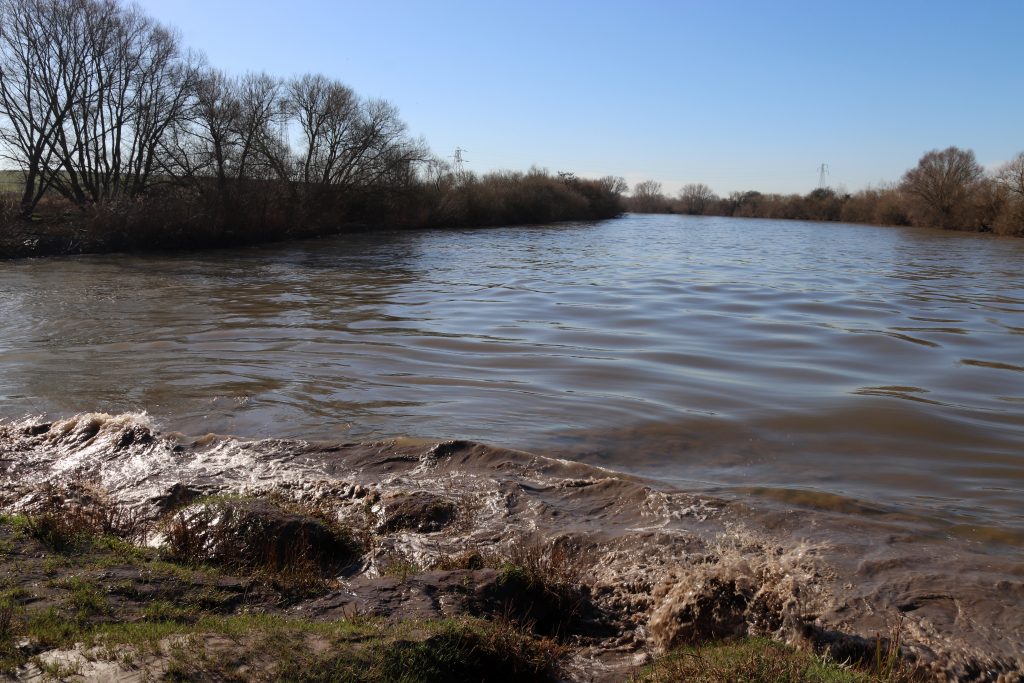

A few websites and references
Bore websites:
Boring facts on the Severn Bore
Top Viewing Locations for the Severn Bore
Gloucester Harbour Trustees (2007) Safety Guidance for Surfers, Canoeists, Small Craft and River Bank Users in the Upper Severn Estuary (Source)
The Severn Bore tidal wave – Drone footage and tide timelapse
Surf Simply – Surfing The Severn Bore: The Muddy Brothers and Their Memories
Che, B., Hu, H., Ma, J. and Liang, D., 2024. Hydrodynamic Modelling of Severn Bore and Its Dependence on Ocean Tide and River Discharge. Journal of Marine Science and Engineering, 12(12), p.2319.
Other related topics:

Severn Tidings 2024/25 – Celebrating 30 Years of Partnership
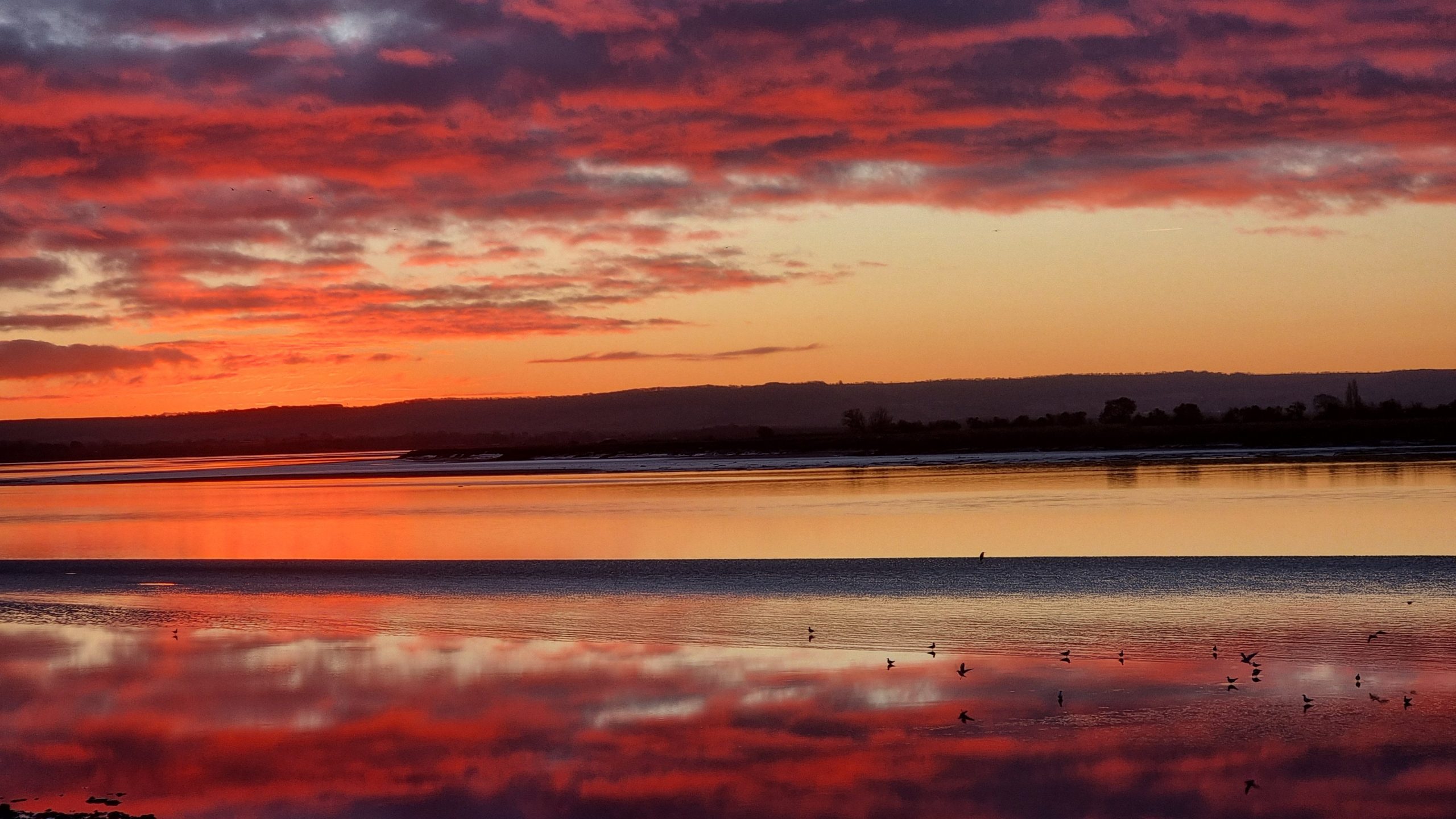
The Latest Issue of Severn Tidings is Here!
We’re excited to announce the release of Severn Tidings 2025! This special 30th-anniversary edition celebrates the Severn Estuary Partnership’s work over the past three decades, featuring:
- Photo of the Year – A breathtaking winter sunrise over the Severn
- SEP Updates – Our new Severn Estuary Biosecurity Plan
- Bird Aware Severn – Protecting vital habitats for migratory birds
- Litter Free Coast & Sea – Reflecting on nine years of work in Somerset
- Saltmarsh Restoration & Climate Adaptation – Groundbreaking projects for a resilient future
 Severn Estuary Partnership
Severn Estuary Partnership